Investigating Pay, Pension, and Rewards for Employee Satisfaction
VerifiedAdded on 2023/06/08
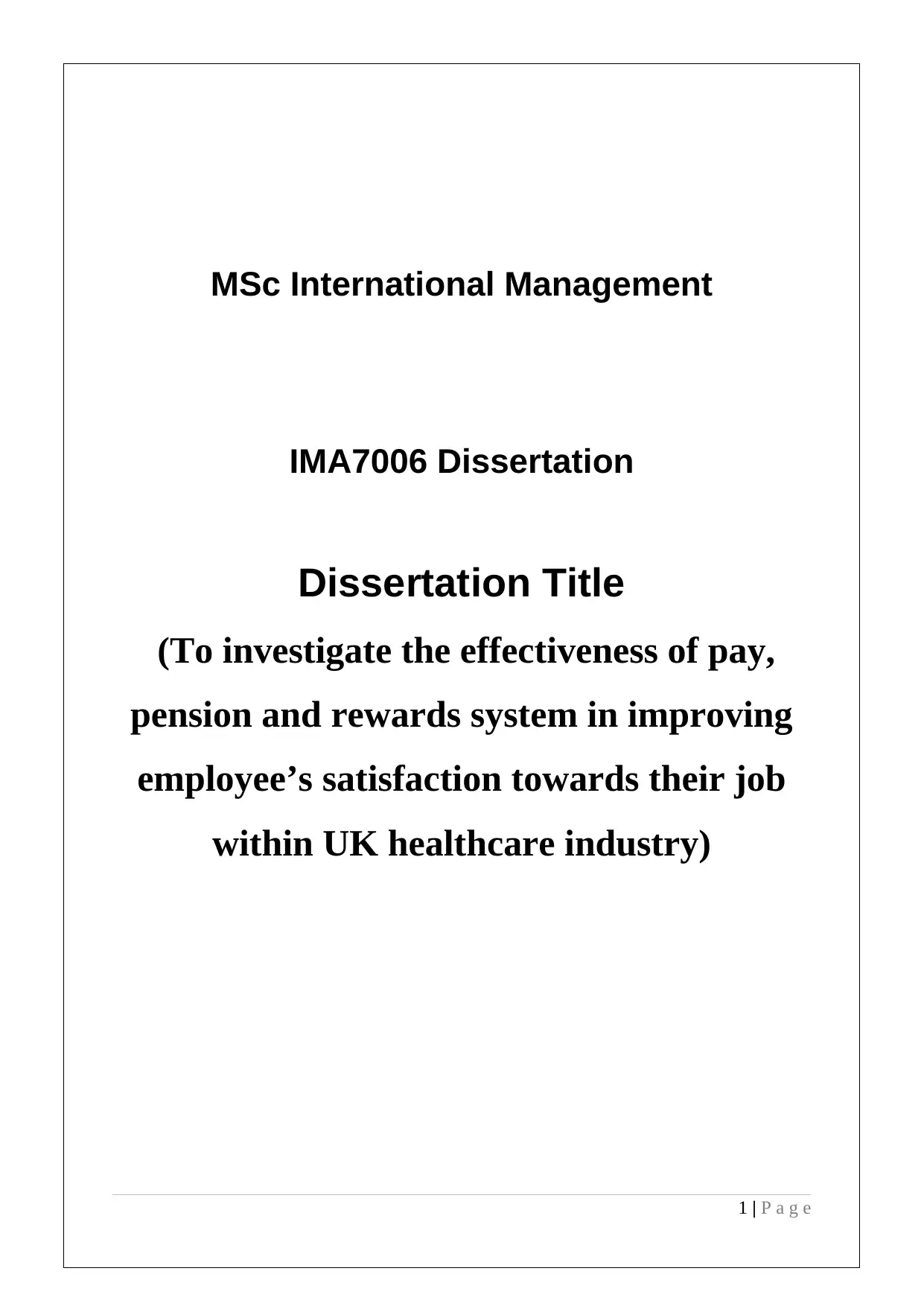
IMA7006 Dissertation
Dissertation Title
(To investigate the effectiveness of pay,
pension and rewards system in improving
employee’s satisfaction towards their job
within UK healthcare industry)
1 | P a g e
Paraphrase This Document
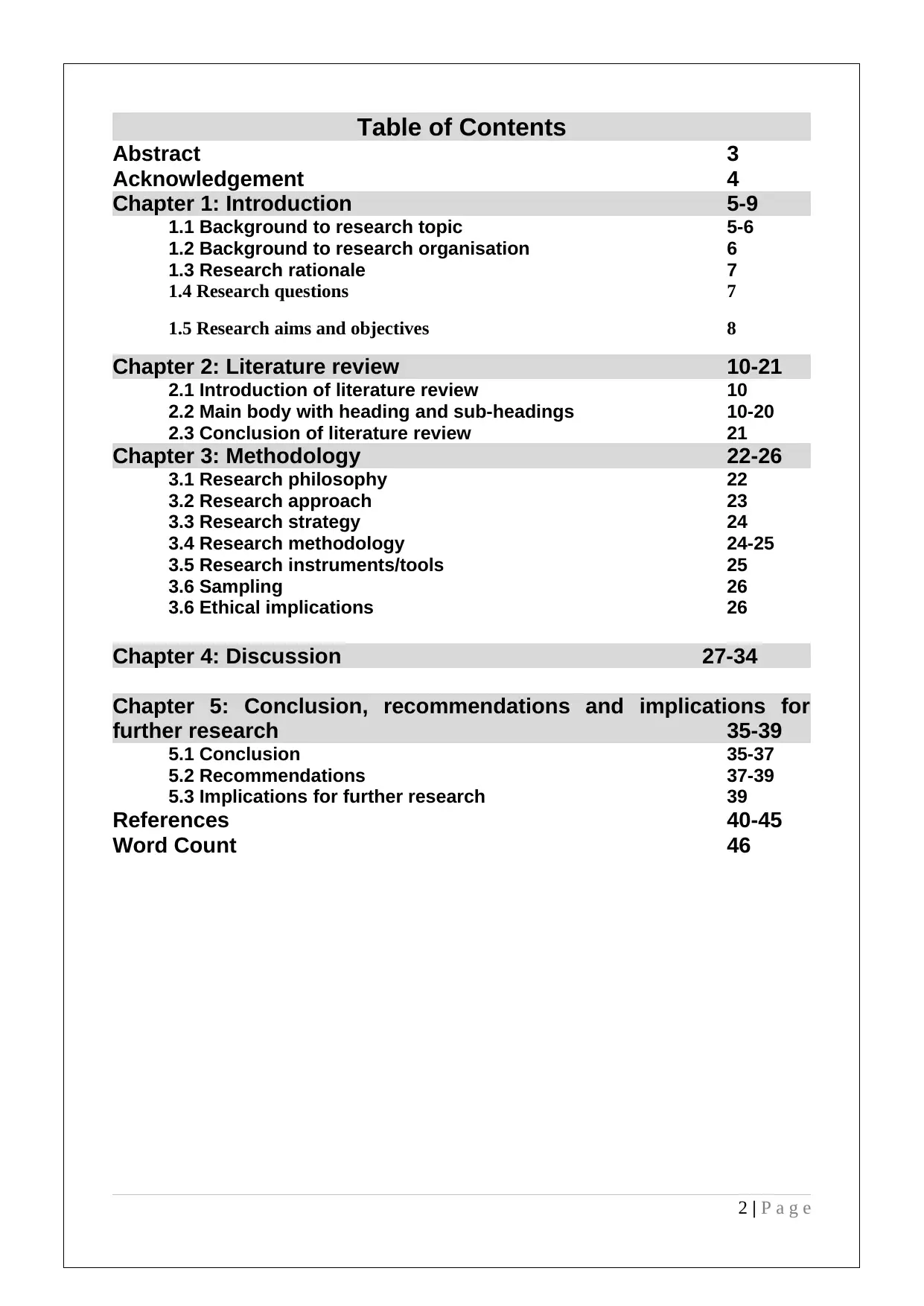
Abstract 3
Acknowledgement 4
Chapter 1: Introduction 5-9
1.1 Background to research topic 5-6
1.2 Background to research organisation 6
1.3 Research rationale 7
1.4 Research questions 7
1.5 Research aims and objectives 8
Chapter 2: Literature review 10-21
2.1 Introduction of literature review 10
2.2 Main body with heading and sub-headings 10-20
2.3 Conclusion of literature review 21
Chapter 3: Methodology 22-26
3.1 Research philosophy 22
3.2 Research approach 23
3.3 Research strategy 24
3.4 Research methodology 24-25
3.5 Research instruments/tools 25
3.6 Sampling 26
3.6 Ethical implications 26
Chapter 4: Discussion 27-34
Chapter 5: Conclusion, recommendations and implications for
further research 35-39
5.1 Conclusion 35-37
5.2 Recommendations 37-39
5.3 Implications for further research 39
References 40-45
Word Count 46
2 | P a g e
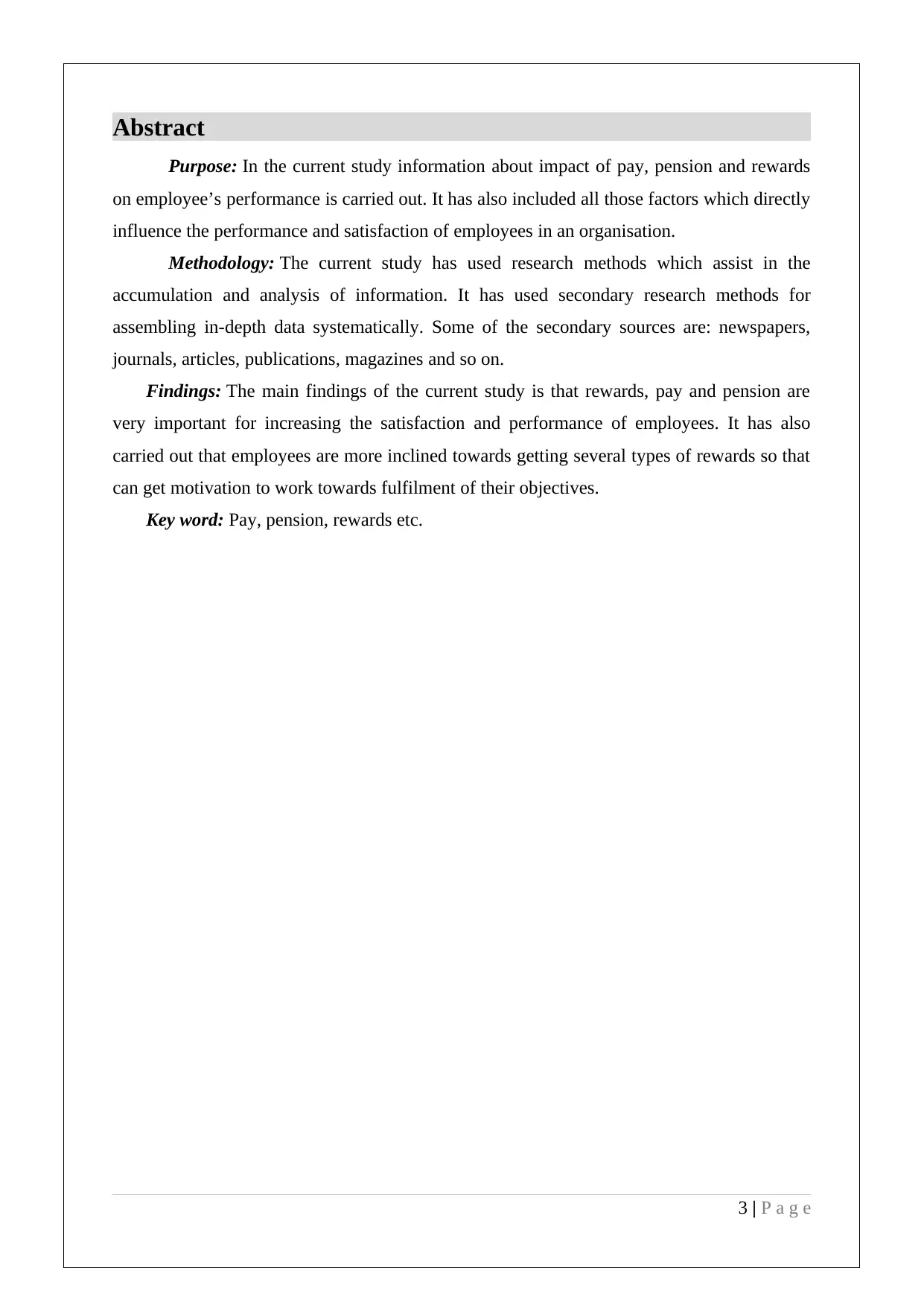
Purpose: In the current study information about impact of pay, pension and rewards
on employee’s performance is carried out. It has also included all those factors which directly
influence the performance and satisfaction of employees in an organisation.
Methodology: The current study has used research methods which assist in the
accumulation and analysis of information. It has used secondary research methods for
assembling in-depth data systematically. Some of the secondary sources are: newspapers,
journals, articles, publications, magazines and so on.
Findings: The main findings of the current study is that rewards, pay and pension are
very important for increasing the satisfaction and performance of employees. It has also
carried out that employees are more inclined towards getting several types of rewards so that
can get motivation to work towards fulfilment of their objectives.
Key word: Pay, pension, rewards etc.
3 | P a g e
⊘ This is a preview!⊘
Do you want full access?
Subscribe today to unlock all pages.

Trusted by 1+ million students worldwide
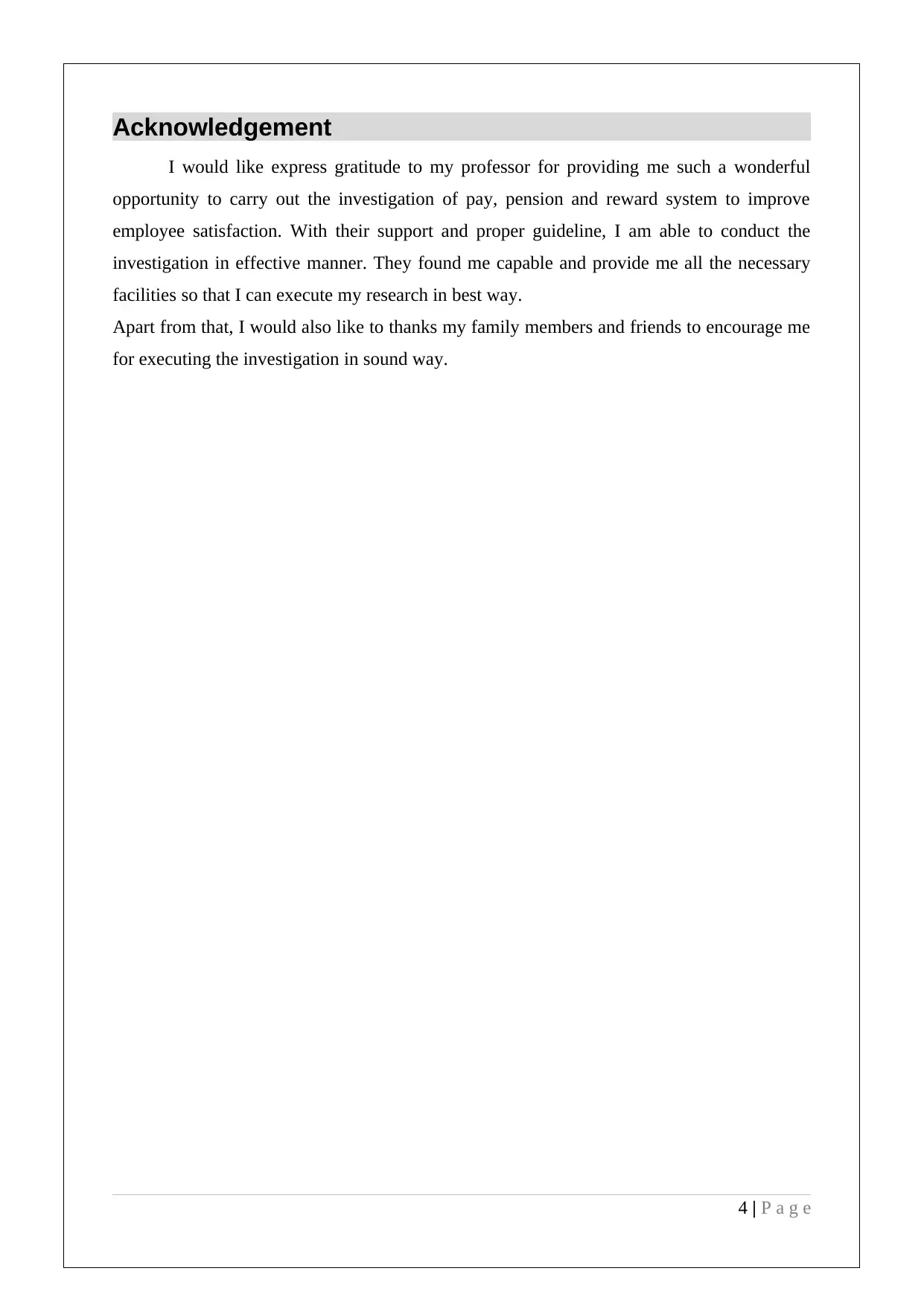
I would like express gratitude to my professor for providing me such a wonderful
opportunity to carry out the investigation of pay, pension and reward system to improve
employee satisfaction. With their support and proper guideline, I am able to conduct the
investigation in effective manner. They found me capable and provide me all the necessary
facilities so that I can execute my research in best way.
Apart from that, I would also like to thanks my family members and friends to encourage me
for executing the investigation in sound way.
4 | P a g e
Paraphrase This Document
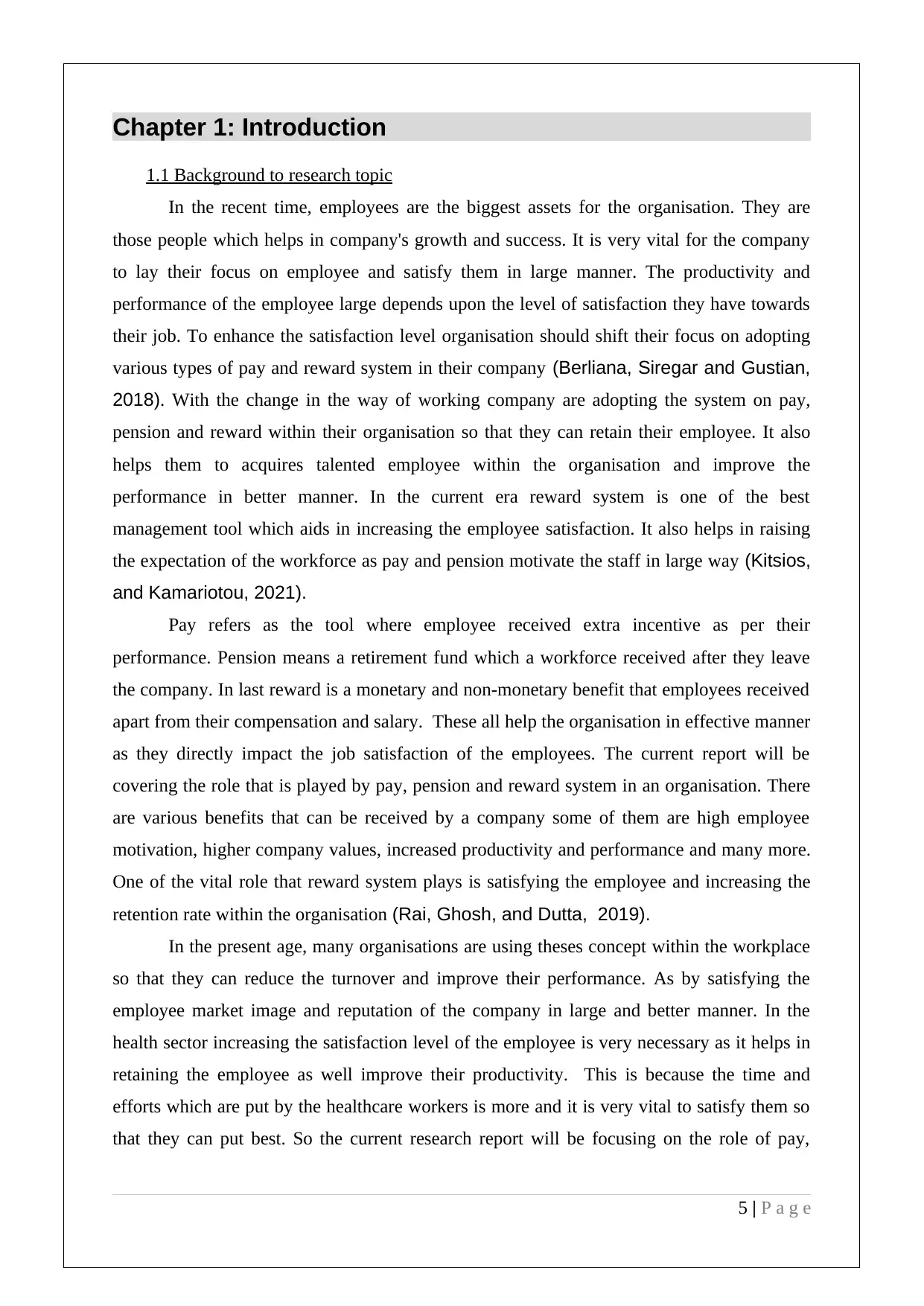
1.1 Background to research topic
In the recent time, employees are the biggest assets for the organisation. They are
those people which helps in company's growth and success. It is very vital for the company
to lay their focus on employee and satisfy them in large manner. The productivity and
performance of the employee large depends upon the level of satisfaction they have towards
their job. To enhance the satisfaction level organisation should shift their focus on adopting
various types of pay and reward system in their company (Berliana, Siregar and Gustian,
2018). With the change in the way of working company are adopting the system on pay,
pension and reward within their organisation so that they can retain their employee. It also
helps them to acquires talented employee within the organisation and improve the
performance in better manner. In the current era reward system is one of the best
management tool which aids in increasing the employee satisfaction. It also helps in raising
the expectation of the workforce as pay and pension motivate the staff in large way (Kitsios,
and Kamariotou, 2021).
Pay refers as the tool where employee received extra incentive as per their
performance. Pension means a retirement fund which a workforce received after they leave
the company. In last reward is a monetary and non-monetary benefit that employees received
apart from their compensation and salary. These all help the organisation in effective manner
as they directly impact the job satisfaction of the employees. The current report will be
covering the role that is played by pay, pension and reward system in an organisation. There
are various benefits that can be received by a company some of them are high employee
motivation, higher company values, increased productivity and performance and many more.
One of the vital role that reward system plays is satisfying the employee and increasing the
retention rate within the organisation (Rai, Ghosh, and Dutta, 2019).
In the present age, many organisations are using theses concept within the workplace
so that they can reduce the turnover and improve their performance. As by satisfying the
employee market image and reputation of the company in large and better manner. In the
health sector increasing the satisfaction level of the employee is very necessary as it helps in
retaining the employee as well improve their productivity. This is because the time and
efforts which are put by the healthcare workers is more and it is very vital to satisfy them so
that they can put best. So the current research report will be focusing on the role of pay,
5 | P a g e
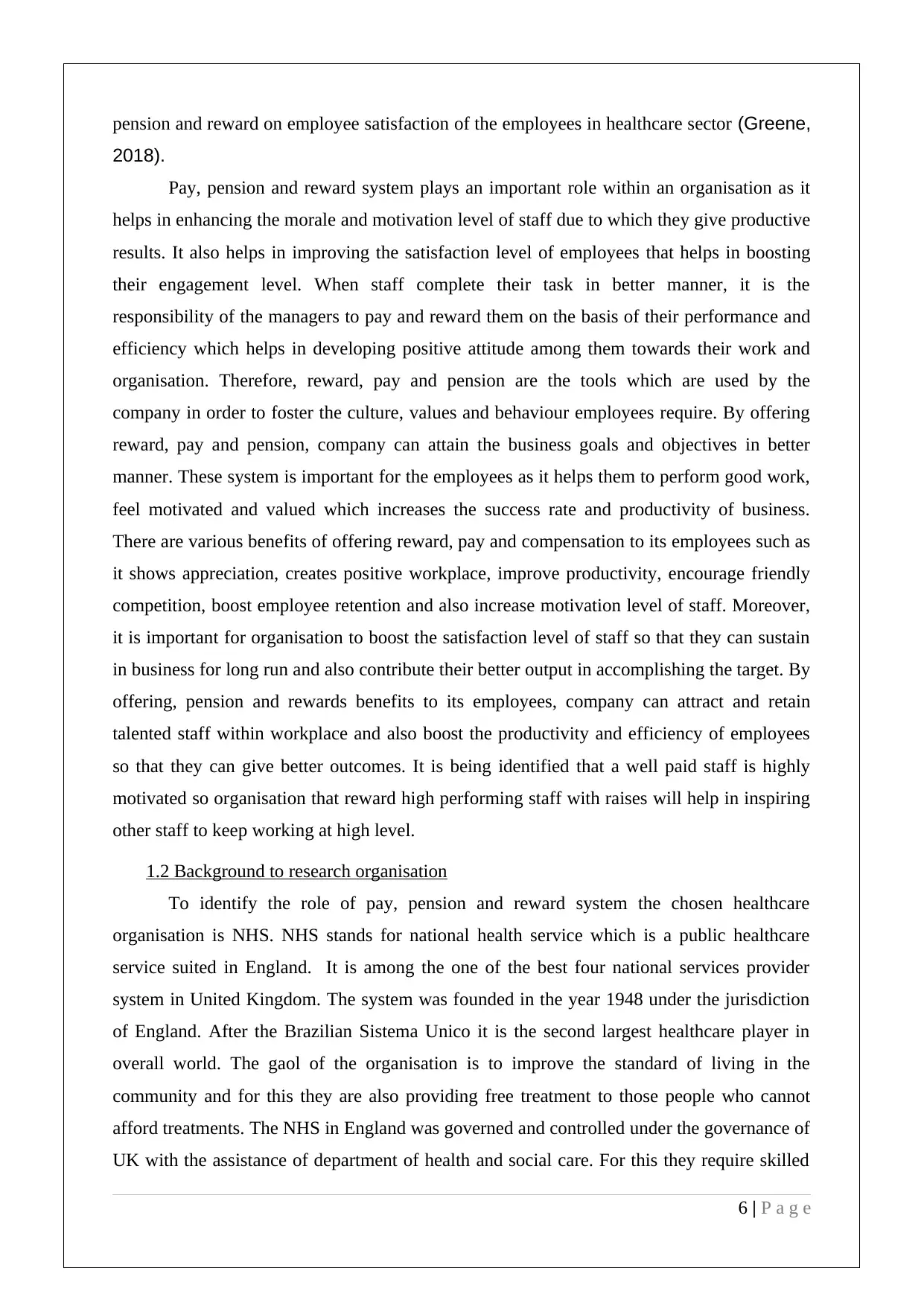
2018).
Pay, pension and reward system plays an important role within an organisation as it
helps in enhancing the morale and motivation level of staff due to which they give productive
results. It also helps in improving the satisfaction level of employees that helps in boosting
their engagement level. When staff complete their task in better manner, it is the
responsibility of the managers to pay and reward them on the basis of their performance and
efficiency which helps in developing positive attitude among them towards their work and
organisation. Therefore, reward, pay and pension are the tools which are used by the
company in order to foster the culture, values and behaviour employees require. By offering
reward, pay and pension, company can attain the business goals and objectives in better
manner. These system is important for the employees as it helps them to perform good work,
feel motivated and valued which increases the success rate and productivity of business.
There are various benefits of offering reward, pay and compensation to its employees such as
it shows appreciation, creates positive workplace, improve productivity, encourage friendly
competition, boost employee retention and also increase motivation level of staff. Moreover,
it is important for organisation to boost the satisfaction level of staff so that they can sustain
in business for long run and also contribute their better output in accomplishing the target. By
offering, pension and rewards benefits to its employees, company can attract and retain
talented staff within workplace and also boost the productivity and efficiency of employees
so that they can give better outcomes. It is being identified that a well paid staff is highly
motivated so organisation that reward high performing staff with raises will help in inspiring
other staff to keep working at high level.
1.2 Background to research organisation
To identify the role of pay, pension and reward system the chosen healthcare
organisation is NHS. NHS stands for national health service which is a public healthcare
service suited in England. It is among the one of the best four national services provider
system in United Kingdom. The system was founded in the year 1948 under the jurisdiction
of England. After the Brazilian Sistema Unico it is the second largest healthcare player in
overall world. The gaol of the organisation is to improve the standard of living in the
community and for this they are also providing free treatment to those people who cannot
afford treatments. The NHS in England was governed and controlled under the governance of
UK with the assistance of department of health and social care. For this they require skilled
6 | P a g e
⊘ This is a preview!⊘
Do you want full access?
Subscribe today to unlock all pages.

Trusted by 1+ million students worldwide
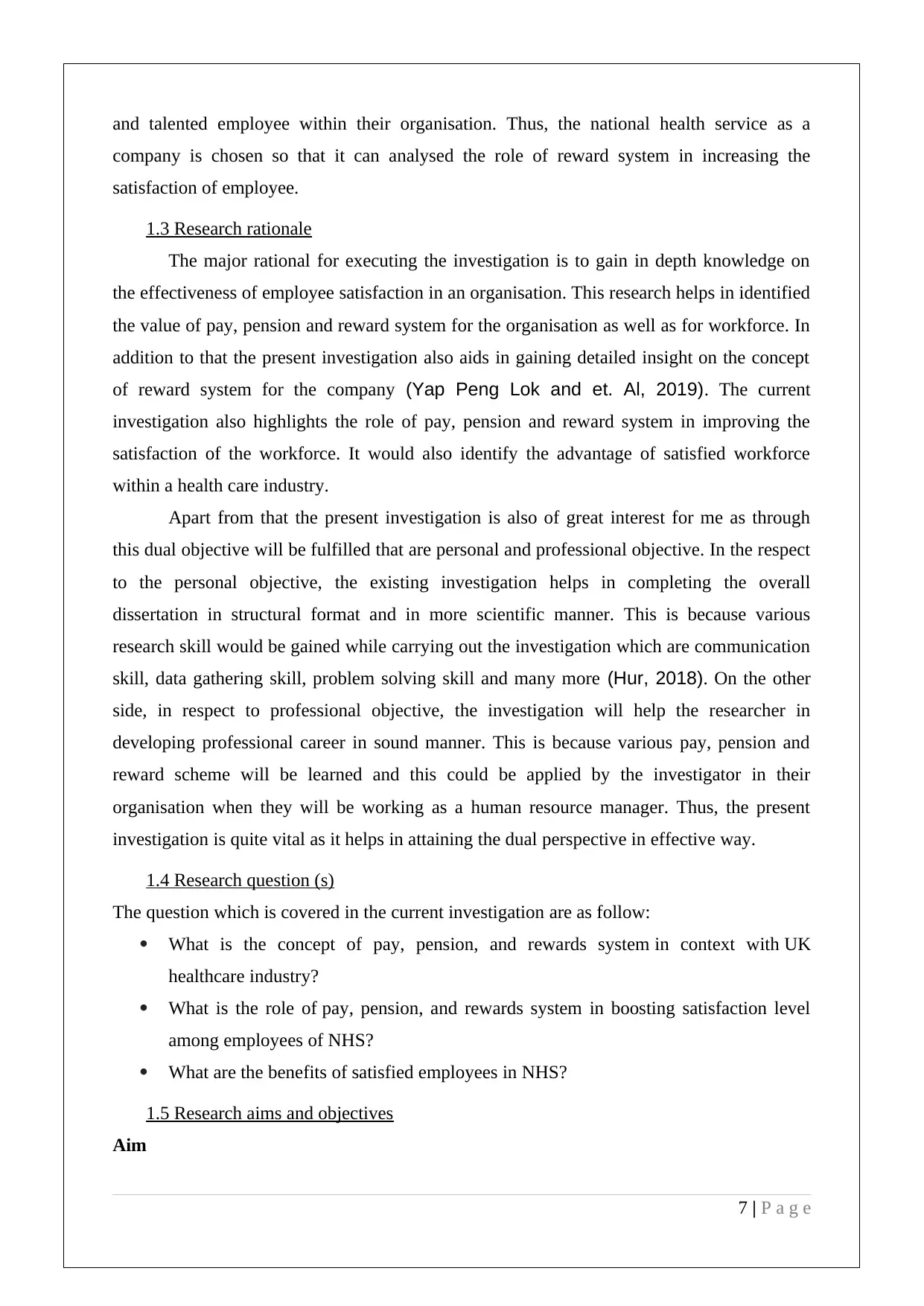
company is chosen so that it can analysed the role of reward system in increasing the
satisfaction of employee.
1.3 Research rationale
The major rational for executing the investigation is to gain in depth knowledge on
the effectiveness of employee satisfaction in an organisation. This research helps in identified
the value of pay, pension and reward system for the organisation as well as for workforce. In
addition to that the present investigation also aids in gaining detailed insight on the concept
of reward system for the company (Yap Peng Lok and et. Al, 2019). The current
investigation also highlights the role of pay, pension and reward system in improving the
satisfaction of the workforce. It would also identify the advantage of satisfied workforce
within a health care industry.
Apart from that the present investigation is also of great interest for me as through
this dual objective will be fulfilled that are personal and professional objective. In the respect
to the personal objective, the existing investigation helps in completing the overall
dissertation in structural format and in more scientific manner. This is because various
research skill would be gained while carrying out the investigation which are communication
skill, data gathering skill, problem solving skill and many more (Hur, 2018). On the other
side, in respect to professional objective, the investigation will help the researcher in
developing professional career in sound manner. This is because various pay, pension and
reward scheme will be learned and this could be applied by the investigator in their
organisation when they will be working as a human resource manager. Thus, the present
investigation is quite vital as it helps in attaining the dual perspective in effective way.
1.4 Research question (s)
The question which is covered in the current investigation are as follow:
What is the concept of pay, pension, and rewards system in context with UK
healthcare industry?
What is the role of pay, pension, and rewards system in boosting satisfaction level
among employees of NHS?
What are the benefits of satisfied employees in NHS?
1.5 Research aims and objectives
Aim
7 | P a g e
Paraphrase This Document
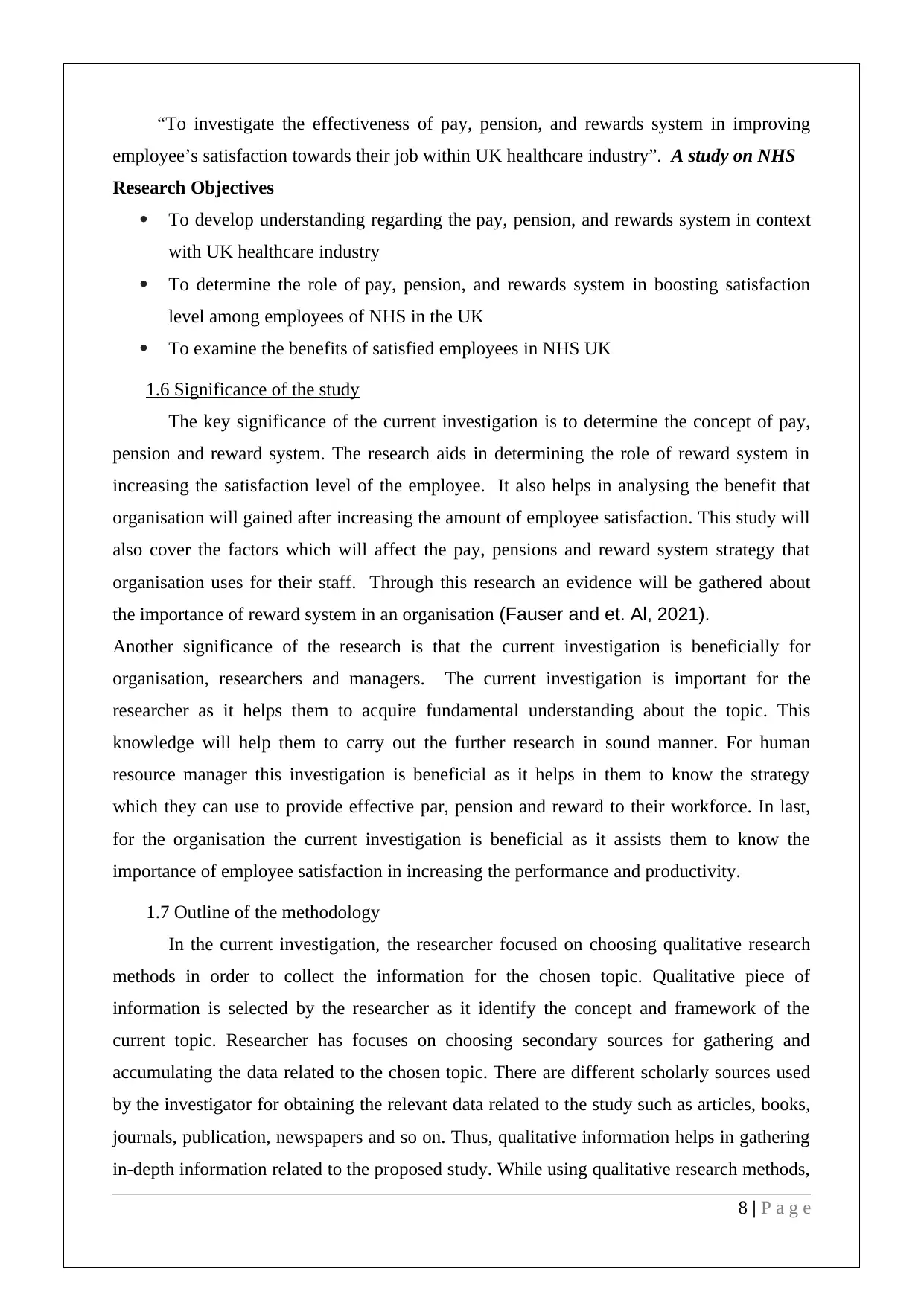
employee’s satisfaction towards their job within UK healthcare industry”. A study on NHS
Research Objectives
To develop understanding regarding the pay, pension, and rewards system in context
with UK healthcare industry
To determine the role of pay, pension, and rewards system in boosting satisfaction
level among employees of NHS in the UK
To examine the benefits of satisfied employees in NHS UK
1.6 Significance of the study
The key significance of the current investigation is to determine the concept of pay,
pension and reward system. The research aids in determining the role of reward system in
increasing the satisfaction level of the employee. It also helps in analysing the benefit that
organisation will gained after increasing the amount of employee satisfaction. This study will
also cover the factors which will affect the pay, pensions and reward system strategy that
organisation uses for their staff. Through this research an evidence will be gathered about
the importance of reward system in an organisation (Fauser and et. Al, 2021).
Another significance of the research is that the current investigation is beneficially for
organisation, researchers and managers. The current investigation is important for the
researcher as it helps them to acquire fundamental understanding about the topic. This
knowledge will help them to carry out the further research in sound manner. For human
resource manager this investigation is beneficial as it helps in them to know the strategy
which they can use to provide effective par, pension and reward to their workforce. In last,
for the organisation the current investigation is beneficial as it assists them to know the
importance of employee satisfaction in increasing the performance and productivity.
1.7 Outline of the methodology
In the current investigation, the researcher focused on choosing qualitative research
methods in order to collect the information for the chosen topic. Qualitative piece of
information is selected by the researcher as it identify the concept and framework of the
current topic. Researcher has focuses on choosing secondary sources for gathering and
accumulating the data related to the chosen topic. There are different scholarly sources used
by the investigator for obtaining the relevant data related to the study such as articles, books,
journals, publication, newspapers and so on. Thus, qualitative information helps in gathering
in-depth information related to the proposed study. While using qualitative research methods,
8 | P a g e
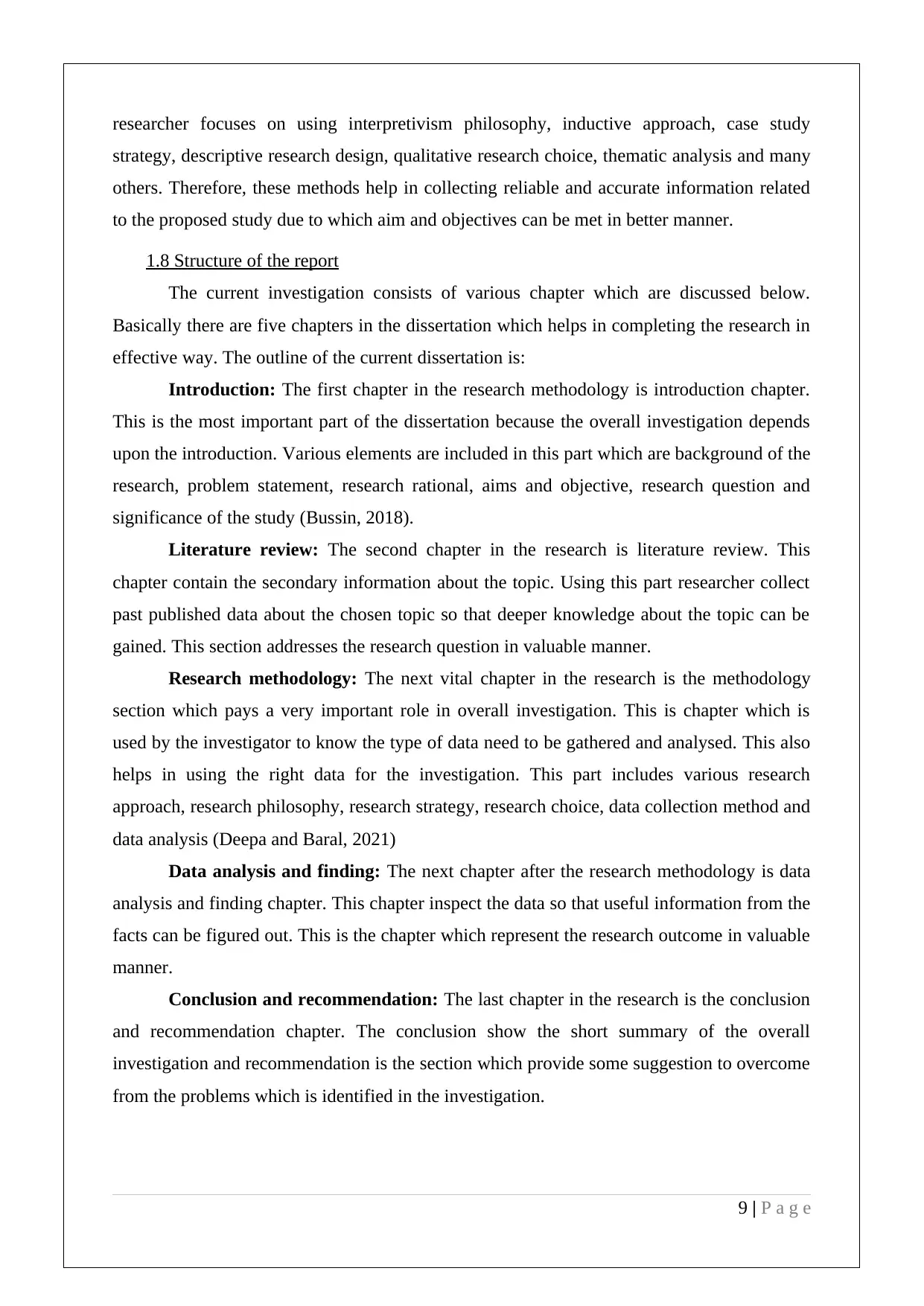
strategy, descriptive research design, qualitative research choice, thematic analysis and many
others. Therefore, these methods help in collecting reliable and accurate information related
to the proposed study due to which aim and objectives can be met in better manner.
1.8 Structure of the report
The current investigation consists of various chapter which are discussed below.
Basically there are five chapters in the dissertation which helps in completing the research in
effective way. The outline of the current dissertation is:
Introduction: The first chapter in the research methodology is introduction chapter.
This is the most important part of the dissertation because the overall investigation depends
upon the introduction. Various elements are included in this part which are background of the
research, problem statement, research rational, aims and objective, research question and
significance of the study (Bussin, 2018).
Literature review: The second chapter in the research is literature review. This
chapter contain the secondary information about the topic. Using this part researcher collect
past published data about the chosen topic so that deeper knowledge about the topic can be
gained. This section addresses the research question in valuable manner.
Research methodology: The next vital chapter in the research is the methodology
section which pays a very important role in overall investigation. This is chapter which is
used by the investigator to know the type of data need to be gathered and analysed. This also
helps in using the right data for the investigation. This part includes various research
approach, research philosophy, research strategy, research choice, data collection method and
data analysis (Deepa and Baral, 2021)
Data analysis and finding: The next chapter after the research methodology is data
analysis and finding chapter. This chapter inspect the data so that useful information from the
facts can be figured out. This is the chapter which represent the research outcome in valuable
manner.
Conclusion and recommendation: The last chapter in the research is the conclusion
and recommendation chapter. The conclusion show the short summary of the overall
investigation and recommendation is the section which provide some suggestion to overcome
from the problems which is identified in the investigation.
9 | P a g e
⊘ This is a preview!⊘
Do you want full access?
Subscribe today to unlock all pages.

Trusted by 1+ million students worldwide
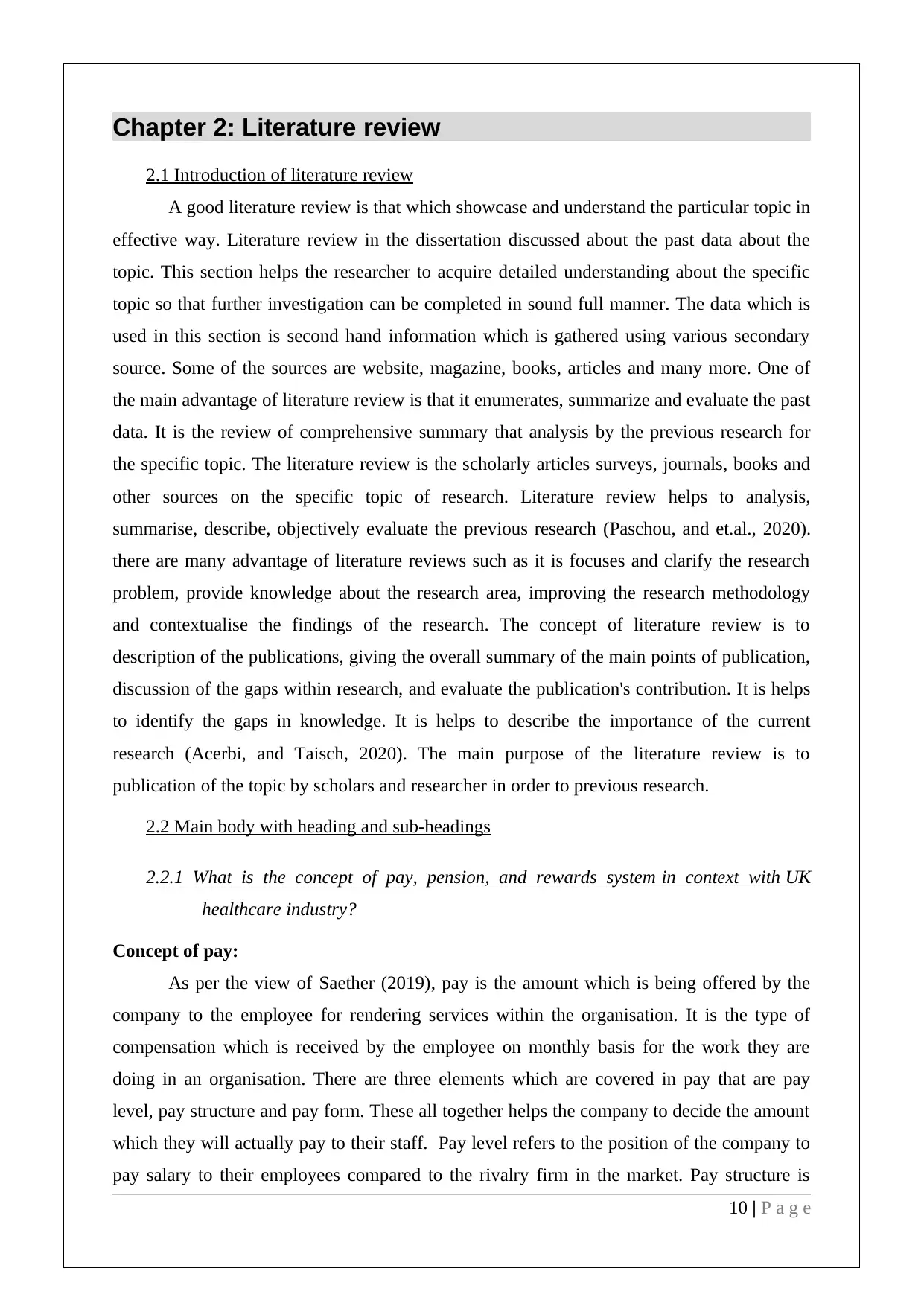
2.1 Introduction of literature review
A good literature review is that which showcase and understand the particular topic in
effective way. Literature review in the dissertation discussed about the past data about the
topic. This section helps the researcher to acquire detailed understanding about the specific
topic so that further investigation can be completed in sound full manner. The data which is
used in this section is second hand information which is gathered using various secondary
source. Some of the sources are website, magazine, books, articles and many more. One of
the main advantage of literature review is that it enumerates, summarize and evaluate the past
data. It is the review of comprehensive summary that analysis by the previous research for
the specific topic. The literature review is the scholarly articles surveys, journals, books and
other sources on the specific topic of research. Literature review helps to analysis,
summarise, describe, objectively evaluate the previous research (Paschou, and et.al., 2020).
there are many advantage of literature reviews such as it is focuses and clarify the research
problem, provide knowledge about the research area, improving the research methodology
and contextualise the findings of the research. The concept of literature review is to
description of the publications, giving the overall summary of the main points of publication,
discussion of the gaps within research, and evaluate the publication's contribution. It is helps
to identify the gaps in knowledge. It is helps to describe the importance of the current
research (Acerbi, and Taisch, 2020). The main purpose of the literature review is to
publication of the topic by scholars and researcher in order to previous research.
2.2 Main body with heading and sub-headings
2.2.1 What is the concept of pay, pension, and rewards system in context with UK
healthcare industry?
Concept of pay:
As per the view of Saether (2019), pay is the amount which is being offered by the
company to the employee for rendering services within the organisation. It is the type of
compensation which is received by the employee on monthly basis for the work they are
doing in an organisation. There are three elements which are covered in pay that are pay
level, pay structure and pay form. These all together helps the company to decide the amount
which they will actually pay to their staff. Pay level refers to the position of the company to
pay salary to their employees compared to the rivalry firm in the market. Pay structure is
10 | P a g e
Paraphrase This Document
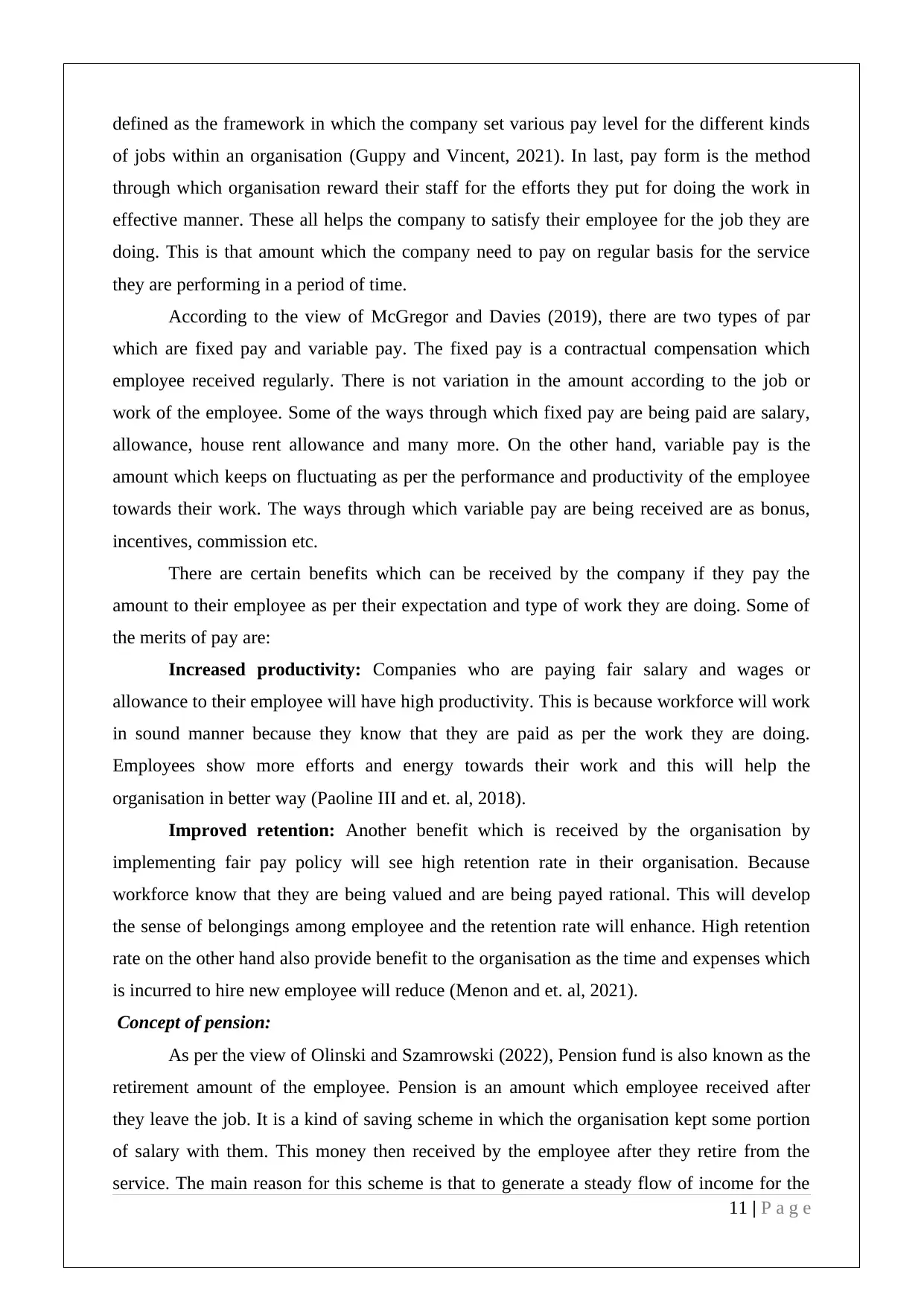
of jobs within an organisation (Guppy and Vincent, 2021). In last, pay form is the method
through which organisation reward their staff for the efforts they put for doing the work in
effective manner. These all helps the company to satisfy their employee for the job they are
doing. This is that amount which the company need to pay on regular basis for the service
they are performing in a period of time.
According to the view of McGregor and Davies (2019), there are two types of par
which are fixed pay and variable pay. The fixed pay is a contractual compensation which
employee received regularly. There is not variation in the amount according to the job or
work of the employee. Some of the ways through which fixed pay are being paid are salary,
allowance, house rent allowance and many more. On the other hand, variable pay is the
amount which keeps on fluctuating as per the performance and productivity of the employee
towards their work. The ways through which variable pay are being received are as bonus,
incentives, commission etc.
There are certain benefits which can be received by the company if they pay the
amount to their employee as per their expectation and type of work they are doing. Some of
the merits of pay are:
Increased productivity: Companies who are paying fair salary and wages or
allowance to their employee will have high productivity. This is because workforce will work
in sound manner because they know that they are paid as per the work they are doing.
Employees show more efforts and energy towards their work and this will help the
organisation in better way (Paoline III and et. al, 2018).
Improved retention: Another benefit which is received by the organisation by
implementing fair pay policy will see high retention rate in their organisation. Because
workforce know that they are being valued and are being payed rational. This will develop
the sense of belongings among employee and the retention rate will enhance. High retention
rate on the other hand also provide benefit to the organisation as the time and expenses which
is incurred to hire new employee will reduce (Menon and et. al, 2021).
Concept of pension:
As per the view of Olinski and Szamrowski (2022), Pension fund is also known as the
retirement amount of the employee. Pension is an amount which employee received after
they leave the job. It is a kind of saving scheme in which the organisation kept some portion
of salary with them. This money then received by the employee after they retire from the
service. The main reason for this scheme is that to generate a steady flow of income for the
11 | P a g e
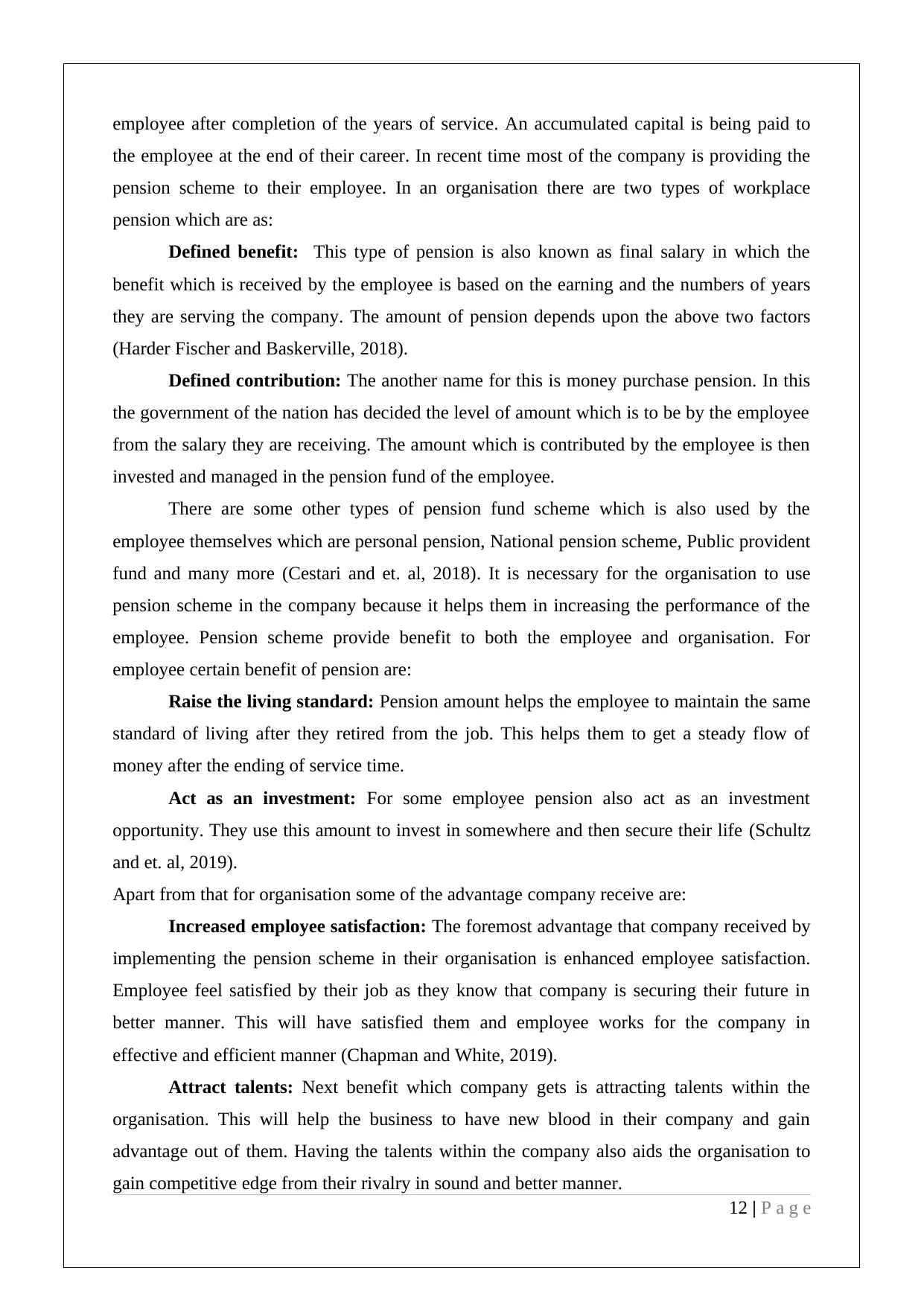
the employee at the end of their career. In recent time most of the company is providing the
pension scheme to their employee. In an organisation there are two types of workplace
pension which are as:
Defined benefit: This type of pension is also known as final salary in which the
benefit which is received by the employee is based on the earning and the numbers of years
they are serving the company. The amount of pension depends upon the above two factors
(Harder Fischer and Baskerville, 2018).
Defined contribution: The another name for this is money purchase pension. In this
the government of the nation has decided the level of amount which is to be by the employee
from the salary they are receiving. The amount which is contributed by the employee is then
invested and managed in the pension fund of the employee.
There are some other types of pension fund scheme which is also used by the
employee themselves which are personal pension, National pension scheme, Public provident
fund and many more (Cestari and et. al, 2018). It is necessary for the organisation to use
pension scheme in the company because it helps them in increasing the performance of the
employee. Pension scheme provide benefit to both the employee and organisation. For
employee certain benefit of pension are:
Raise the living standard: Pension amount helps the employee to maintain the same
standard of living after they retired from the job. This helps them to get a steady flow of
money after the ending of service time.
Act as an investment: For some employee pension also act as an investment
opportunity. They use this amount to invest in somewhere and then secure their life (Schultz
and et. al, 2019).
Apart from that for organisation some of the advantage company receive are:
Increased employee satisfaction: The foremost advantage that company received by
implementing the pension scheme in their organisation is enhanced employee satisfaction.
Employee feel satisfied by their job as they know that company is securing their future in
better manner. This will have satisfied them and employee works for the company in
effective and efficient manner (Chapman and White, 2019).
Attract talents: Next benefit which company gets is attracting talents within the
organisation. This will help the business to have new blood in their company and gain
advantage out of them. Having the talents within the company also aids the organisation to
gain competitive edge from their rivalry in sound and better manner.
12 | P a g e
⊘ This is a preview!⊘
Do you want full access?
Subscribe today to unlock all pages.

Trusted by 1+ million students worldwide
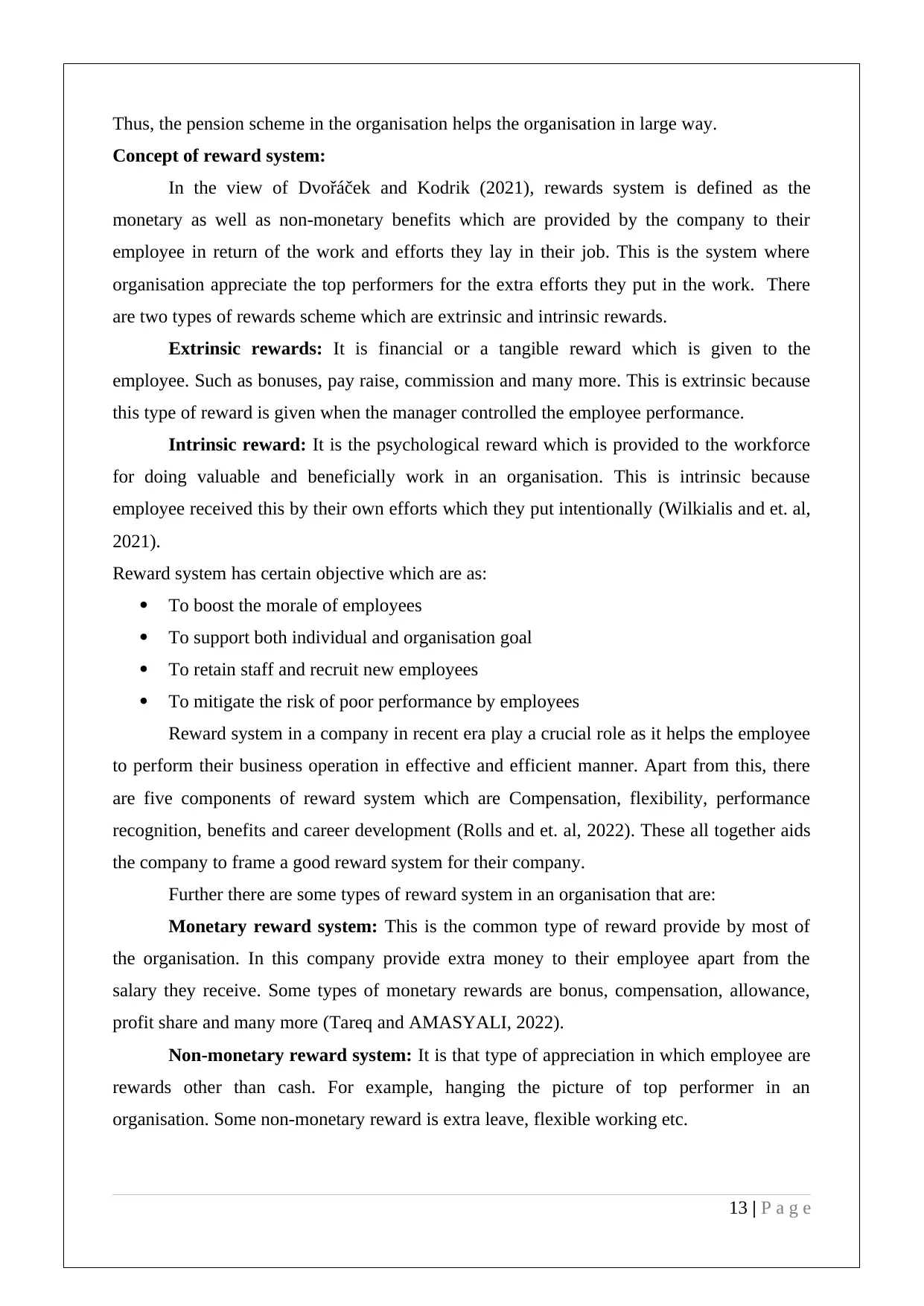
Concept of reward system:
In the view of Dvořáček and Kodrik (2021), rewards system is defined as the
monetary as well as non-monetary benefits which are provided by the company to their
employee in return of the work and efforts they lay in their job. This is the system where
organisation appreciate the top performers for the extra efforts they put in the work. There
are two types of rewards scheme which are extrinsic and intrinsic rewards.
Extrinsic rewards: It is financial or a tangible reward which is given to the
employee. Such as bonuses, pay raise, commission and many more. This is extrinsic because
this type of reward is given when the manager controlled the employee performance.
Intrinsic reward: It is the psychological reward which is provided to the workforce
for doing valuable and beneficially work in an organisation. This is intrinsic because
employee received this by their own efforts which they put intentionally (Wilkialis and et. al,
2021).
Reward system has certain objective which are as:
To boost the morale of employees
To support both individual and organisation goal
To retain staff and recruit new employees
To mitigate the risk of poor performance by employees
Reward system in a company in recent era play a crucial role as it helps the employee
to perform their business operation in effective and efficient manner. Apart from this, there
are five components of reward system which are Compensation, flexibility, performance
recognition, benefits and career development (Rolls and et. al, 2022). These all together aids
the company to frame a good reward system for their company.
Further there are some types of reward system in an organisation that are:
Monetary reward system: This is the common type of reward provide by most of
the organisation. In this company provide extra money to their employee apart from the
salary they receive. Some types of monetary rewards are bonus, compensation, allowance,
profit share and many more (Tareq and AMASYALI, 2022).
Non-monetary reward system: It is that type of appreciation in which employee are
rewards other than cash. For example, hanging the picture of top performer in an
organisation. Some non-monetary reward is extra leave, flexible working etc.
13 | P a g e
Paraphrase This Document
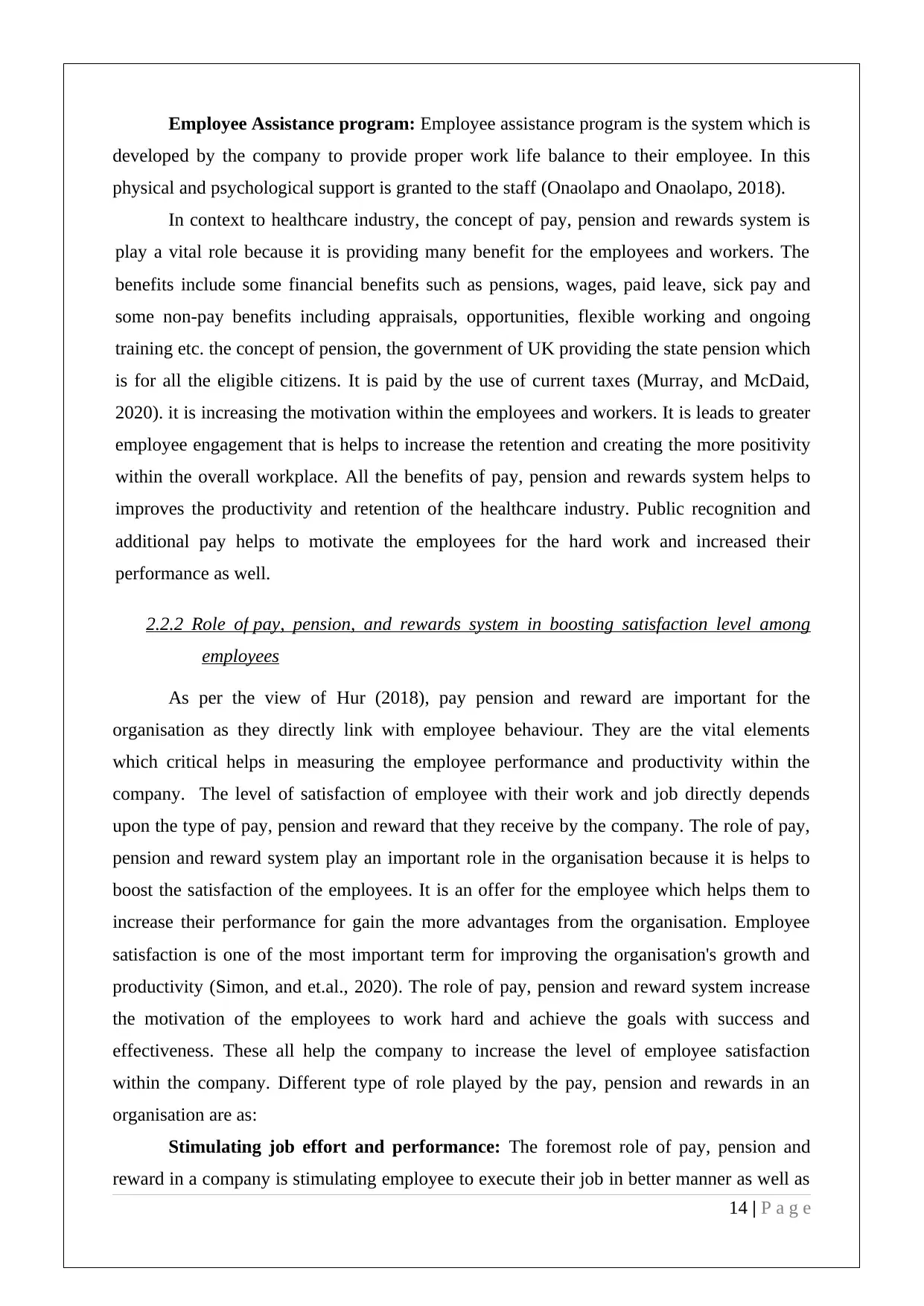
developed by the company to provide proper work life balance to their employee. In this
physical and psychological support is granted to the staff (Onaolapo and Onaolapo, 2018).
In context to healthcare industry, the concept of pay, pension and rewards system is
play a vital role because it is providing many benefit for the employees and workers. The
benefits include some financial benefits such as pensions, wages, paid leave, sick pay and
some non-pay benefits including appraisals, opportunities, flexible working and ongoing
training etc. the concept of pension, the government of UK providing the state pension which
is for all the eligible citizens. It is paid by the use of current taxes (Murray, and McDaid,
2020). it is increasing the motivation within the employees and workers. It is leads to greater
employee engagement that is helps to increase the retention and creating the more positivity
within the overall workplace. All the benefits of pay, pension and rewards system helps to
improves the productivity and retention of the healthcare industry. Public recognition and
additional pay helps to motivate the employees for the hard work and increased their
performance as well.
2.2.2 Role of pay, pension, and rewards system in boosting satisfaction level among
employees
As per the view of Hur (2018), pay pension and reward are important for the
organisation as they directly link with employee behaviour. They are the vital elements
which critical helps in measuring the employee performance and productivity within the
company. The level of satisfaction of employee with their work and job directly depends
upon the type of pay, pension and reward that they receive by the company. The role of pay,
pension and reward system play an important role in the organisation because it is helps to
boost the satisfaction of the employees. It is an offer for the employee which helps them to
increase their performance for gain the more advantages from the organisation. Employee
satisfaction is one of the most important term for improving the organisation's growth and
productivity (Simon, and et.al., 2020). The role of pay, pension and reward system increase
the motivation of the employees to work hard and achieve the goals with success and
effectiveness. These all help the company to increase the level of employee satisfaction
within the company. Different type of role played by the pay, pension and rewards in an
organisation are as:
Stimulating job effort and performance: The foremost role of pay, pension and
reward in a company is stimulating employee to execute their job in better manner as well as
14 | P a g e
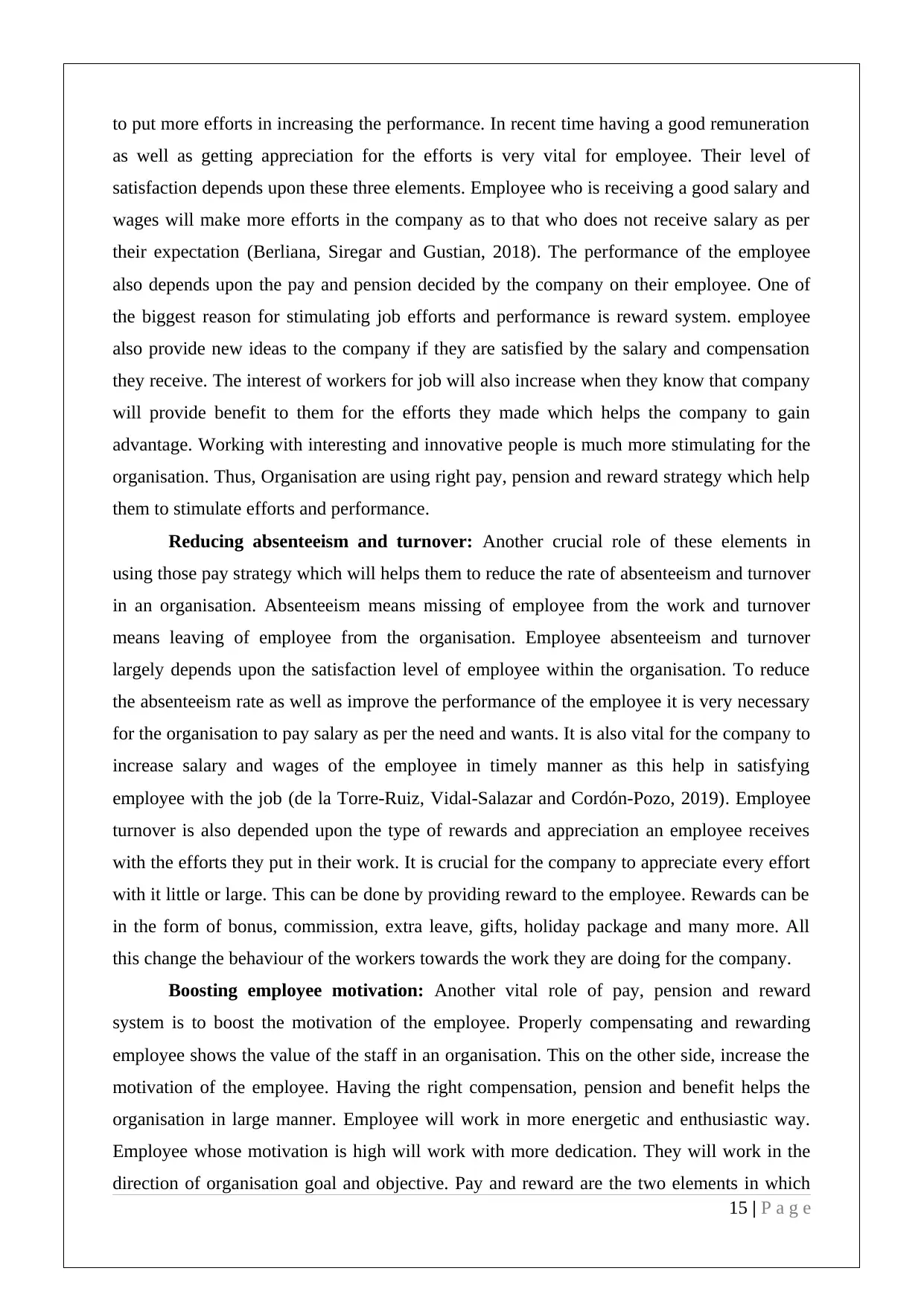
as well as getting appreciation for the efforts is very vital for employee. Their level of
satisfaction depends upon these three elements. Employee who is receiving a good salary and
wages will make more efforts in the company as to that who does not receive salary as per
their expectation (Berliana, Siregar and Gustian, 2018). The performance of the employee
also depends upon the pay and pension decided by the company on their employee. One of
the biggest reason for stimulating job efforts and performance is reward system. employee
also provide new ideas to the company if they are satisfied by the salary and compensation
they receive. The interest of workers for job will also increase when they know that company
will provide benefit to them for the efforts they made which helps the company to gain
advantage. Working with interesting and innovative people is much more stimulating for the
organisation. Thus, Organisation are using right pay, pension and reward strategy which help
them to stimulate efforts and performance.
Reducing absenteeism and turnover: Another crucial role of these elements in
using those pay strategy which will helps them to reduce the rate of absenteeism and turnover
in an organisation. Absenteeism means missing of employee from the work and turnover
means leaving of employee from the organisation. Employee absenteeism and turnover
largely depends upon the satisfaction level of employee within the organisation. To reduce
the absenteeism rate as well as improve the performance of the employee it is very necessary
for the organisation to pay salary as per the need and wants. It is also vital for the company to
increase salary and wages of the employee in timely manner as this help in satisfying
employee with the job (de la Torre-Ruiz, Vidal-Salazar and Cordón-Pozo, 2019). Employee
turnover is also depended upon the type of rewards and appreciation an employee receives
with the efforts they put in their work. It is crucial for the company to appreciate every effort
with it little or large. This can be done by providing reward to the employee. Rewards can be
in the form of bonus, commission, extra leave, gifts, holiday package and many more. All
this change the behaviour of the workers towards the work they are doing for the company.
Boosting employee motivation: Another vital role of pay, pension and reward
system is to boost the motivation of the employee. Properly compensating and rewarding
employee shows the value of the staff in an organisation. This on the other side, increase the
motivation of the employee. Having the right compensation, pension and benefit helps the
organisation in large manner. Employee will work in more energetic and enthusiastic way.
Employee whose motivation is high will work with more dedication. They will work in the
direction of organisation goal and objective. Pay and reward are the two elements in which
15 | P a g e
⊘ This is a preview!⊘
Do you want full access?
Subscribe today to unlock all pages.

Trusted by 1+ million students worldwide

They help in increasing the people morale and also assist the employee to do good job in the
organisation. It is also find that those organisations which provide salary as per employee
expectation deliver best result in the company. They work in such a manner that thy can
provide grander outcome to the company. This result improves the overall performance and
productivity of the employee. It also helps the employee to retain in the company because
high employee motivation aids the employee to see the career within the company. It also
become the focal point for the company to gain success and growth.
Boost in employee loyalty and trust: In recent time it is very vital for the company
to gain employee trust and loyalty within the company. This can only be done when company
pay employee as per their wants. Pay, pension and rewards at that time play a vital role as
having the right salary, pension and reward make employee happy and satisfied. When staff
paid well they become loyal for the company and stay with the company for longer time
period. Proper compensation and reward is one of the crucial and significant factor where
employee of the company be with the employers (Joung, Choi and Taylor, 2018). Employee
loyalty means when the worker or staff of the organisation remain within the premises of the
company for longer time duration. Employee loyalty increase when they are being
appreciated for their work as well as they feel valued in the company. Having the loyal
employee within the company also means that worker is highly satisfied with the company.
This also reduce the chance of organisation to pay extra money and time to attract and hire
new candidate for the job. Pay, pension and reward also built trust among the employee. This
trust on organisation will aids them to work in more effective and efficient manner.
Increase productivity and performance: Happy and satisfied employee are one of
the productive assets for the company. Productivity in employee begin when they receive
compensation, pension and reward as per their effort. Employee who feel valued in the
organisation will work in more productivity manner. They will work in such a way that the
performance of the employee also increases as well as they can gain advantage out of it. It
also helps the company to increase the productivity and performance of the employee as they
are the biggest reason why employee work in the company. Getting the right amount of
salary boost the morale of the employee (Kitsios and Kamariotou, 2021). This morale on the
other side put by the employee in their job. Rewards and pension also help in increasing the
efficiency of the employee. As to gain more they will work with more energy and always try
to increase their performance and productivity as compared to other employees of the
organisation. Productivity is must for the company to run a successful business in the
16 | P a g e
Paraphrase This Document
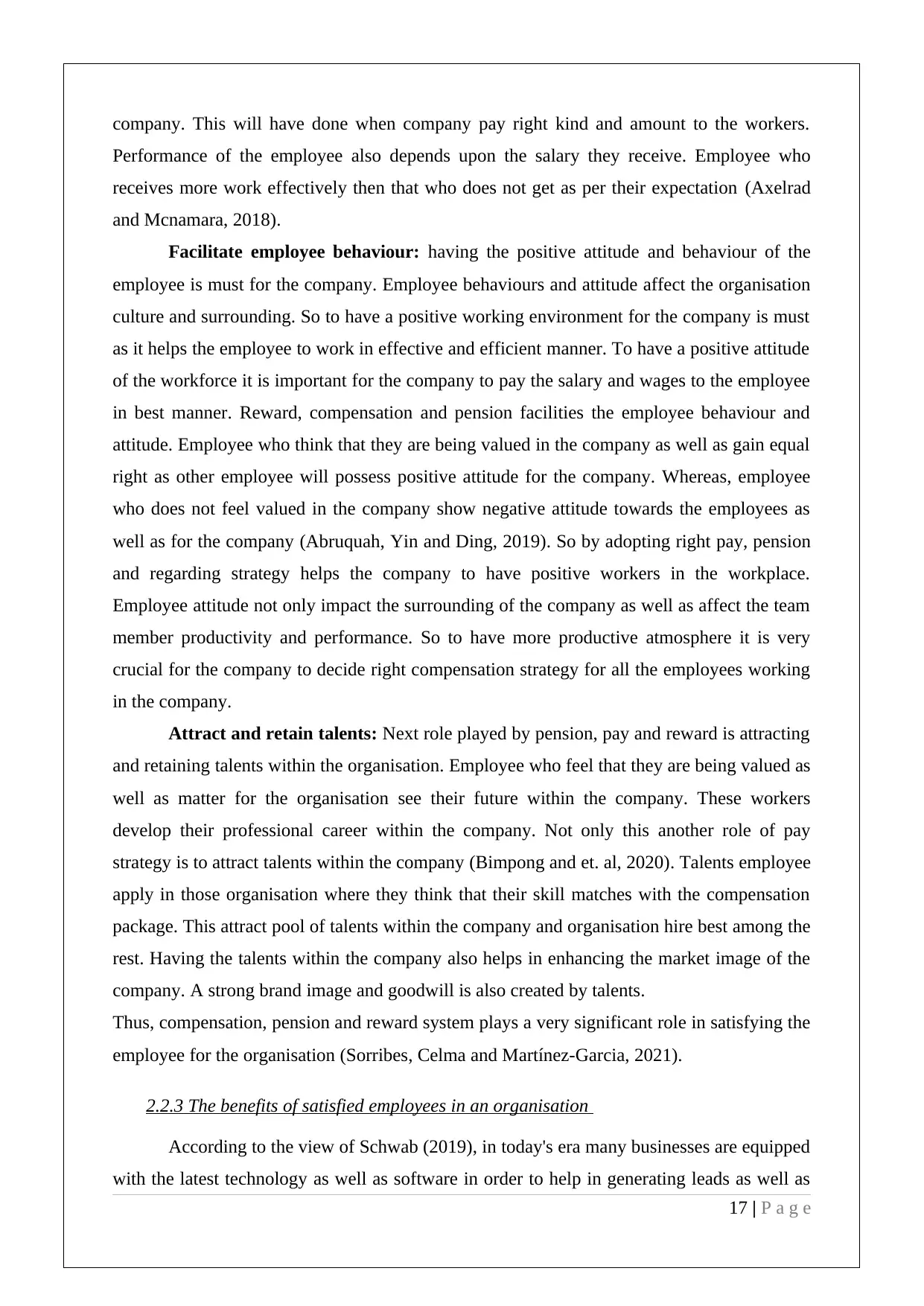
Performance of the employee also depends upon the salary they receive. Employee who
receives more work effectively then that who does not get as per their expectation (Axelrad
and Mcnamara, 2018).
Facilitate employee behaviour: having the positive attitude and behaviour of the
employee is must for the company. Employee behaviours and attitude affect the organisation
culture and surrounding. So to have a positive working environment for the company is must
as it helps the employee to work in effective and efficient manner. To have a positive attitude
of the workforce it is important for the company to pay the salary and wages to the employee
in best manner. Reward, compensation and pension facilities the employee behaviour and
attitude. Employee who think that they are being valued in the company as well as gain equal
right as other employee will possess positive attitude for the company. Whereas, employee
who does not feel valued in the company show negative attitude towards the employees as
well as for the company (Abruquah, Yin and Ding, 2019). So by adopting right pay, pension
and regarding strategy helps the company to have positive workers in the workplace.
Employee attitude not only impact the surrounding of the company as well as affect the team
member productivity and performance. So to have more productive atmosphere it is very
crucial for the company to decide right compensation strategy for all the employees working
in the company.
Attract and retain talents: Next role played by pension, pay and reward is attracting
and retaining talents within the organisation. Employee who feel that they are being valued as
well as matter for the organisation see their future within the company. These workers
develop their professional career within the company. Not only this another role of pay
strategy is to attract talents within the company (Bimpong and et. al, 2020). Talents employee
apply in those organisation where they think that their skill matches with the compensation
package. This attract pool of talents within the company and organisation hire best among the
rest. Having the talents within the company also helps in enhancing the market image of the
company. A strong brand image and goodwill is also created by talents.
Thus, compensation, pension and reward system plays a very significant role in satisfying the
employee for the organisation (Sorribes, Celma and Martínez‐Garcia, 2021).
2.2.3 The benefits of satisfied employees in an organisation
According to the view of Schwab (2019), in today's era many businesses are equipped
with the latest technology as well as software in order to help in generating leads as well as
17 | P a g e
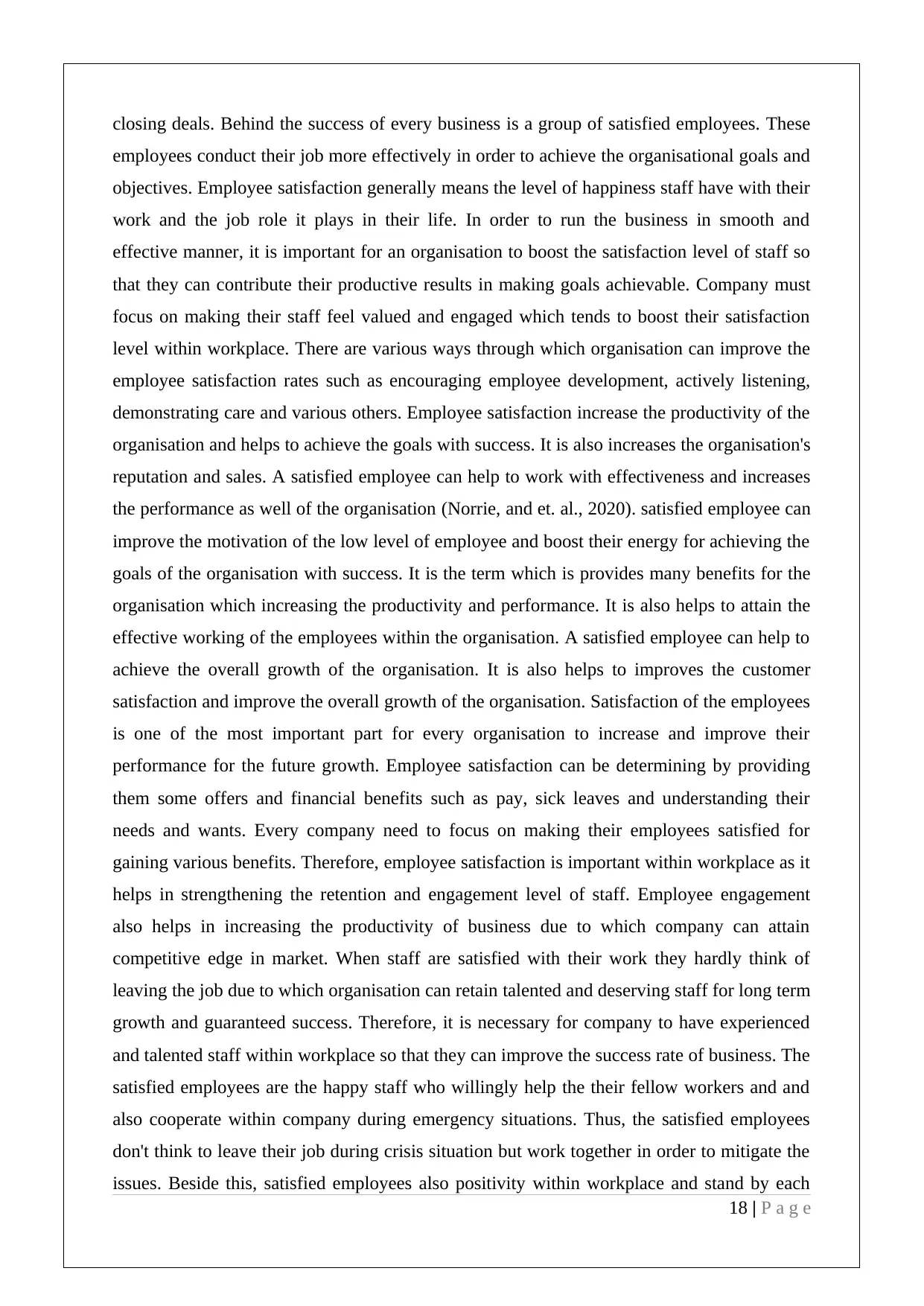
employees conduct their job more effectively in order to achieve the organisational goals and
objectives. Employee satisfaction generally means the level of happiness staff have with their
work and the job role it plays in their life. In order to run the business in smooth and
effective manner, it is important for an organisation to boost the satisfaction level of staff so
that they can contribute their productive results in making goals achievable. Company must
focus on making their staff feel valued and engaged which tends to boost their satisfaction
level within workplace. There are various ways through which organisation can improve the
employee satisfaction rates such as encouraging employee development, actively listening,
demonstrating care and various others. Employee satisfaction increase the productivity of the
organisation and helps to achieve the goals with success. It is also increases the organisation's
reputation and sales. A satisfied employee can help to work with effectiveness and increases
the performance as well of the organisation (Norrie, and et. al., 2020). satisfied employee can
improve the motivation of the low level of employee and boost their energy for achieving the
goals of the organisation with success. It is the term which is provides many benefits for the
organisation which increasing the productivity and performance. It is also helps to attain the
effective working of the employees within the organisation. A satisfied employee can help to
achieve the overall growth of the organisation. It is also helps to improves the customer
satisfaction and improve the overall growth of the organisation. Satisfaction of the employees
is one of the most important part for every organisation to increase and improve their
performance for the future growth. Employee satisfaction can be determining by providing
them some offers and financial benefits such as pay, sick leaves and understanding their
needs and wants. Every company need to focus on making their employees satisfied for
gaining various benefits. Therefore, employee satisfaction is important within workplace as it
helps in strengthening the retention and engagement level of staff. Employee engagement
also helps in increasing the productivity of business due to which company can attain
competitive edge in market. When staff are satisfied with their work they hardly think of
leaving the job due to which organisation can retain talented and deserving staff for long term
growth and guaranteed success. Therefore, it is necessary for company to have experienced
and talented staff within workplace so that they can improve the success rate of business. The
satisfied employees are the happy staff who willingly help the their fellow workers and and
also cooperate within company during emergency situations. Thus, the satisfied employees
don't think to leave their job during crisis situation but work together in order to mitigate the
issues. Beside this, satisfied employees also positivity within workplace and stand by each
18 | P a g e
⊘ This is a preview!⊘
Do you want full access?
Subscribe today to unlock all pages.

Trusted by 1+ million students worldwide

gossiping. When staff are not satisfied with their job they identify the problem in every thing.
On the other hand, of employees are happy with their job they contribute their best efforts in
enhancing the business performance and productivity. The benefits that an organisation gain
by making their employees satisfied are described below:
Increased engagement- Satisfied employees will have engaged more in their task to
accomplish it in better manner. Engaged employees brings a trickle effects for the business
organisation. With the help of teams, roles, company and community of employees,
engagement can be found easily (Johnson and Park, 2020). When the employees are satisfied
then they invest more in the all these levels. Engaged employees better understand about their
role, collaborate with their team as well as perform effectively in order to bring success of
their company. When staff is engaged in their work they give better and productive results
which leads to increase in productivity and performance of business. Satisfied employees are
engaged in their work and also connected to their workplaces. Due to the increase
engagement level of employees, the absenteeism and employee turnover get reduced. It also
helps in increasing the satisfaction level of staff and also increases the productivity of
business. Thus, satisfied employees generally contribute their best performance in improving
the success rate of organisation. The increase engagement level of staff helps in detecting
their knowledge gaps and also make them happier within workplace.
Higher productivity- The satisfied employees are tending to achieve higher
productivity in the organisation. The satisfied employees feel more invested and contribute
more in order to gain success of the company by performing their job in effective manner.
Satisfied employees helps company to operate their business function successfully for
achieving the goals and objectives in effective manner.
More customer satisfaction- Every organisation wants to make good relation with
their customer as well as retain them in order to increase their market growth. The company
need to focus on making their employee satisfied for making good relation with their
customers (Sila and Širok, 2018). Every satisfied employee performs more effectively in the
organisation and help in providing the best service to their potential customers in order to
make them satisfied.
Increases employee’s retention- Retaining highly skilled and experienced
employees are important for every company for achieving their organisational goals and
objectives in better manner. When the employees are satisfied, then they do not want to leave
their current organisation and give their best efforts in their performance. It will help
19 | P a g e
Paraphrase This Document
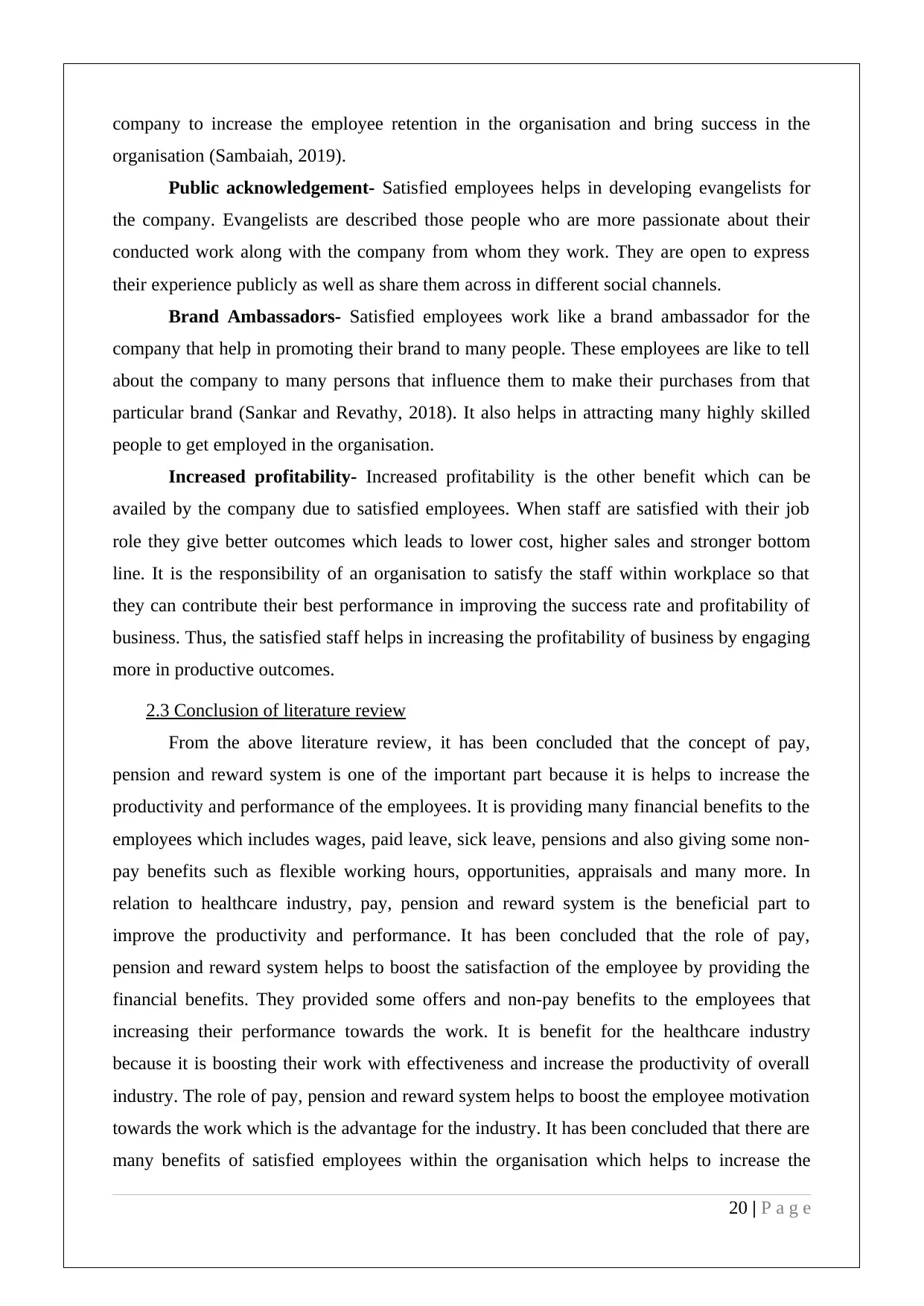
organisation (Sambaiah, 2019).
Public acknowledgement- Satisfied employees helps in developing evangelists for
the company. Evangelists are described those people who are more passionate about their
conducted work along with the company from whom they work. They are open to express
their experience publicly as well as share them across in different social channels.
Brand Ambassadors- Satisfied employees work like a brand ambassador for the
company that help in promoting their brand to many people. These employees are like to tell
about the company to many persons that influence them to make their purchases from that
particular brand (Sankar and Revathy, 2018). It also helps in attracting many highly skilled
people to get employed in the organisation.
Increased profitability- Increased profitability is the other benefit which can be
availed by the company due to satisfied employees. When staff are satisfied with their job
role they give better outcomes which leads to lower cost, higher sales and stronger bottom
line. It is the responsibility of an organisation to satisfy the staff within workplace so that
they can contribute their best performance in improving the success rate and profitability of
business. Thus, the satisfied staff helps in increasing the profitability of business by engaging
more in productive outcomes.
2.3 Conclusion of literature review
From the above literature review, it has been concluded that the concept of pay,
pension and reward system is one of the important part because it is helps to increase the
productivity and performance of the employees. It is providing many financial benefits to the
employees which includes wages, paid leave, sick leave, pensions and also giving some non-
pay benefits such as flexible working hours, opportunities, appraisals and many more. In
relation to healthcare industry, pay, pension and reward system is the beneficial part to
improve the productivity and performance. It has been concluded that the role of pay,
pension and reward system helps to boost the satisfaction of the employee by providing the
financial benefits. They provided some offers and non-pay benefits to the employees that
increasing their performance towards the work. It is benefit for the healthcare industry
because it is boosting their work with effectiveness and increase the productivity of overall
industry. The role of pay, pension and reward system helps to boost the employee motivation
towards the work which is the advantage for the industry. It has been concluded that there are
many benefits of satisfied employees within the organisation which helps to increase the
20 | P a g e
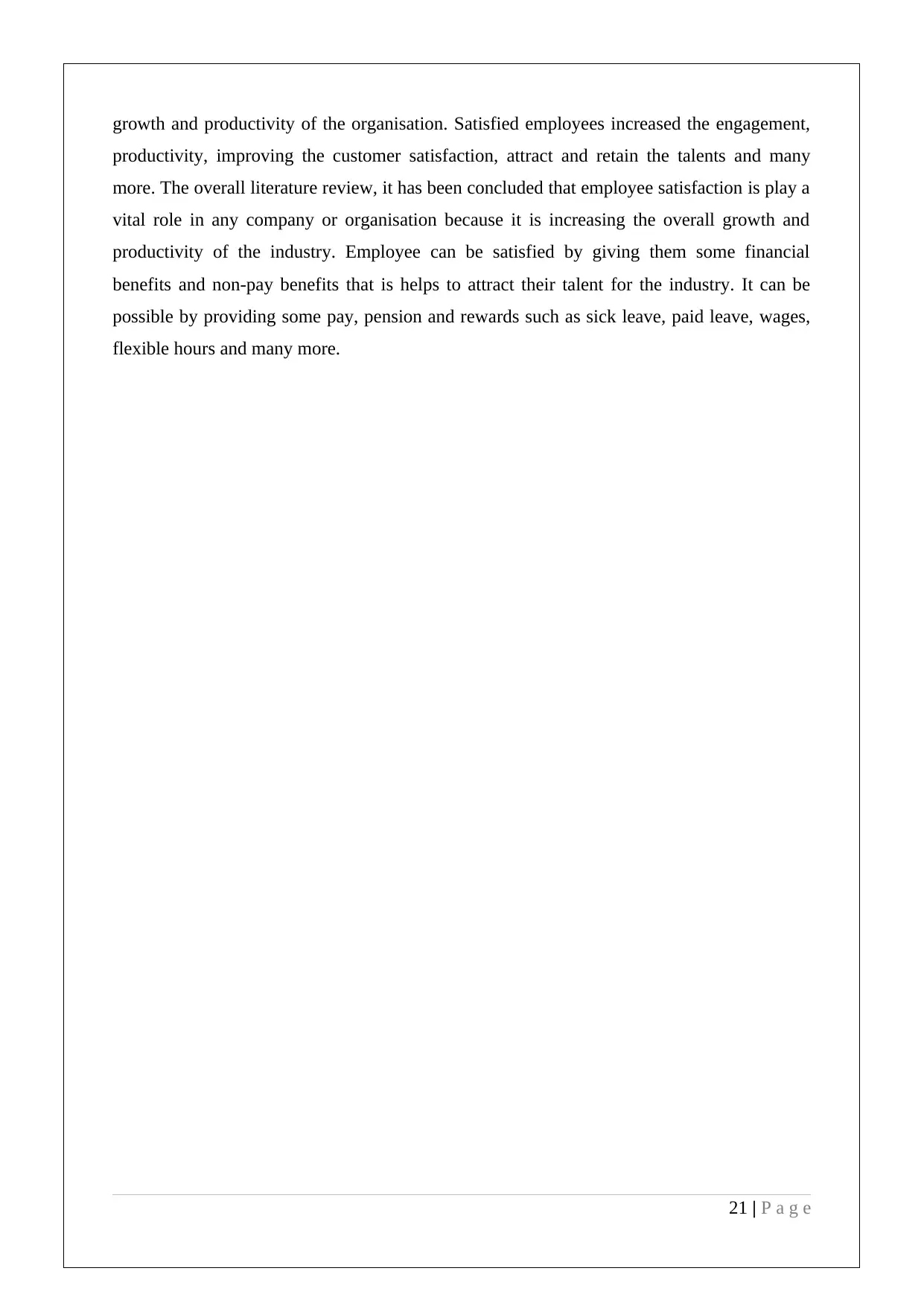
productivity, improving the customer satisfaction, attract and retain the talents and many
more. The overall literature review, it has been concluded that employee satisfaction is play a
vital role in any company or organisation because it is increasing the overall growth and
productivity of the industry. Employee can be satisfied by giving them some financial
benefits and non-pay benefits that is helps to attract their talent for the industry. It can be
possible by providing some pay, pension and rewards such as sick leave, paid leave, wages,
flexible hours and many more.
21 | P a g e
⊘ This is a preview!⊘
Do you want full access?
Subscribe today to unlock all pages.

Trusted by 1+ million students worldwide
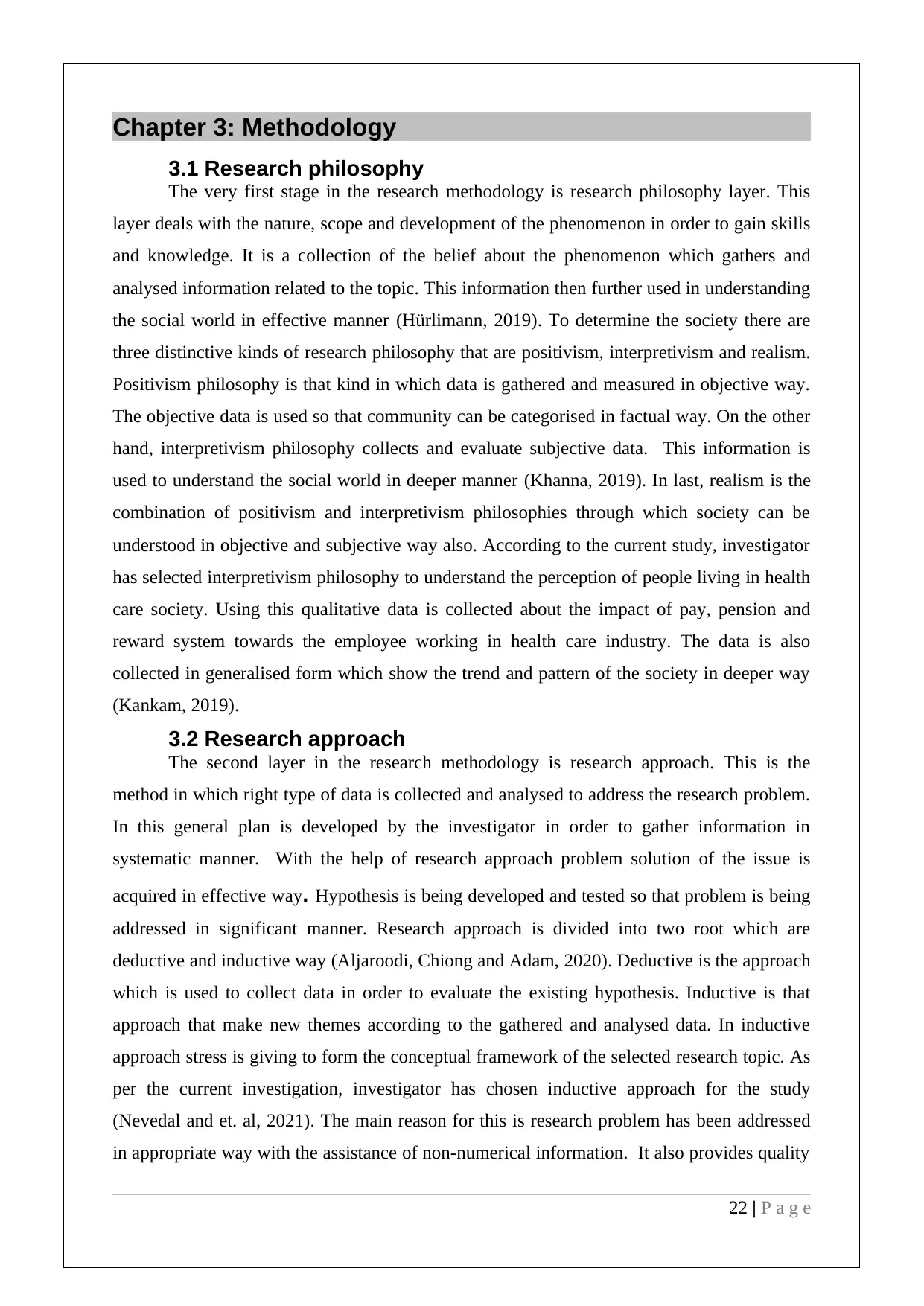
3.1 Research philosophy
The very first stage in the research methodology is research philosophy layer. This
layer deals with the nature, scope and development of the phenomenon in order to gain skills
and knowledge. It is a collection of the belief about the phenomenon which gathers and
analysed information related to the topic. This information then further used in understanding
the social world in effective manner (Hürlimann, 2019). To determine the society there are
three distinctive kinds of research philosophy that are positivism, interpretivism and realism.
Positivism philosophy is that kind in which data is gathered and measured in objective way.
The objective data is used so that community can be categorised in factual way. On the other
hand, interpretivism philosophy collects and evaluate subjective data. This information is
used to understand the social world in deeper manner (Khanna, 2019). In last, realism is the
combination of positivism and interpretivism philosophies through which society can be
understood in objective and subjective way also. According to the current study, investigator
has selected interpretivism philosophy to understand the perception of people living in health
care society. Using this qualitative data is collected about the impact of pay, pension and
reward system towards the employee working in health care industry. The data is also
collected in generalised form which show the trend and pattern of the society in deeper way
(Kankam, 2019).
3.2 Research approach
The second layer in the research methodology is research approach. This is the
method in which right type of data is collected and analysed to address the research problem.
In this general plan is developed by the investigator in order to gather information in
systematic manner. With the help of research approach problem solution of the issue is
acquired in effective way. Hypothesis is being developed and tested so that problem is being
addressed in significant manner. Research approach is divided into two root which are
deductive and inductive way (Aljaroodi, Chiong and Adam, 2020). Deductive is the approach
which is used to collect data in order to evaluate the existing hypothesis. Inductive is that
approach that make new themes according to the gathered and analysed data. In inductive
approach stress is giving to form the conceptual framework of the selected research topic. As
per the current investigation, investigator has chosen inductive approach for the study
(Nevedal and et. al, 2021). The main reason for this is research problem has been addressed
in appropriate way with the assistance of non-numerical information. It also provides quality
22 | P a g e
Paraphrase This Document
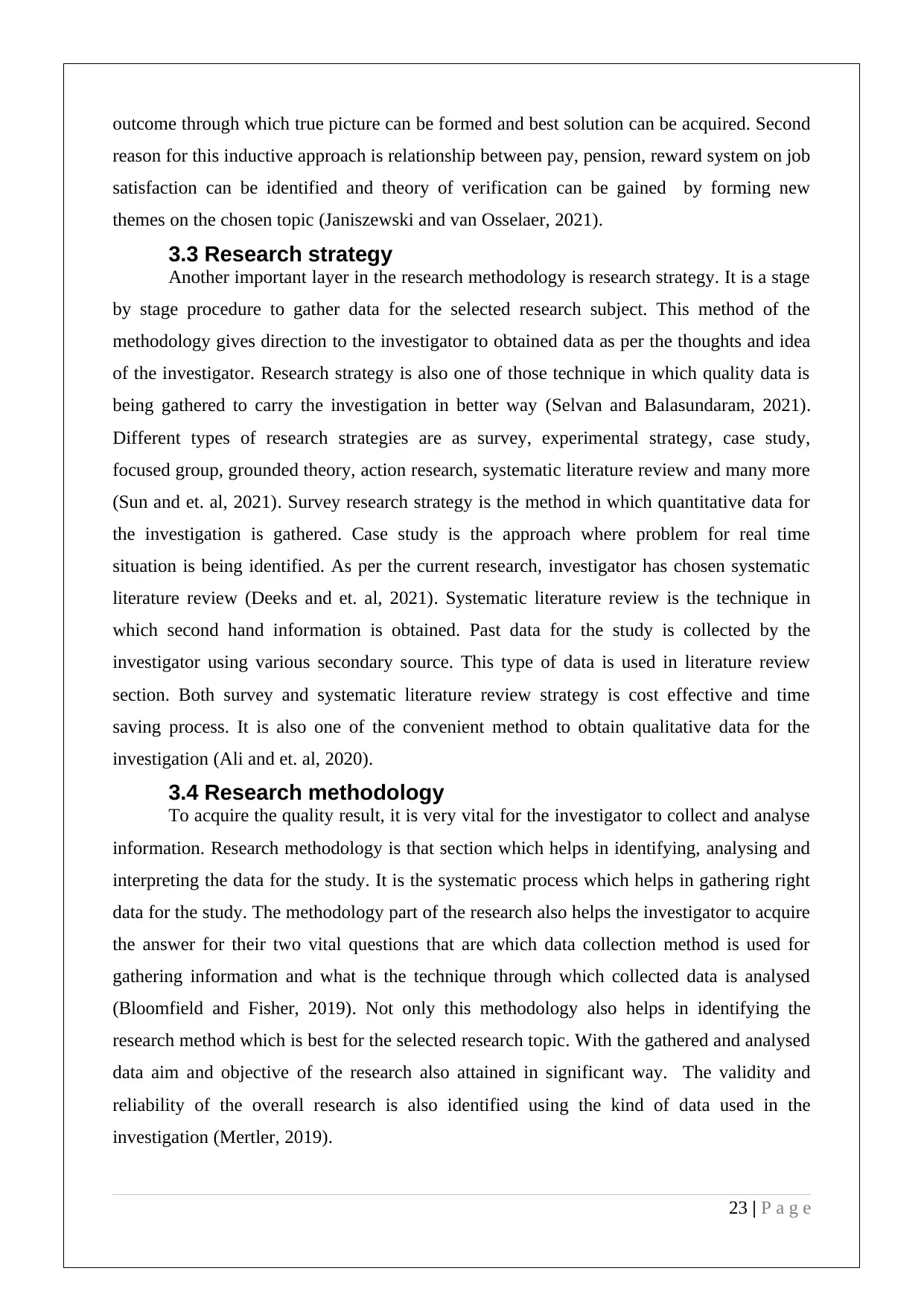
reason for this inductive approach is relationship between pay, pension, reward system on job
satisfaction can be identified and theory of verification can be gained by forming new
themes on the chosen topic (Janiszewski and van Osselaer, 2021).
3.3 Research strategy
Another important layer in the research methodology is research strategy. It is a stage
by stage procedure to gather data for the selected research subject. This method of the
methodology gives direction to the investigator to obtained data as per the thoughts and idea
of the investigator. Research strategy is also one of those technique in which quality data is
being gathered to carry the investigation in better way (Selvan and Balasundaram, 2021).
Different types of research strategies are as survey, experimental strategy, case study,
focused group, grounded theory, action research, systematic literature review and many more
(Sun and et. al, 2021). Survey research strategy is the method in which quantitative data for
the investigation is gathered. Case study is the approach where problem for real time
situation is being identified. As per the current research, investigator has chosen systematic
literature review (Deeks and et. al, 2021). Systematic literature review is the technique in
which second hand information is obtained. Past data for the study is collected by the
investigator using various secondary source. This type of data is used in literature review
section. Both survey and systematic literature review strategy is cost effective and time
saving process. It is also one of the convenient method to obtain qualitative data for the
investigation (Ali and et. al, 2020).
3.4 Research methodology
To acquire the quality result, it is very vital for the investigator to collect and analyse
information. Research methodology is that section which helps in identifying, analysing and
interpreting the data for the study. It is the systematic process which helps in gathering right
data for the study. The methodology part of the research also helps the investigator to acquire
the answer for their two vital questions that are which data collection method is used for
gathering information and what is the technique through which collected data is analysed
(Bloomfield and Fisher, 2019). Not only this methodology also helps in identifying the
research method which is best for the selected research topic. With the gathered and analysed
data aim and objective of the research also attained in significant way. The validity and
reliability of the overall research is also identified using the kind of data used in the
investigation (Mertler, 2019).
23 | P a g e
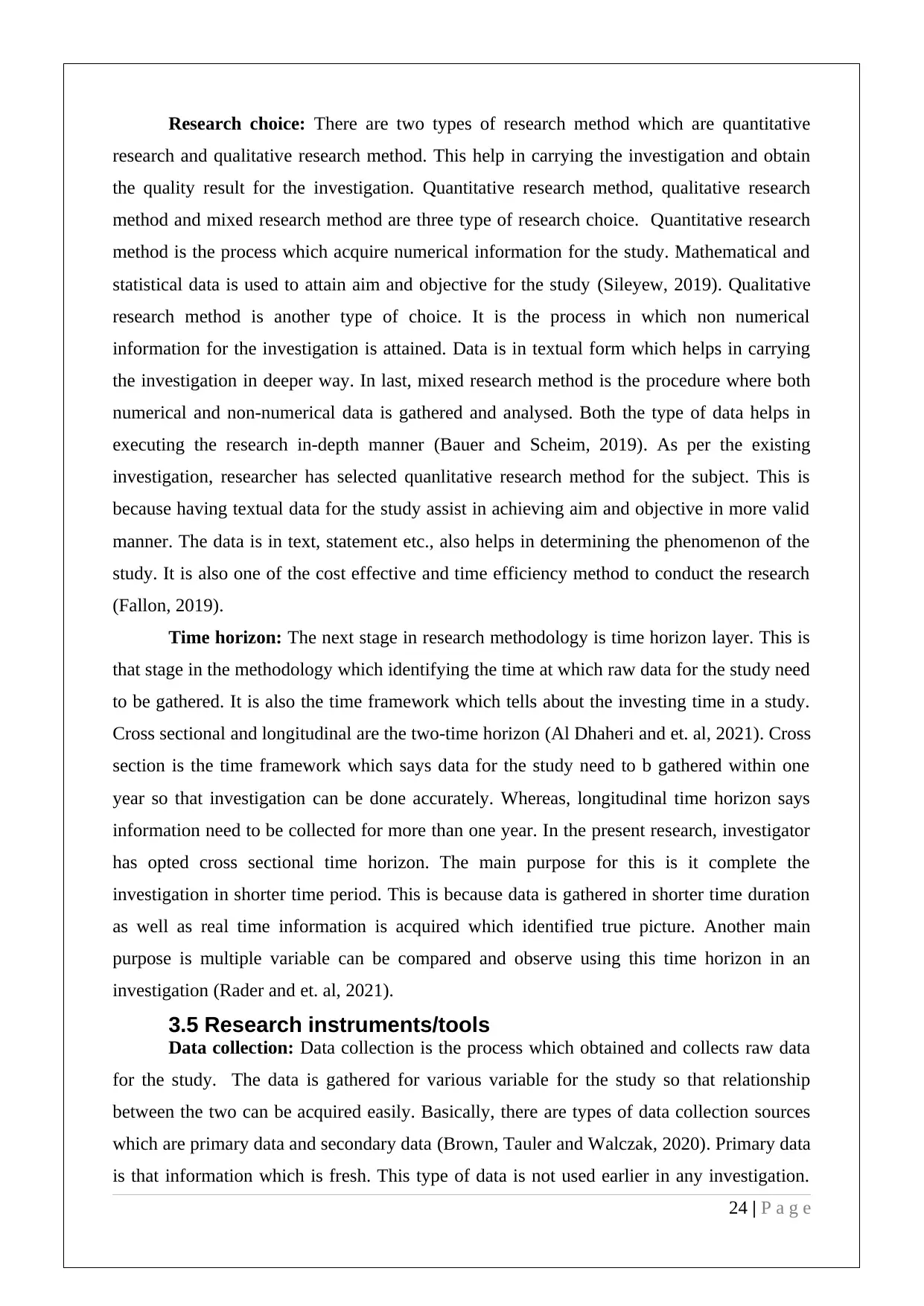
research and qualitative research method. This help in carrying the investigation and obtain
the quality result for the investigation. Quantitative research method, qualitative research
method and mixed research method are three type of research choice. Quantitative research
method is the process which acquire numerical information for the study. Mathematical and
statistical data is used to attain aim and objective for the study (Sileyew, 2019). Qualitative
research method is another type of choice. It is the process in which non numerical
information for the investigation is attained. Data is in textual form which helps in carrying
the investigation in deeper way. In last, mixed research method is the procedure where both
numerical and non-numerical data is gathered and analysed. Both the type of data helps in
executing the research in-depth manner (Bauer and Scheim, 2019). As per the existing
investigation, researcher has selected quanlitative research method for the subject. This is
because having textual data for the study assist in achieving aim and objective in more valid
manner. The data is in text, statement etc., also helps in determining the phenomenon of the
study. It is also one of the cost effective and time efficiency method to conduct the research
(Fallon, 2019).
Time horizon: The next stage in research methodology is time horizon layer. This is
that stage in the methodology which identifying the time at which raw data for the study need
to be gathered. It is also the time framework which tells about the investing time in a study.
Cross sectional and longitudinal are the two-time horizon (Al Dhaheri and et. al, 2021). Cross
section is the time framework which says data for the study need to b gathered within one
year so that investigation can be done accurately. Whereas, longitudinal time horizon says
information need to be collected for more than one year. In the present research, investigator
has opted cross sectional time horizon. The main purpose for this is it complete the
investigation in shorter time period. This is because data is gathered in shorter time duration
as well as real time information is acquired which identified true picture. Another main
purpose is multiple variable can be compared and observe using this time horizon in an
investigation (Rader and et. al, 2021).
3.5 Research instruments/tools
Data collection: Data collection is the process which obtained and collects raw data
for the study. The data is gathered for various variable for the study so that relationship
between the two can be acquired easily. Basically, there are types of data collection sources
which are primary data and secondary data (Brown, Tauler and Walczak, 2020). Primary data
is that information which is fresh. This type of data is not used earlier in any investigation.
24 | P a g e
⊘ This is a preview!⊘
Do you want full access?
Subscribe today to unlock all pages.

Trusted by 1+ million students worldwide
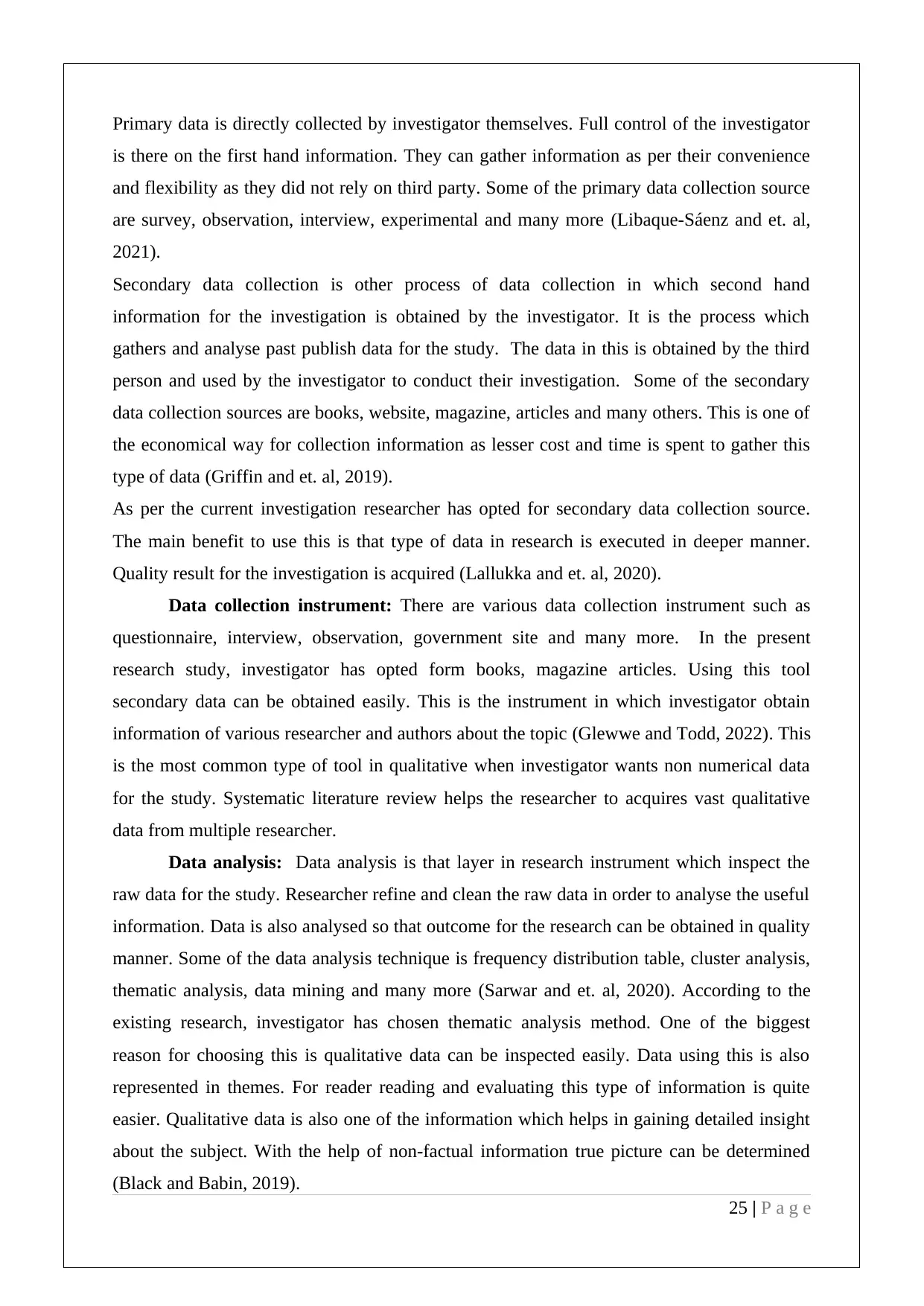
is there on the first hand information. They can gather information as per their convenience
and flexibility as they did not rely on third party. Some of the primary data collection source
are survey, observation, interview, experimental and many more (Libaque-Sáenz and et. al,
2021).
Secondary data collection is other process of data collection in which second hand
information for the investigation is obtained by the investigator. It is the process which
gathers and analyse past publish data for the study. The data in this is obtained by the third
person and used by the investigator to conduct their investigation. Some of the secondary
data collection sources are books, website, magazine, articles and many others. This is one of
the economical way for collection information as lesser cost and time is spent to gather this
type of data (Griffin and et. al, 2019).
As per the current investigation researcher has opted for secondary data collection source.
The main benefit to use this is that type of data in research is executed in deeper manner.
Quality result for the investigation is acquired (Lallukka and et. al, 2020).
Data collection instrument: There are various data collection instrument such as
questionnaire, interview, observation, government site and many more. In the present
research study, investigator has opted form books, magazine articles. Using this tool
secondary data can be obtained easily. This is the instrument in which investigator obtain
information of various researcher and authors about the topic (Glewwe and Todd, 2022). This
is the most common type of tool in qualitative when investigator wants non numerical data
for the study. Systematic literature review helps the researcher to acquires vast qualitative
data from multiple researcher.
Data analysis: Data analysis is that layer in research instrument which inspect the
raw data for the study. Researcher refine and clean the raw data in order to analyse the useful
information. Data is also analysed so that outcome for the research can be obtained in quality
manner. Some of the data analysis technique is frequency distribution table, cluster analysis,
thematic analysis, data mining and many more (Sarwar and et. al, 2020). According to the
existing research, investigator has chosen thematic analysis method. One of the biggest
reason for choosing this is qualitative data can be inspected easily. Data using this is also
represented in themes. For reader reading and evaluating this type of information is quite
easier. Qualitative data is also one of the information which helps in gaining detailed insight
about the subject. With the help of non-factual information true picture can be determined
(Black and Babin, 2019).
25 | P a g e
Paraphrase This Document
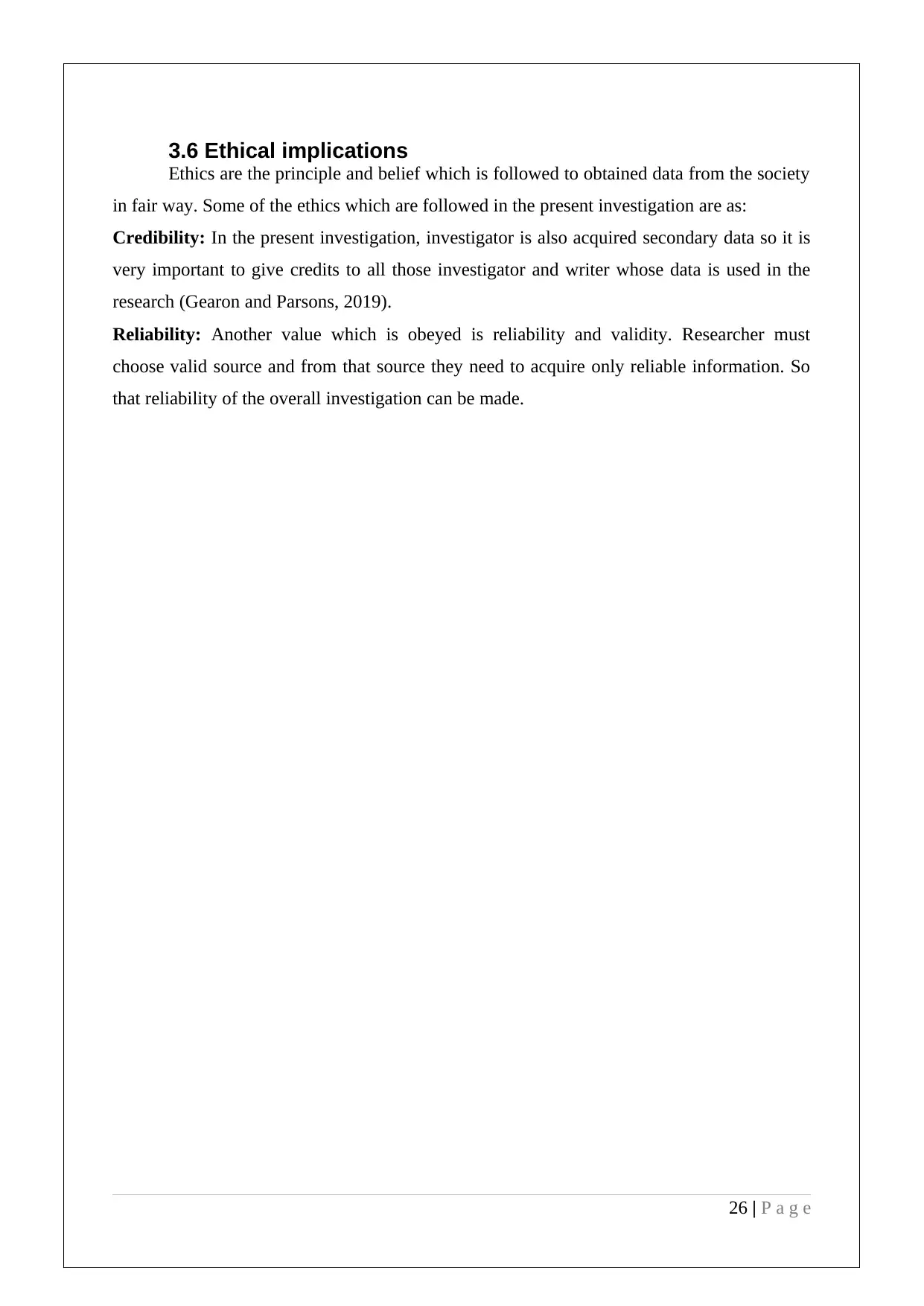
Ethics are the principle and belief which is followed to obtained data from the society
in fair way. Some of the ethics which are followed in the present investigation are as:
Credibility: In the present investigation, investigator is also acquired secondary data so it is
very important to give credits to all those investigator and writer whose data is used in the
research (Gearon and Parsons, 2019).
Reliability: Another value which is obeyed is reliability and validity. Researcher must
choose valid source and from that source they need to acquire only reliable information. So
that reliability of the overall investigation can be made.
26 | P a g e
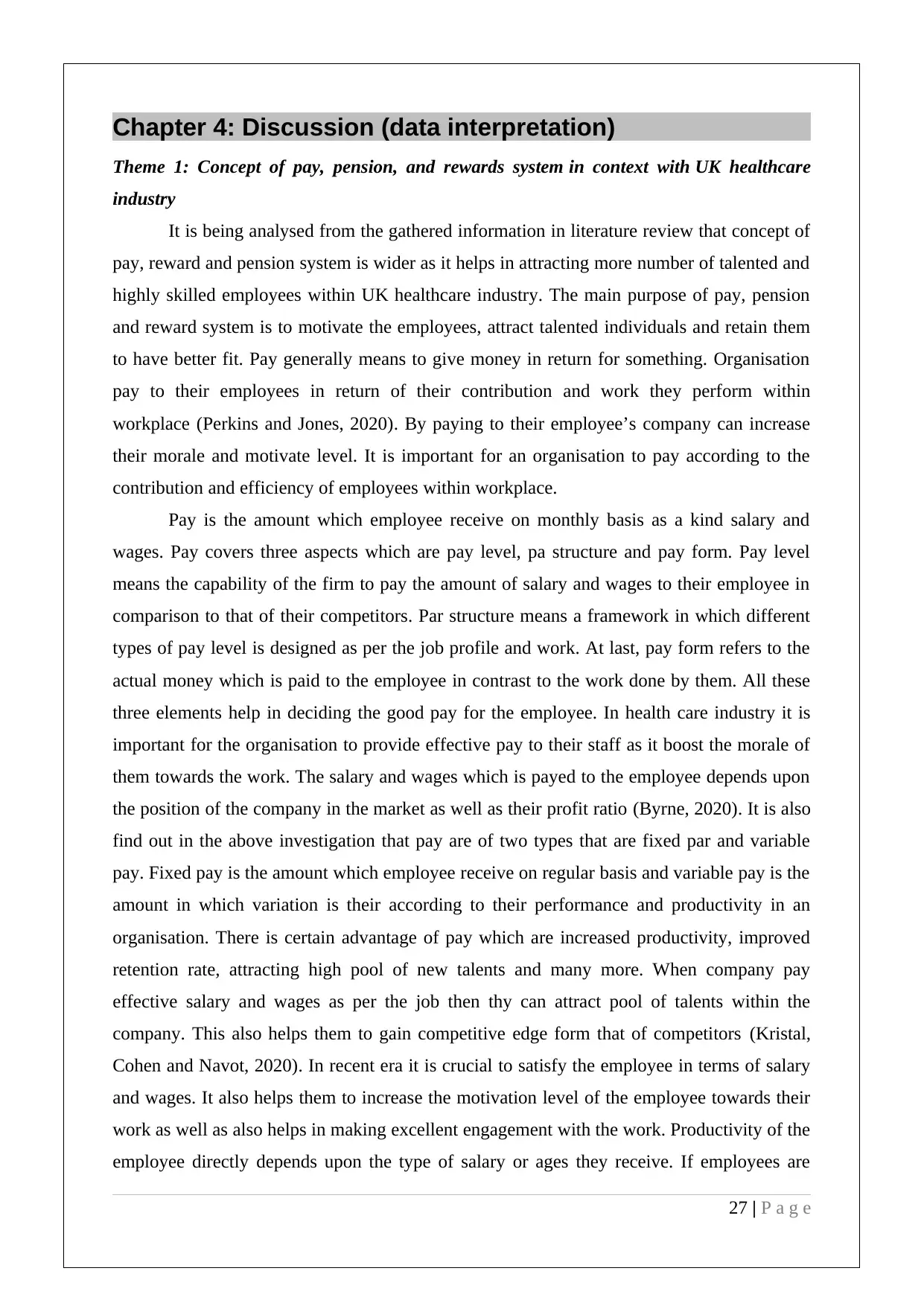
Theme 1: Concept of pay, pension, and rewards system in context with UK healthcare
industry
It is being analysed from the gathered information in literature review that concept of
pay, reward and pension system is wider as it helps in attracting more number of talented and
highly skilled employees within UK healthcare industry. The main purpose of pay, pension
and reward system is to motivate the employees, attract talented individuals and retain them
to have better fit. Pay generally means to give money in return for something. Organisation
pay to their employees in return of their contribution and work they perform within
workplace (Perkins and Jones, 2020). By paying to their employee’s company can increase
their morale and motivate level. It is important for an organisation to pay according to the
contribution and efficiency of employees within workplace.
Pay is the amount which employee receive on monthly basis as a kind salary and
wages. Pay covers three aspects which are pay level, pa structure and pay form. Pay level
means the capability of the firm to pay the amount of salary and wages to their employee in
comparison to that of their competitors. Par structure means a framework in which different
types of pay level is designed as per the job profile and work. At last, pay form refers to the
actual money which is paid to the employee in contrast to the work done by them. All these
three elements help in deciding the good pay for the employee. In health care industry it is
important for the organisation to provide effective pay to their staff as it boost the morale of
them towards the work. The salary and wages which is payed to the employee depends upon
the position of the company in the market as well as their profit ratio (Byrne, 2020). It is also
find out in the above investigation that pay are of two types that are fixed par and variable
pay. Fixed pay is the amount which employee receive on regular basis and variable pay is the
amount in which variation is their according to their performance and productivity in an
organisation. There is certain advantage of pay which are increased productivity, improved
retention rate, attracting high pool of new talents and many more. When company pay
effective salary and wages as per the job then thy can attract pool of talents within the
company. This also helps them to gain competitive edge form that of competitors (Kristal,
Cohen and Navot, 2020). In recent era it is crucial to satisfy the employee in terms of salary
and wages. It also helps them to increase the motivation level of the employee towards their
work as well as also helps in making excellent engagement with the work. Productivity of the
employee directly depends upon the type of salary or ages they receive. If employees are
27 | P a g e
⊘ This is a preview!⊘
Do you want full access?
Subscribe today to unlock all pages.

Trusted by 1+ million students worldwide
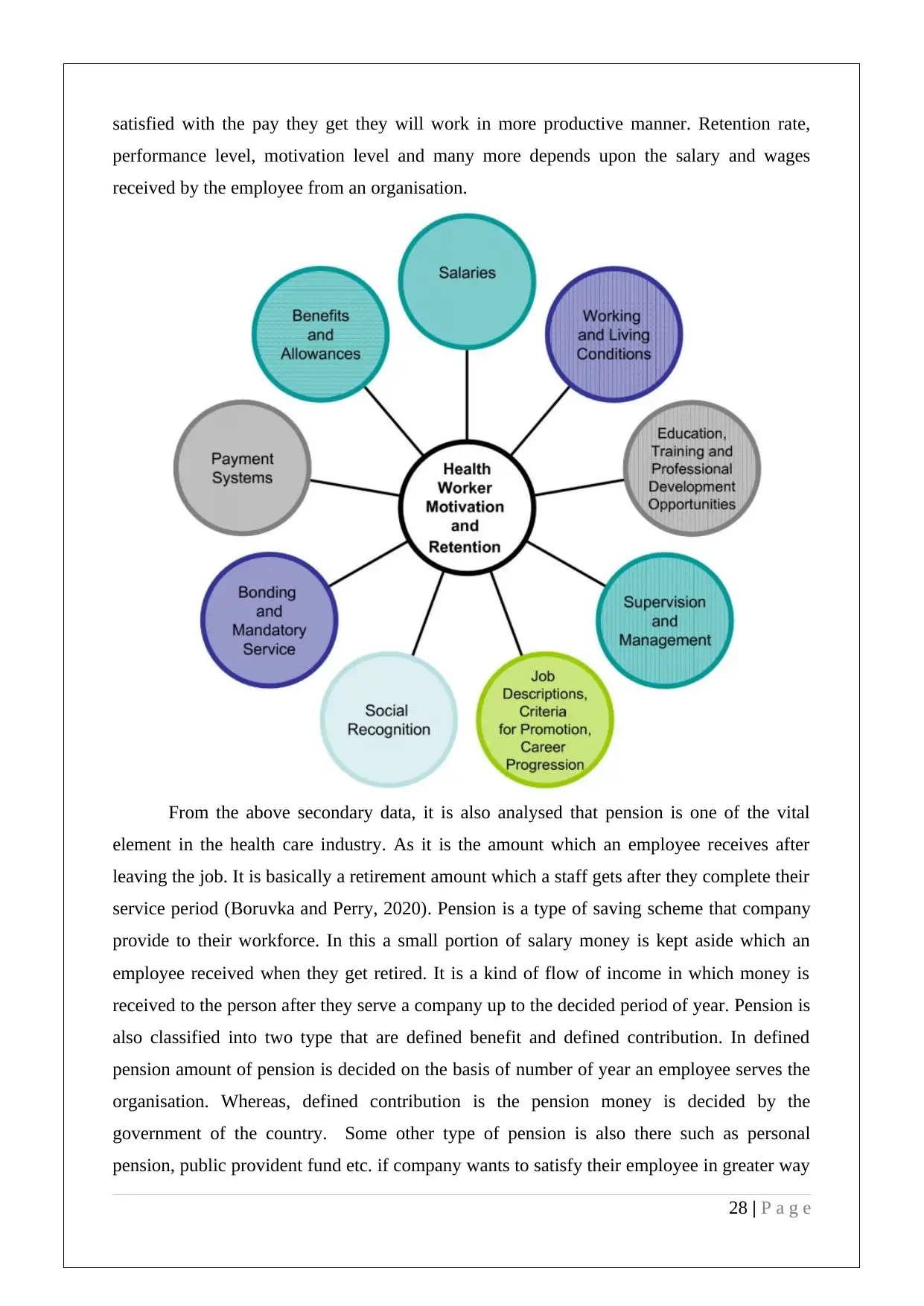
performance level, motivation level and many more depends upon the salary and wages
received by the employee from an organisation.
From the above secondary data, it is also analysed that pension is one of the vital
element in the health care industry. As it is the amount which an employee receives after
leaving the job. It is basically a retirement amount which a staff gets after they complete their
service period (Boruvka and Perry, 2020). Pension is a type of saving scheme that company
provide to their workforce. In this a small portion of salary money is kept aside which an
employee received when they get retired. It is a kind of flow of income in which money is
received to the person after they serve a company up to the decided period of year. Pension is
also classified into two type that are defined benefit and defined contribution. In defined
pension amount of pension is decided on the basis of number of year an employee serves the
organisation. Whereas, defined contribution is the pension money is decided by the
government of the country. Some other type of pension is also there such as personal
pension, public provident fund etc. if company wants to satisfy their employee in greater way
28 | P a g e
Paraphrase This Document
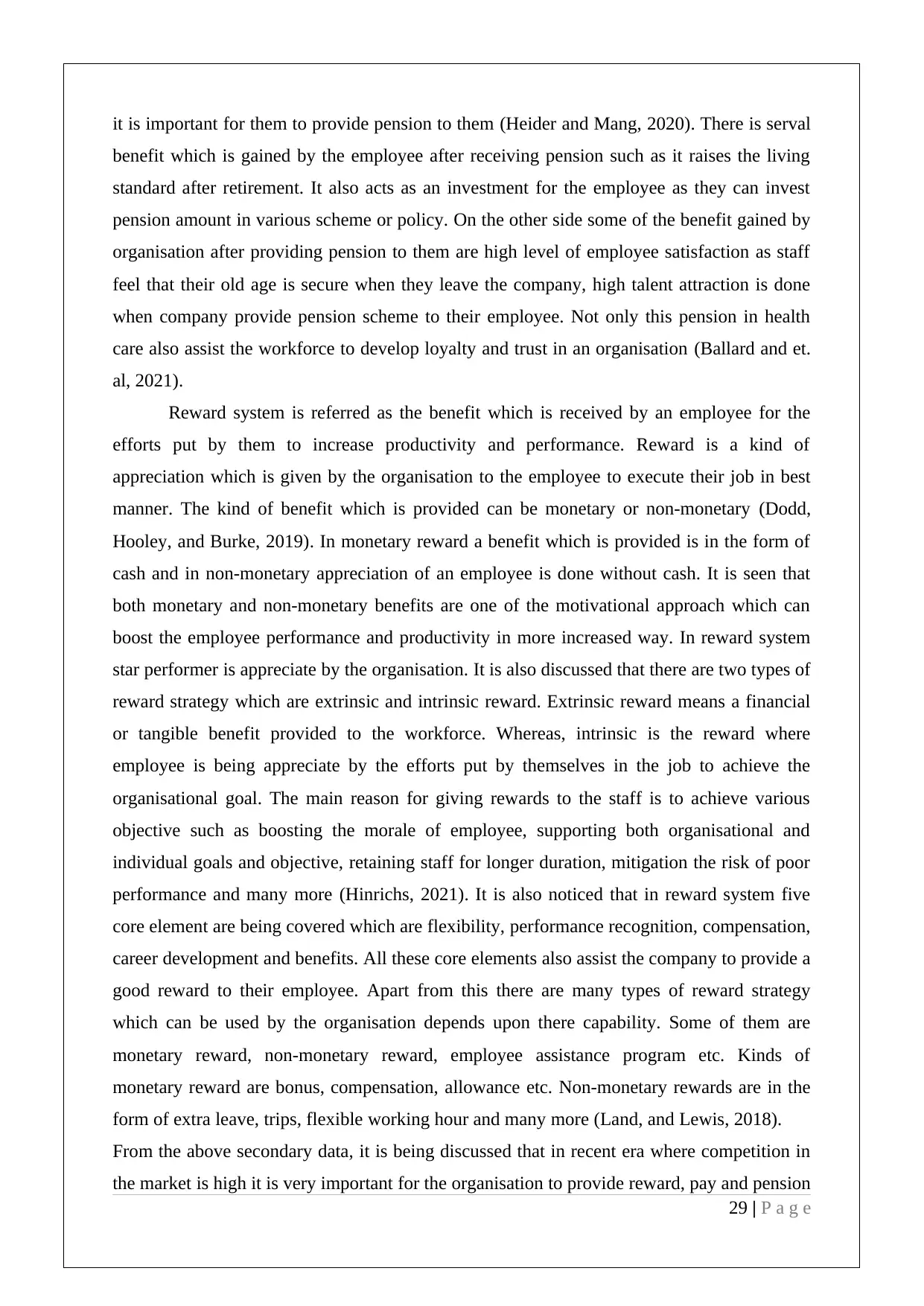
benefit which is gained by the employee after receiving pension such as it raises the living
standard after retirement. It also acts as an investment for the employee as they can invest
pension amount in various scheme or policy. On the other side some of the benefit gained by
organisation after providing pension to them are high level of employee satisfaction as staff
feel that their old age is secure when they leave the company, high talent attraction is done
when company provide pension scheme to their employee. Not only this pension in health
care also assist the workforce to develop loyalty and trust in an organisation (Ballard and et.
al, 2021).
Reward system is referred as the benefit which is received by an employee for the
efforts put by them to increase productivity and performance. Reward is a kind of
appreciation which is given by the organisation to the employee to execute their job in best
manner. The kind of benefit which is provided can be monetary or non-monetary (Dodd,
Hooley, and Burke, 2019). In monetary reward a benefit which is provided is in the form of
cash and in non-monetary appreciation of an employee is done without cash. It is seen that
both monetary and non-monetary benefits are one of the motivational approach which can
boost the employee performance and productivity in more increased way. In reward system
star performer is appreciate by the organisation. It is also discussed that there are two types of
reward strategy which are extrinsic and intrinsic reward. Extrinsic reward means a financial
or tangible benefit provided to the workforce. Whereas, intrinsic is the reward where
employee is being appreciate by the efforts put by themselves in the job to achieve the
organisational goal. The main reason for giving rewards to the staff is to achieve various
objective such as boosting the morale of employee, supporting both organisational and
individual goals and objective, retaining staff for longer duration, mitigation the risk of poor
performance and many more (Hinrichs, 2021). It is also noticed that in reward system five
core element are being covered which are flexibility, performance recognition, compensation,
career development and benefits. All these core elements also assist the company to provide a
good reward to their employee. Apart from this there are many types of reward strategy
which can be used by the organisation depends upon there capability. Some of them are
monetary reward, non-monetary reward, employee assistance program etc. Kinds of
monetary reward are bonus, compensation, allowance etc. Non-monetary rewards are in the
form of extra leave, trips, flexible working hour and many more (Land, and Lewis, 2018).
From the above secondary data, it is being discussed that in recent era where competition in
the market is high it is very important for the organisation to provide reward, pay and pension
29 | P a g e

the morale of their employee in significant ways. It is also discussed that in health care
sector, pay, pension and reward system is core components that provide advantage to both
employees and workers (Morel, Touzet, and Zemmour, 2018). With the help of theses health
care firms are boosting morale of their employee. In health care industry providing pension is
most important components. Because it helps them to secure employee family future in
sound way. Not only this pay and reward system also helps in reducing the rate of employee
turnover in the firm. It also assists in creating more positive working environment were each
and every employee works in productive manner. Employee performance also increase when
they feel that their future is secure while working in the organisation. Thus pay, pension and
rewards system are the vital components in today competitive era (Mannion, and Davies,
2018).
Theme 2: To identify the role of pay, pension and reward system to boost the satisfaction
level of the employee
With the assemble piece of information from secondary sources it is discussed that pay,
pension and reward system plays a crucial role in increasing the level of employee
satisfaction. These three elements are directly linked with employee behaviour and attitude.
These all also helps in
measuring the performance and productivity of the employee in effective way. Satisfaction
rate of the employee depends upon the pay, pension and reward system of the company
(Asaari, Desa, and Subramaniam, 2019). Boosting the satisfaction level of the is very vital to
improve the performance and productivity of the employee. This improve performance helps
them to acquire competitive benefits in sound way. Satisfying employee is very important for
the organisation because it also helps the company to acquire talents for longer time duration.
Some of the role played by the pay, pension and reward in a company are as:
Stimulating the job performance and efforts: It is very crucial for the organisation
to stimulate the performance of the employee in positive direction. By stimulating employee
perform their job and duty in better way. To stimulate the staff national health care
organisation good remuneration, pension scheme as well as reward system. This helps them
to increase the staff motivation and job satisfaction in effective manner. Those people who
receive better salary and wages, pension amount and reward has done better job and put more
efforts towards their job as compare to that who does not receive (Chinyio, Suresh, and
Salisu, 2018). It is analysed that performance and productivity depends positively on these
30 | P a g e
⊘ This is a preview!⊘
Do you want full access?
Subscribe today to unlock all pages.

Trusted by 1+ million students worldwide
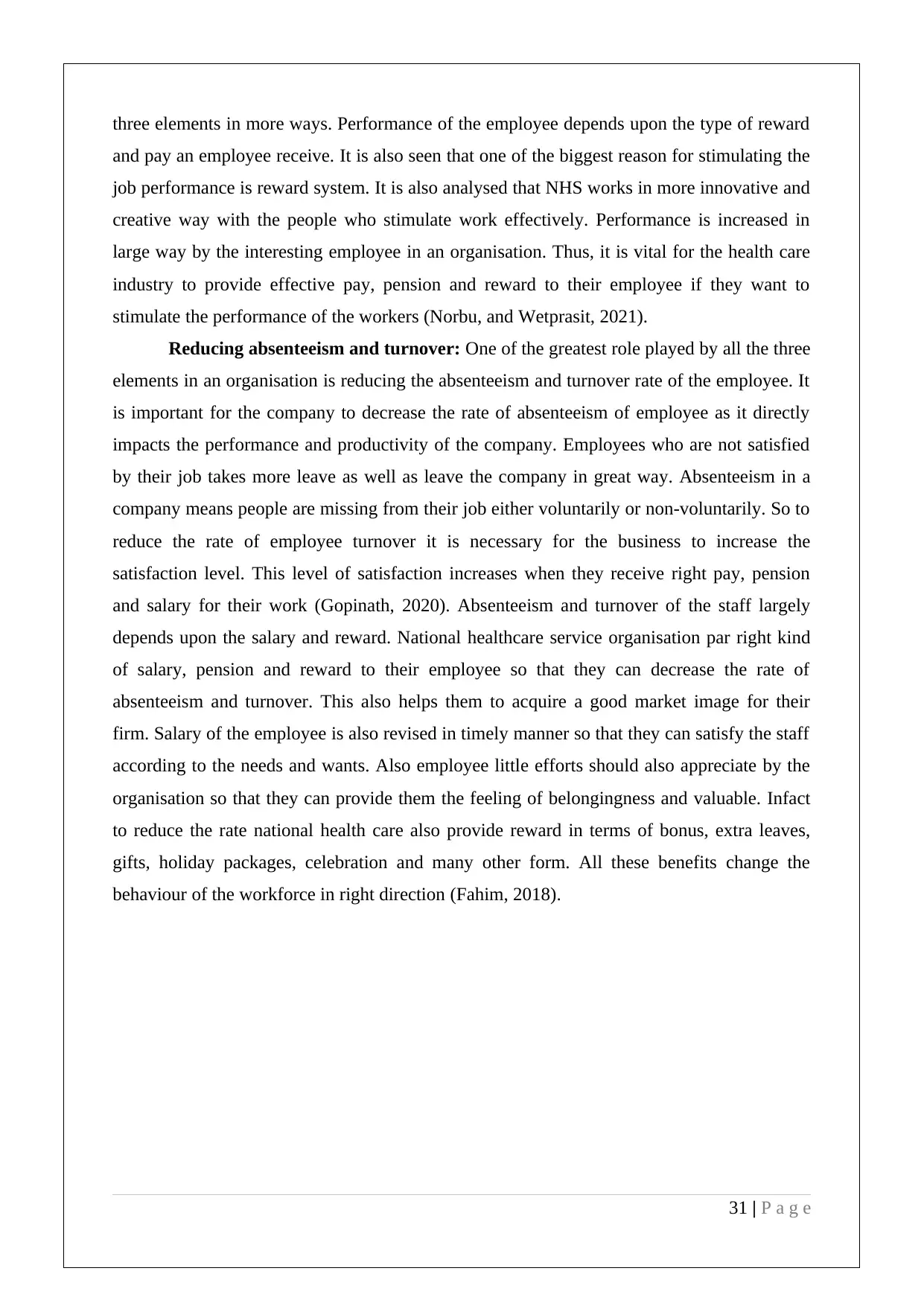
and pay an employee receive. It is also seen that one of the biggest reason for stimulating the
job performance is reward system. It is also analysed that NHS works in more innovative and
creative way with the people who stimulate work effectively. Performance is increased in
large way by the interesting employee in an organisation. Thus, it is vital for the health care
industry to provide effective pay, pension and reward to their employee if they want to
stimulate the performance of the workers (Norbu, and Wetprasit, 2021).
Reducing absenteeism and turnover: One of the greatest role played by all the three
elements in an organisation is reducing the absenteeism and turnover rate of the employee. It
is important for the company to decrease the rate of absenteeism of employee as it directly
impacts the performance and productivity of the company. Employees who are not satisfied
by their job takes more leave as well as leave the company in great way. Absenteeism in a
company means people are missing from their job either voluntarily or non-voluntarily. So to
reduce the rate of employee turnover it is necessary for the business to increase the
satisfaction level. This level of satisfaction increases when they receive right pay, pension
and salary for their work (Gopinath, 2020). Absenteeism and turnover of the staff largely
depends upon the salary and reward. National healthcare service organisation par right kind
of salary, pension and reward to their employee so that they can decrease the rate of
absenteeism and turnover. This also helps them to acquire a good market image for their
firm. Salary of the employee is also revised in timely manner so that they can satisfy the staff
according to the needs and wants. Also employee little efforts should also appreciate by the
organisation so that they can provide them the feeling of belongingness and valuable. Infact
to reduce the rate national health care also provide reward in terms of bonus, extra leaves,
gifts, holiday packages, celebration and many other form. All these benefits change the
behaviour of the workforce in right direction (Fahim, 2018).
31 | P a g e
Paraphrase This Document
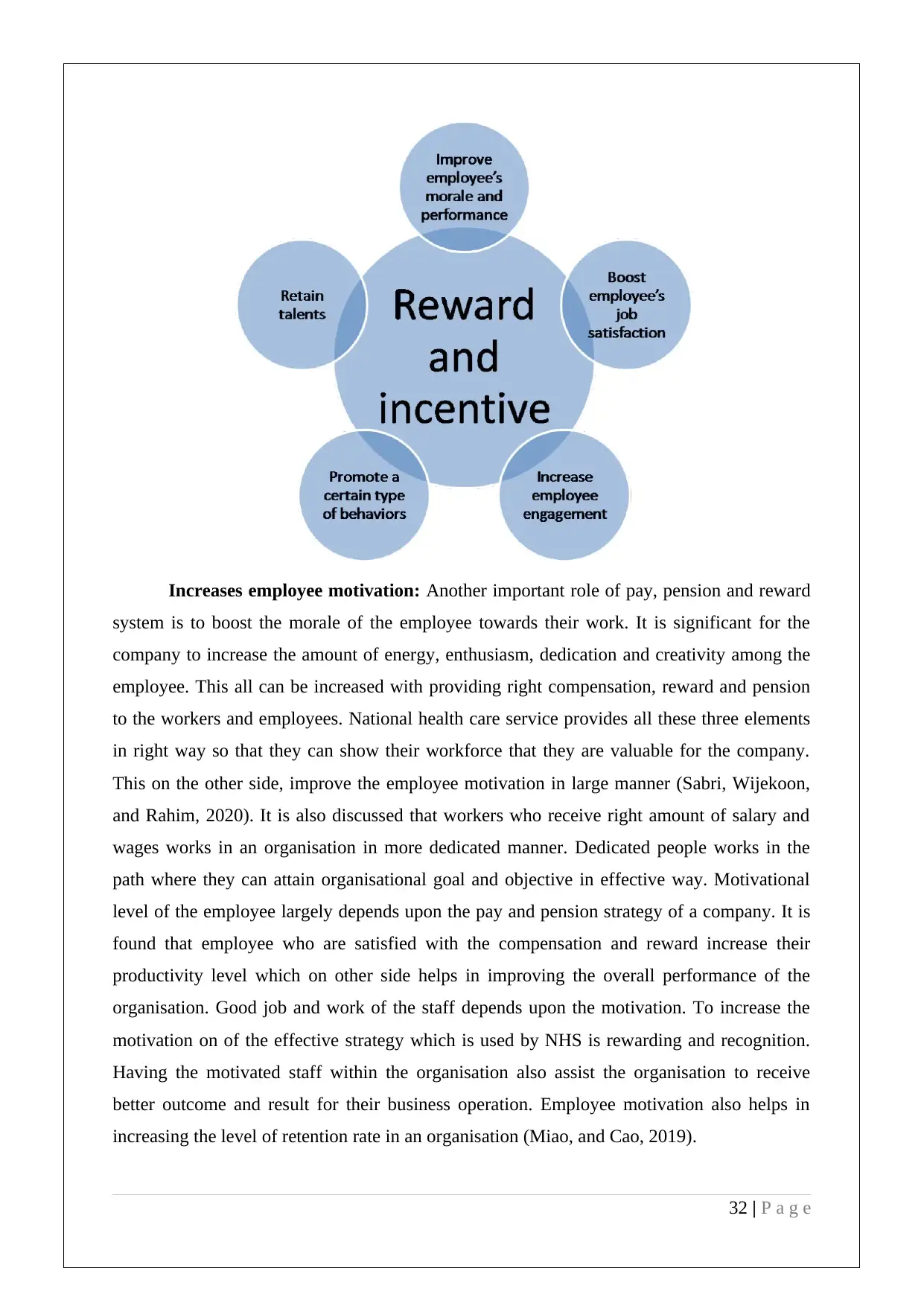
system is to boost the morale of the employee towards their work. It is significant for the
company to increase the amount of energy, enthusiasm, dedication and creativity among the
employee. This all can be increased with providing right compensation, reward and pension
to the workers and employees. National health care service provides all these three elements
in right way so that they can show their workforce that they are valuable for the company.
This on the other side, improve the employee motivation in large manner (Sabri, Wijekoon,
and Rahim, 2020). It is also discussed that workers who receive right amount of salary and
wages works in an organisation in more dedicated manner. Dedicated people works in the
path where they can attain organisational goal and objective in effective way. Motivational
level of the employee largely depends upon the pay and pension strategy of a company. It is
found that employee who are satisfied with the compensation and reward increase their
productivity level which on other side helps in improving the overall performance of the
organisation. Good job and work of the staff depends upon the motivation. To increase the
motivation on of the effective strategy which is used by NHS is rewarding and recognition.
Having the motivated staff within the organisation also assist the organisation to receive
better outcome and result for their business operation. Employee motivation also helps in
increasing the level of retention rate in an organisation (Miao, and Cao, 2019).
32 | P a g e
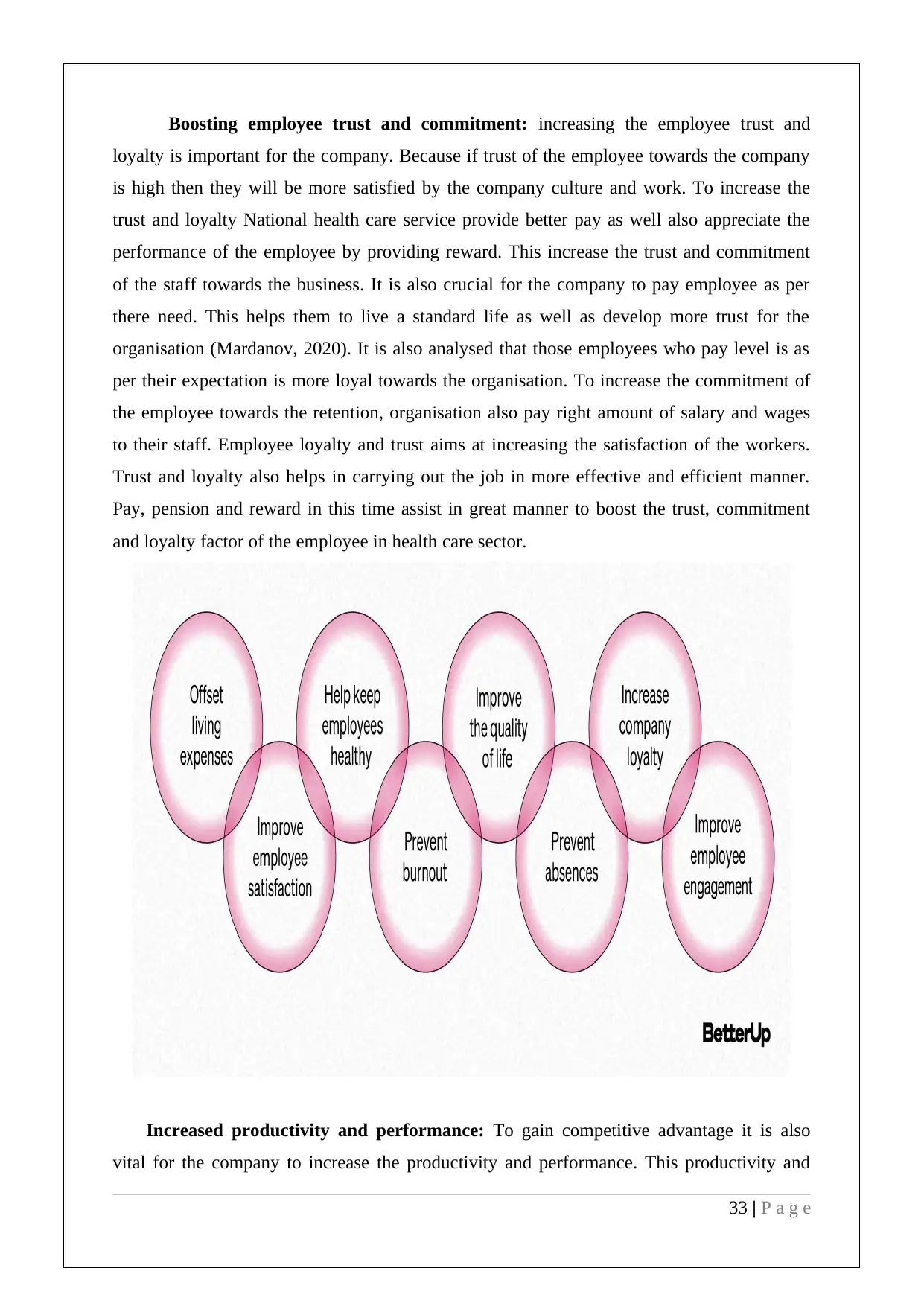
loyalty is important for the company. Because if trust of the employee towards the company
is high then they will be more satisfied by the company culture and work. To increase the
trust and loyalty National health care service provide better pay as well also appreciate the
performance of the employee by providing reward. This increase the trust and commitment
of the staff towards the business. It is also crucial for the company to pay employee as per
there need. This helps them to live a standard life as well as develop more trust for the
organisation (Mardanov, 2020). It is also analysed that those employees who pay level is as
per their expectation is more loyal towards the organisation. To increase the commitment of
the employee towards the retention, organisation also pay right amount of salary and wages
to their staff. Employee loyalty and trust aims at increasing the satisfaction of the workers.
Trust and loyalty also helps in carrying out the job in more effective and efficient manner.
Pay, pension and reward in this time assist in great manner to boost the trust, commitment
and loyalty factor of the employee in health care sector.
Increased productivity and performance: To gain competitive advantage it is also
vital for the company to increase the productivity and performance. This productivity and
33 | P a g e
⊘ This is a preview!⊘
Do you want full access?
Subscribe today to unlock all pages.

Trusted by 1+ million students worldwide

appreciating through providing rewards and by giving them the benefit of pension amount. It
is evaluated that productivity margin of the employee is directly linked with the pay level.
This production is increased by the company by showing the employee that they are one of
the valuable asset by providing them the salary and reward in effective way (Mansour, and
Tremblay, 2019). Performance and attitude of the employee is also linked with the three
elements. In NHS employee who do not receive pay, pension and reward in right way
perform their work in ineffective manner. This decrease the overall performance of both
employee and organisation. Satisfaction level of the employee is also influenced by the kind
of pay they receive. Employee who are not satisfied also work in less productive manner as
well as their overall performance is low. The main reason for NHS to have effective
productivity and performance is that they treat all employee fairly and provide them the
salary in transparent and fair manner. High productivity also helps the company to run their
business in successful manner as well also assist them to expand their business in large way.
The performance of the staff also helps the company to acquire good brand image in the
market (Gopinath, 2020).
Theme 3: Benefits gained by organisation because of satisfied employee
From the above gathered data it is analysed that there are various advantages which is
received by the organisation. It becomes very vital for the company to satisfy their employee
in large manner because this helps them to gain various benefit which improves the overall
business performance and productivity. One of the greatest advantage which is acquire by the
NHS is adopting latest business technologies in their business operation (Pinzone and et. al,
2019). As employee feel satisfied by their pay, pension and reward system this motivate them
to work in productive manner and develop their skill towards the advance technology.
Without any hesitant and restriction, they build technological skills. Satisfied employee also
carry out their given task in effective manner which help the company to attain organisational
goal and objective. Employee satisfaction also assist the NHS to run their business in smooth
and best manner. With the motivated staff company can also attract pool of talents within the
company. NHS focuses on providing the compensation, reward and pension in fair way so
that each and every staff fell valuable and contribute best in increasing the level of
productivity (Materla, Cudney and Antony, 2019). It is also seen that in NHS many of the
staff feel satisfied which is one of the benefit for the company as the retention rate of the
34 | P a g e
Paraphrase This Document
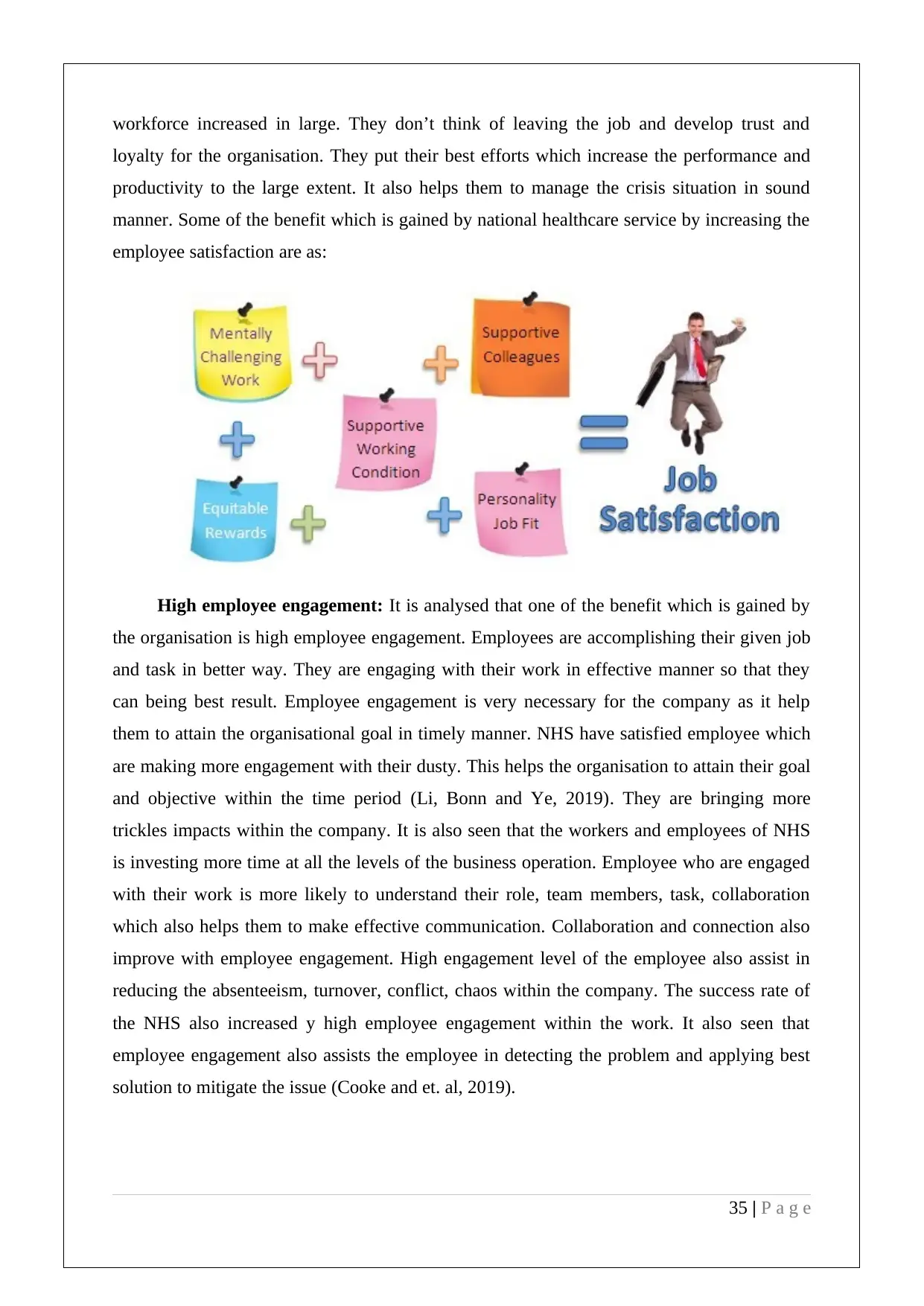
loyalty for the organisation. They put their best efforts which increase the performance and
productivity to the large extent. It also helps them to manage the crisis situation in sound
manner. Some of the benefit which is gained by national healthcare service by increasing the
employee satisfaction are as:
High employee engagement: It is analysed that one of the benefit which is gained by
the organisation is high employee engagement. Employees are accomplishing their given job
and task in better way. They are engaging with their work in effective manner so that they
can being best result. Employee engagement is very necessary for the company as it help
them to attain the organisational goal in timely manner. NHS have satisfied employee which
are making more engagement with their dusty. This helps the organisation to attain their goal
and objective within the time period (Li, Bonn and Ye, 2019). They are bringing more
trickles impacts within the company. It is also seen that the workers and employees of NHS
is investing more time at all the levels of the business operation. Employee who are engaged
with their work is more likely to understand their role, team members, task, collaboration
which also helps them to make effective communication. Collaboration and connection also
improve with employee engagement. High engagement level of the employee also assist in
reducing the absenteeism, turnover, conflict, chaos within the company. The success rate of
the NHS also increased y high employee engagement within the work. It also seen that
employee engagement also assists the employee in detecting the problem and applying best
solution to mitigate the issue (Cooke and et. al, 2019).
35 | P a g e
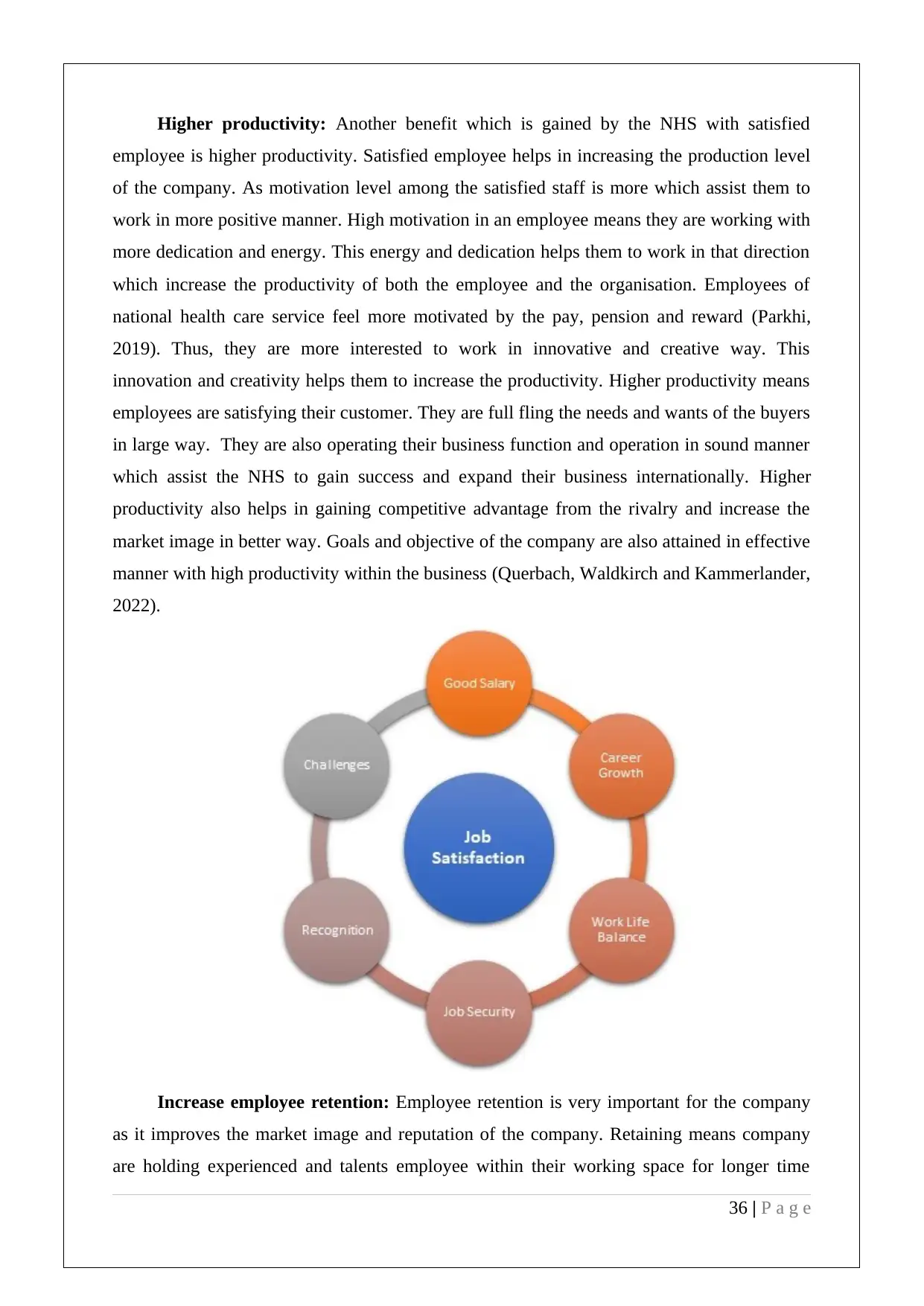
employee is higher productivity. Satisfied employee helps in increasing the production level
of the company. As motivation level among the satisfied staff is more which assist them to
work in more positive manner. High motivation in an employee means they are working with
more dedication and energy. This energy and dedication helps them to work in that direction
which increase the productivity of both the employee and the organisation. Employees of
national health care service feel more motivated by the pay, pension and reward (Parkhi,
2019). Thus, they are more interested to work in innovative and creative way. This
innovation and creativity helps them to increase the productivity. Higher productivity means
employees are satisfying their customer. They are full fling the needs and wants of the buyers
in large way. They are also operating their business function and operation in sound manner
which assist the NHS to gain success and expand their business internationally. Higher
productivity also helps in gaining competitive advantage from the rivalry and increase the
market image in better way. Goals and objective of the company are also attained in effective
manner with high productivity within the business (Querbach, Waldkirch and Kammerlander,
2022).
Increase employee retention: Employee retention is very important for the company
as it improves the market image and reputation of the company. Retaining means company
are holding experienced and talents employee within their working space for longer time
36 | P a g e
⊘ This is a preview!⊘
Do you want full access?
Subscribe today to unlock all pages.

Trusted by 1+ million students worldwide
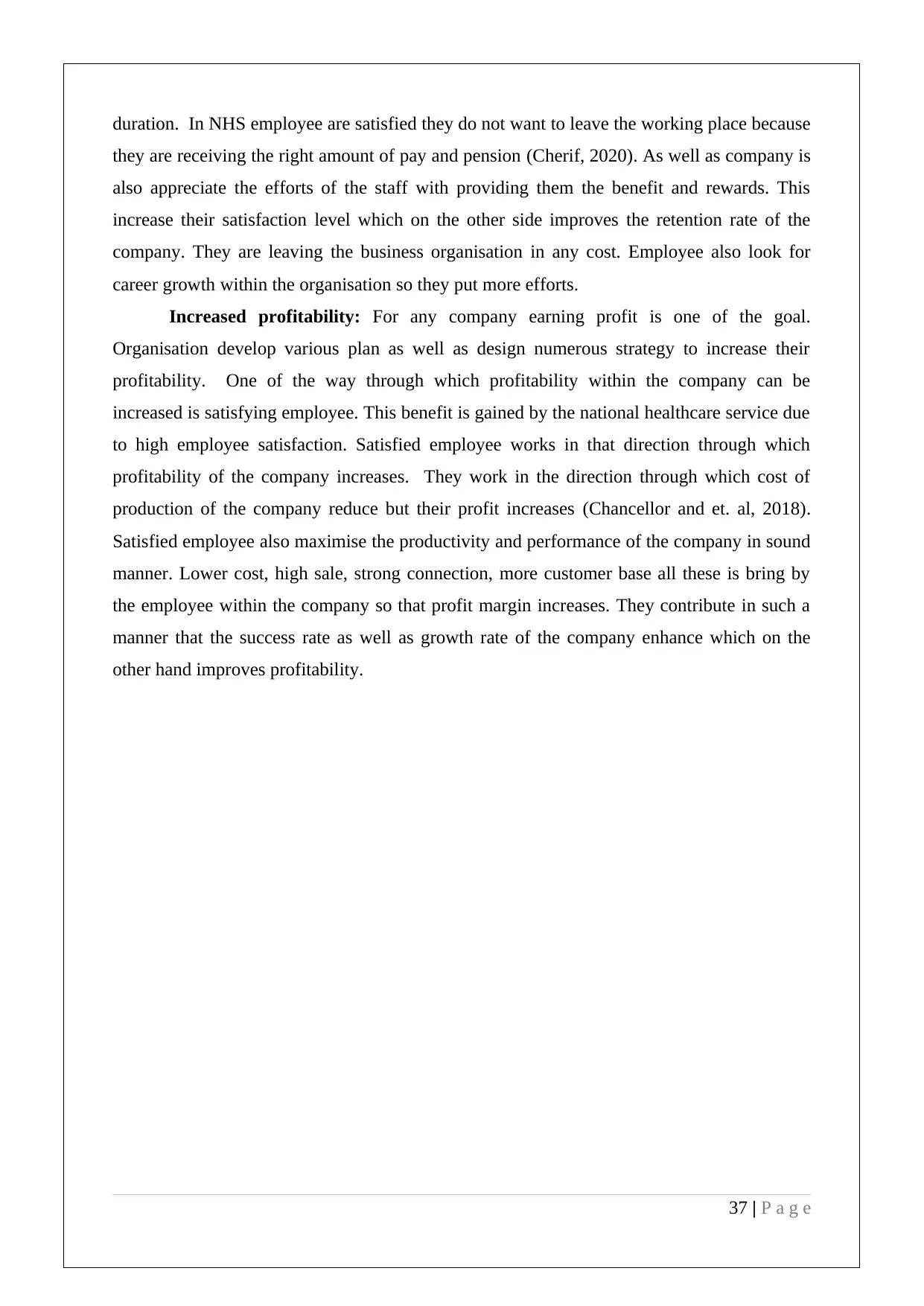
they are receiving the right amount of pay and pension (Cherif, 2020). As well as company is
also appreciate the efforts of the staff with providing them the benefit and rewards. This
increase their satisfaction level which on the other side improves the retention rate of the
company. They are leaving the business organisation in any cost. Employee also look for
career growth within the organisation so they put more efforts.
Increased profitability: For any company earning profit is one of the goal.
Organisation develop various plan as well as design numerous strategy to increase their
profitability. One of the way through which profitability within the company can be
increased is satisfying employee. This benefit is gained by the national healthcare service due
to high employee satisfaction. Satisfied employee works in that direction through which
profitability of the company increases. They work in the direction through which cost of
production of the company reduce but their profit increases (Chancellor and et. al, 2018).
Satisfied employee also maximise the productivity and performance of the company in sound
manner. Lower cost, high sale, strong connection, more customer base all these is bring by
the employee within the company so that profit margin increases. They contribute in such a
manner that the success rate as well as growth rate of the company enhance which on the
other hand improves profitability.
37 | P a g e
Paraphrase This Document

for further research
Conclusion
From the above discussion, it has been concluded that pay, pension and rewards
systems are important for improving the satisfaction of employee towards their job. Pay is
considered as the general amount which is provided to an employee for performing certain
duty or job in the organisation. It is also known as compensation which is received by the
employee monthly basis. It plays a very important role in the organisation in order to achieve
success in the market. Effective pay motivate employees to perform their task in effective
manner which help organisation to meet their aim and objectives appropriately. It provides
many other benefits to the company also such as increased productivity, improved retention
and many more. Pension is an retirement benefit for the employees in the company pay this
amount to their employee when they take retirement from the service. It is also be considered
future savings scheme for employees in which employer deduct certain amount from the
salary of their employee and they also give same contribution on it. The main reason for
doing this is to provide future benefit to the employees for contributing their time and years
and help in achieving success of the business in better manner. It helps in increasing the
living standard of employees as well as make them to act as an investment for the benefit of
their future. Providing pension fund to employees is also beneficial for the company as it
helps in increasing the employee satisfaction and attract talented employees also. Reward
system is described as monetary and non-monetary benefits which is provided by the
company to their employees in exchange of their performance and efforts that they give in
their job. Extrinsic and intrinsic are types of rewards systems which is used by the many
organisation in order to motivate employees to perform their task in better manner.
The above research states that pay, pension and reward system plays a very
significant role in boosting the satisfaction level of employees in order to make them to
perform their task in effective manner. Pay, pension and rewards system has a direct link
with the employee behaviour. This implies that when the company offer effective pay,
pension and reward systems to their employee there behaviour become positive towards the
company and give their best efforts in their performance. These are also helpful for the
company to measure the performance and productivity of their employees. Employee's
satisfaction towards the organisation and their work are totally depend on the pay, pension
and rewards are provided by the organisation to them. These are considered as an offer which
38 | P a g e
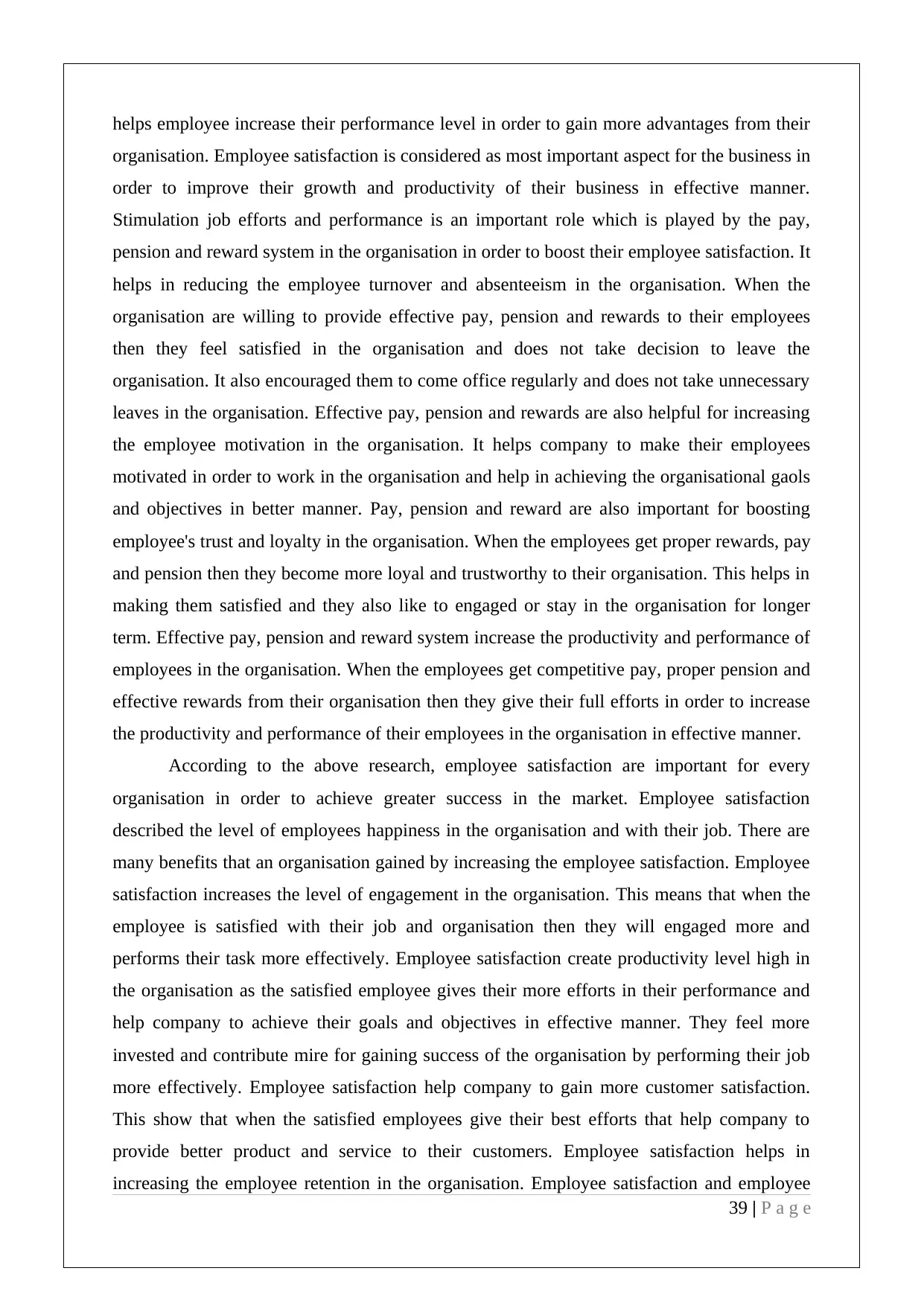
organisation. Employee satisfaction is considered as most important aspect for the business in
order to improve their growth and productivity of their business in effective manner.
Stimulation job efforts and performance is an important role which is played by the pay,
pension and reward system in the organisation in order to boost their employee satisfaction. It
helps in reducing the employee turnover and absenteeism in the organisation. When the
organisation are willing to provide effective pay, pension and rewards to their employees
then they feel satisfied in the organisation and does not take decision to leave the
organisation. It also encouraged them to come office regularly and does not take unnecessary
leaves in the organisation. Effective pay, pension and rewards are also helpful for increasing
the employee motivation in the organisation. It helps company to make their employees
motivated in order to work in the organisation and help in achieving the organisational gaols
and objectives in better manner. Pay, pension and reward are also important for boosting
employee's trust and loyalty in the organisation. When the employees get proper rewards, pay
and pension then they become more loyal and trustworthy to their organisation. This helps in
making them satisfied and they also like to engaged or stay in the organisation for longer
term. Effective pay, pension and reward system increase the productivity and performance of
employees in the organisation. When the employees get competitive pay, proper pension and
effective rewards from their organisation then they give their full efforts in order to increase
the productivity and performance of their employees in the organisation in effective manner.
According to the above research, employee satisfaction are important for every
organisation in order to achieve greater success in the market. Employee satisfaction
described the level of employees happiness in the organisation and with their job. There are
many benefits that an organisation gained by increasing the employee satisfaction. Employee
satisfaction increases the level of engagement in the organisation. This means that when the
employee is satisfied with their job and organisation then they will engaged more and
performs their task more effectively. Employee satisfaction create productivity level high in
the organisation as the satisfied employee gives their more efforts in their performance and
help company to achieve their goals and objectives in effective manner. They feel more
invested and contribute mire for gaining success of the organisation by performing their job
more effectively. Employee satisfaction help company to gain more customer satisfaction.
This show that when the satisfied employees give their best efforts that help company to
provide better product and service to their customers. Employee satisfaction helps in
increasing the employee retention in the organisation. Employee satisfaction and employee
39 | P a g e
⊘ This is a preview!⊘
Do you want full access?
Subscribe today to unlock all pages.

Trusted by 1+ million students worldwide
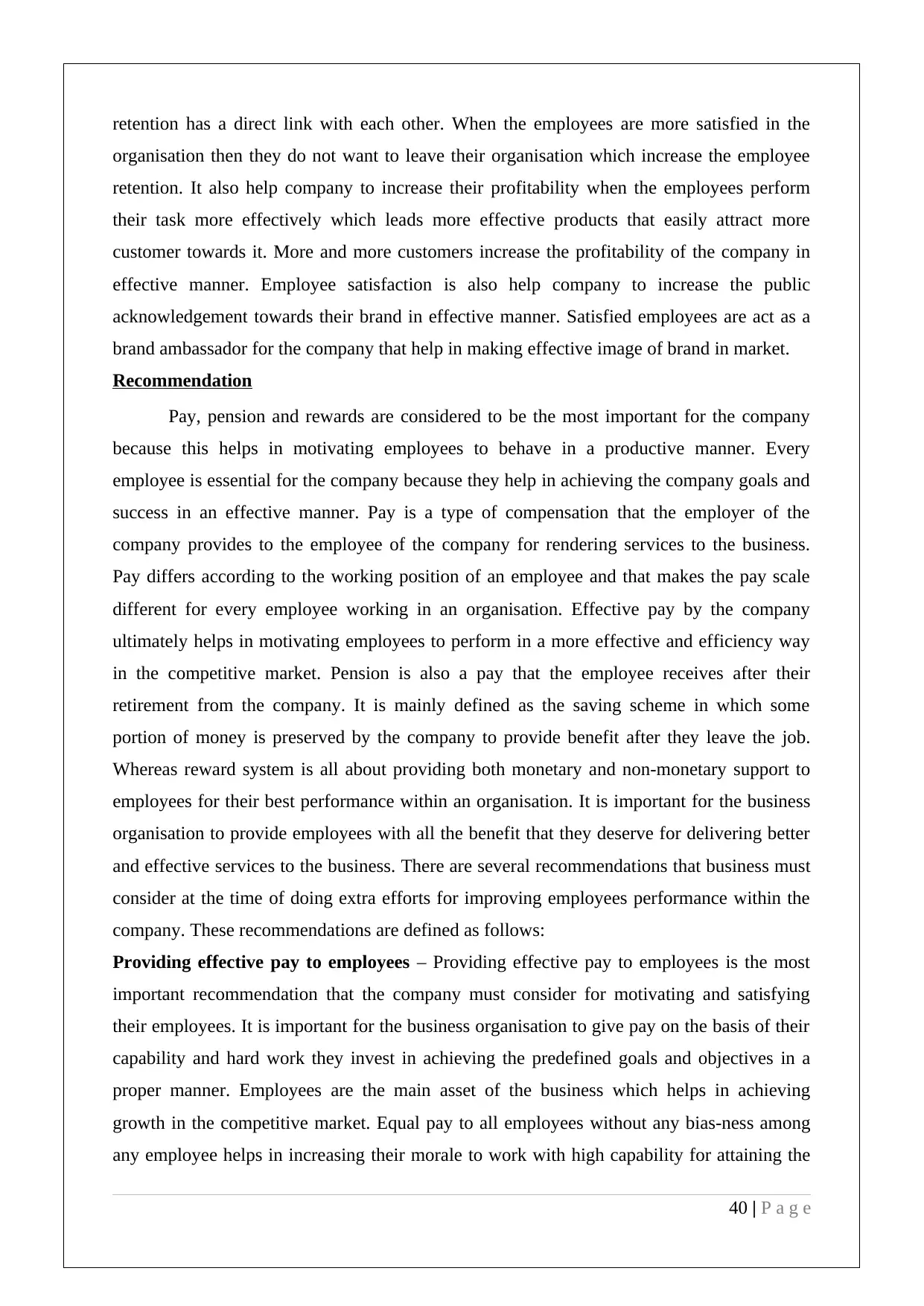
organisation then they do not want to leave their organisation which increase the employee
retention. It also help company to increase their profitability when the employees perform
their task more effectively which leads more effective products that easily attract more
customer towards it. More and more customers increase the profitability of the company in
effective manner. Employee satisfaction is also help company to increase the public
acknowledgement towards their brand in effective manner. Satisfied employees are act as a
brand ambassador for the company that help in making effective image of brand in market.
Recommendation
Pay, pension and rewards are considered to be the most important for the company
because this helps in motivating employees to behave in a productive manner. Every
employee is essential for the company because they help in achieving the company goals and
success in an effective manner. Pay is a type of compensation that the employer of the
company provides to the employee of the company for rendering services to the business.
Pay differs according to the working position of an employee and that makes the pay scale
different for every employee working in an organisation. Effective pay by the company
ultimately helps in motivating employees to perform in a more effective and efficiency way
in the competitive market. Pension is also a pay that the employee receives after their
retirement from the company. It is mainly defined as the saving scheme in which some
portion of money is preserved by the company to provide benefit after they leave the job.
Whereas reward system is all about providing both monetary and non-monetary support to
employees for their best performance within an organisation. It is important for the business
organisation to provide employees with all the benefit that they deserve for delivering better
and effective services to the business. There are several recommendations that business must
consider at the time of doing extra efforts for improving employees performance within the
company. These recommendations are defined as follows:
Providing effective pay to employees – Providing effective pay to employees is the most
important recommendation that the company must consider for motivating and satisfying
their employees. It is important for the business organisation to give pay on the basis of their
capability and hard work they invest in achieving the predefined goals and objectives in a
proper manner. Employees are the main asset of the business which helps in achieving
growth in the competitive market. Equal pay to all employees without any bias-ness among
any employee helps in increasing their morale to work with high capability for attaining the
40 | P a g e
Paraphrase This Document
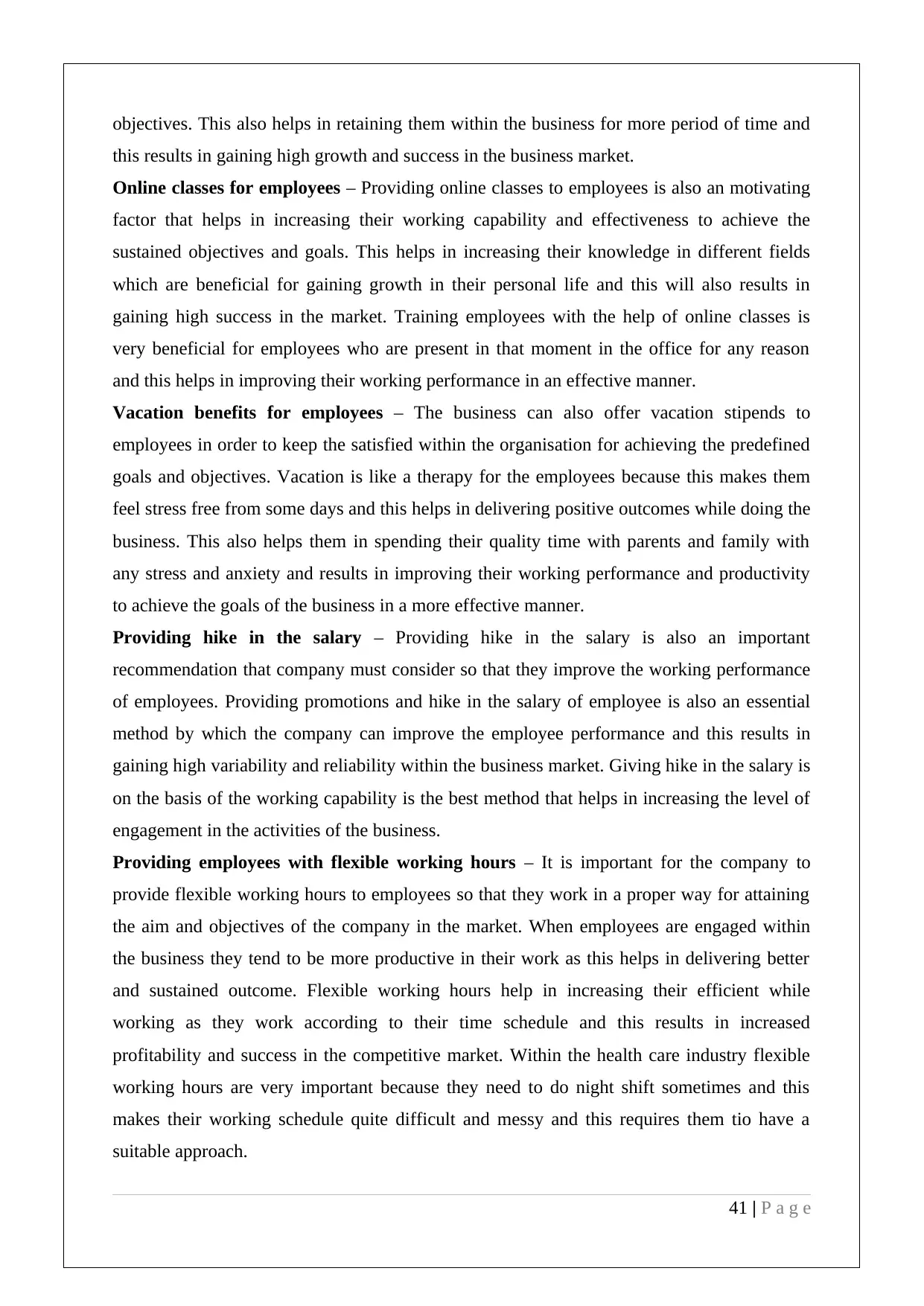
this results in gaining high growth and success in the business market.
Online classes for employees – Providing online classes to employees is also an motivating
factor that helps in increasing their working capability and effectiveness to achieve the
sustained objectives and goals. This helps in increasing their knowledge in different fields
which are beneficial for gaining growth in their personal life and this will also results in
gaining high success in the market. Training employees with the help of online classes is
very beneficial for employees who are present in that moment in the office for any reason
and this helps in improving their working performance in an effective manner.
Vacation benefits for employees – The business can also offer vacation stipends to
employees in order to keep the satisfied within the organisation for achieving the predefined
goals and objectives. Vacation is like a therapy for the employees because this makes them
feel stress free from some days and this helps in delivering positive outcomes while doing the
business. This also helps them in spending their quality time with parents and family with
any stress and anxiety and results in improving their working performance and productivity
to achieve the goals of the business in a more effective manner.
Providing hike in the salary – Providing hike in the salary is also an important
recommendation that company must consider so that they improve the working performance
of employees. Providing promotions and hike in the salary of employee is also an essential
method by which the company can improve the employee performance and this results in
gaining high variability and reliability within the business market. Giving hike in the salary is
on the basis of the working capability is the best method that helps in increasing the level of
engagement in the activities of the business.
Providing employees with flexible working hours – It is important for the company to
provide flexible working hours to employees so that they work in a proper way for attaining
the aim and objectives of the company in the market. When employees are engaged within
the business they tend to be more productive in their work as this helps in delivering better
and sustained outcome. Flexible working hours help in increasing their efficient while
working as they work according to their time schedule and this results in increased
profitability and success in the competitive market. Within the health care industry flexible
working hours are very important because they need to do night shift sometimes and this
makes their working schedule quite difficult and messy and this requires them tio have a
suitable approach.
41 | P a g e
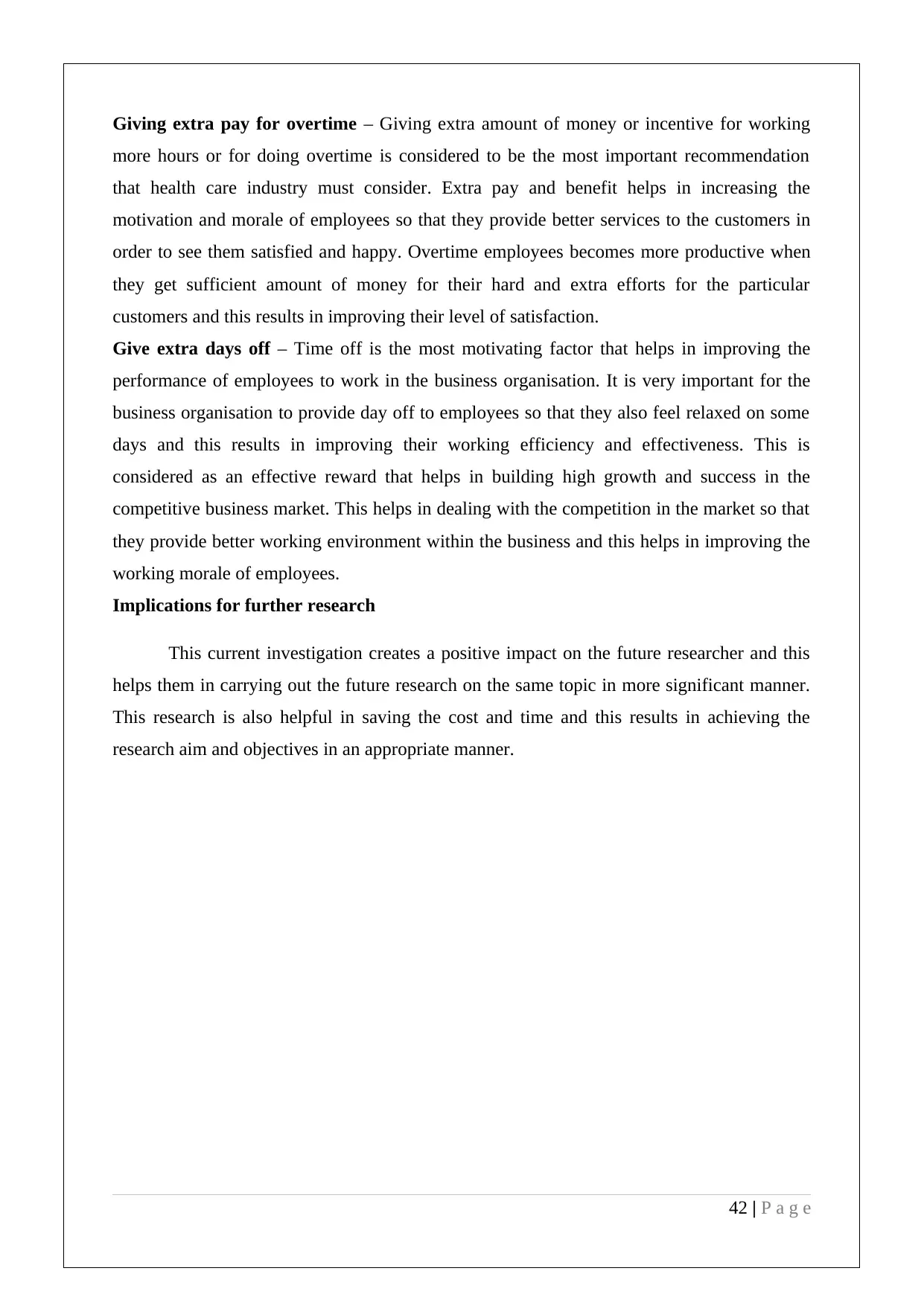
more hours or for doing overtime is considered to be the most important recommendation
that health care industry must consider. Extra pay and benefit helps in increasing the
motivation and morale of employees so that they provide better services to the customers in
order to see them satisfied and happy. Overtime employees becomes more productive when
they get sufficient amount of money for their hard and extra efforts for the particular
customers and this results in improving their level of satisfaction.
Give extra days off – Time off is the most motivating factor that helps in improving the
performance of employees to work in the business organisation. It is very important for the
business organisation to provide day off to employees so that they also feel relaxed on some
days and this results in improving their working efficiency and effectiveness. This is
considered as an effective reward that helps in building high growth and success in the
competitive business market. This helps in dealing with the competition in the market so that
they provide better working environment within the business and this helps in improving the
working morale of employees.
Implications for further research
This current investigation creates a positive impact on the future researcher and this
helps them in carrying out the future research on the same topic in more significant manner.
This research is also helpful in saving the cost and time and this results in achieving the
research aim and objectives in an appropriate manner.
42 | P a g e
⊘ This is a preview!⊘
Do you want full access?
Subscribe today to unlock all pages.

Trusted by 1+ million students worldwide

Berliana, M., Siregar, N. and Gustian, H.D., 2018. The model of job satisfaction
and employee performance. International Review of Management and
Marketing, 8(6). p.41.
Kitsios, F. and Kamariotou, M., 2021. Job satisfaction behind motivation: An
empirical study in public health workers. Heliyon. 7(4). p.e06857.
Rai, A., Ghosh, P. and Dutta, T., 2019, September. Total rewards to enhance
employees’ intention to stay: does perception of justice play any role?.
In Evidence-based HRM: a Global Forum for Empirical Scholarship.
Emerald Publishing Limited.
Yap Peng Lok, S., and et. al, 2019. The Impact of Compensation System on Pay
Satisfaction in the Banking Industry in Malaysia: A Proposed
Framework. Global Business & Management Research. 11(2).
Greene, R.J., 2018. Rewarding performance: Guiding principles; custom strategies.
Routledge.
Hur, Y., 2018. Testing Herzberg’s two-factor theory of motivation in the public
sector: is it applicable to public managers?. Public Organization
Review. 18(3). pp.329-343.
Fauser, D., and et. al, 2021. Effectiveness of medical rehabilitation in persons with
back pain–lessons learned from a German cohort study. Disability and
Rehabilitation. pp.1-9.
Deepa, R. and Baral, R., 2021. Relationship between integrated communication
effectiveness and employee-based brand equity–mediating role of
psychological contract fulfillment. Journal of Product & Brand
Management. 30(6). pp.883-897.
Bussin, M., 2018. Reward solutions to retention questions. In Psychology of
retention (pp. 395-413). Springer, Cham.
Saether, E.A., 2019. Motivational antecedents to high-tech R&D employees'
innovative work behavior: Self-determined motivation, person-
organization fit, organization support of creativity, and pay justice. The
Journal of High Technology Management Research. 30(2). p.100350.
Guppy, N. and Vincent, J., 2021. The evolution of Canadian pay equity legislation
and the social organization of public opinion. American Review of
Canadian Studies. 51(2). pp.312-329.
McGregor, J. and Davies, S.G., 2019. Achieving pay equity: Strategic mobilization
for substantive equality in Aotearoa New Zealand. Gender, Work &
Organization. 26(5). pp.619-632.
Paoline III, E.A., and et. al, 2018. The effects of the workplace on jail staff: The
issue of perceptions of pay fairness. Corrections. 3(3). pp.203-224.
Menon, K., and et. al, 2021, July. Systematic Steps Towards Concept Design of
Pay–per-X Business Models: An Exploratory Research. In IFIP
International Conference on Product Lifecycle Management (pp. 386-
397). Springer, Cham.
Olinski, M. and Szamrowski, P., 2022. Using websites to cultivate online
relationships: The application of the stewardship concept in public
benefit organizations. Journal of Nonprofit & Public Sector
Marketing. 34(2). pp.149-176.
Harder Fischer, L. and Baskerville, R., 2018. Socio-Technical Change: The
Equilibrium Paradox.
43 | P a g e
Paraphrase This Document
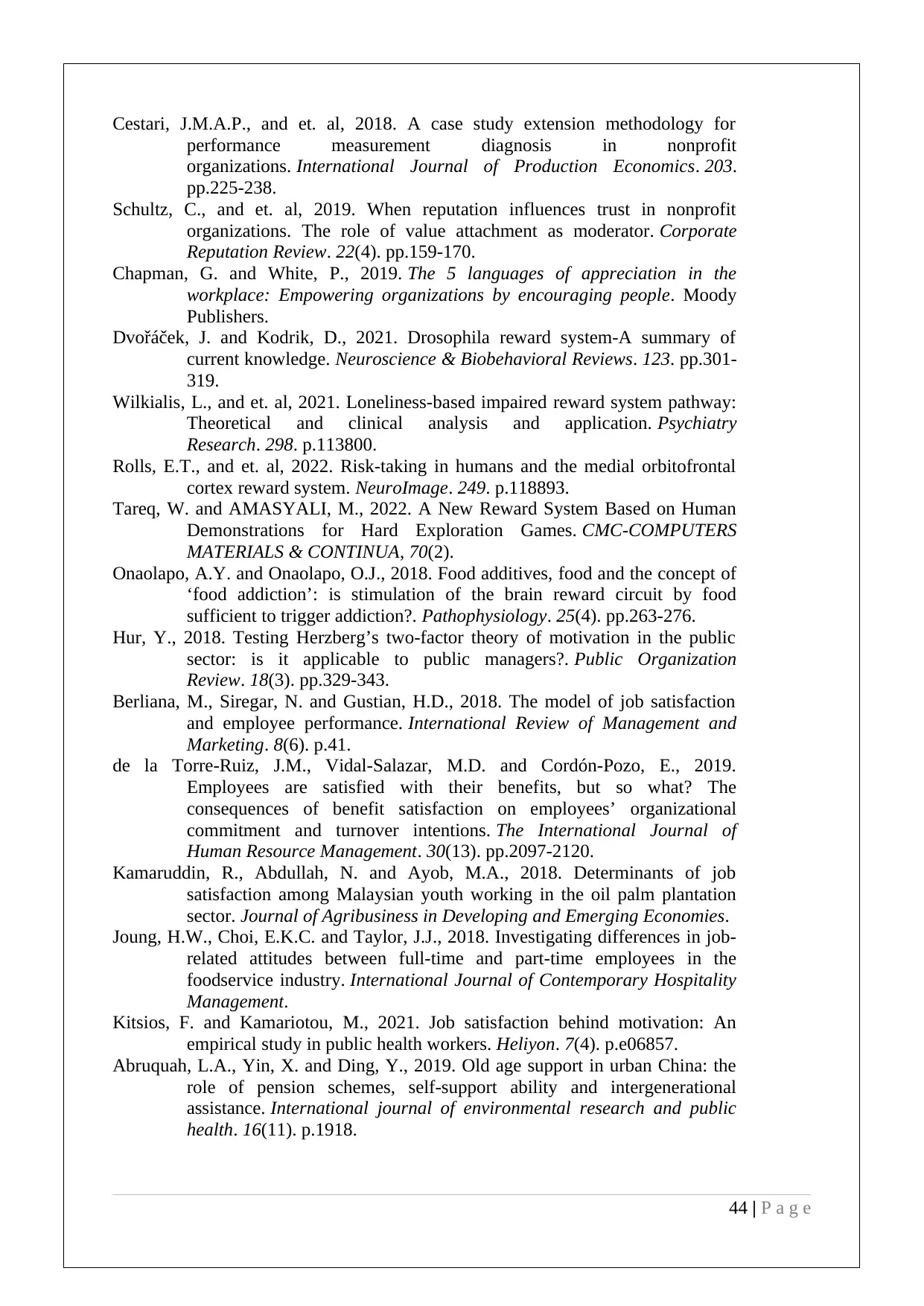
performance measurement diagnosis in nonprofit
organizations. International Journal of Production Economics. 203.
pp.225-238.
Schultz, C., and et. al, 2019. When reputation influences trust in nonprofit
organizations. The role of value attachment as moderator. Corporate
Reputation Review. 22(4). pp.159-170.
Chapman, G. and White, P., 2019. The 5 languages of appreciation in the
workplace: Empowering organizations by encouraging people. Moody
Publishers.
Dvořáček, J. and Kodrik, D., 2021. Drosophila reward system-A summary of
current knowledge. Neuroscience & Biobehavioral Reviews. 123. pp.301-
319.
Wilkialis, L., and et. al, 2021. Loneliness-based impaired reward system pathway:
Theoretical and clinical analysis and application. Psychiatry
Research. 298. p.113800.
Rolls, E.T., and et. al, 2022. Risk-taking in humans and the medial orbitofrontal
cortex reward system. NeuroImage. 249. p.118893.
Tareq, W. and AMASYALI, M., 2022. A New Reward System Based on Human
Demonstrations for Hard Exploration Games. CMC-COMPUTERS
MATERIALS & CONTINUA, 70(2).
Onaolapo, A.Y. and Onaolapo, O.J., 2018. Food additives, food and the concept of
‘food addiction’: is stimulation of the brain reward circuit by food
sufficient to trigger addiction?. Pathophysiology. 25(4). pp.263-276.
Hur, Y., 2018. Testing Herzberg’s two-factor theory of motivation in the public
sector: is it applicable to public managers?. Public Organization
Review. 18(3). pp.329-343.
Berliana, M., Siregar, N. and Gustian, H.D., 2018. The model of job satisfaction
and employee performance. International Review of Management and
Marketing. 8(6). p.41.
de la Torre-Ruiz, J.M., Vidal-Salazar, M.D. and Cordón-Pozo, E., 2019.
Employees are satisfied with their benefits, but so what? The
consequences of benefit satisfaction on employees’ organizational
commitment and turnover intentions. The International Journal of
Human Resource Management. 30(13). pp.2097-2120.
Kamaruddin, R., Abdullah, N. and Ayob, M.A., 2018. Determinants of job
satisfaction among Malaysian youth working in the oil palm plantation
sector. Journal of Agribusiness in Developing and Emerging Economies.
Joung, H.W., Choi, E.K.C. and Taylor, J.J., 2018. Investigating differences in job-
related attitudes between full-time and part-time employees in the
foodservice industry. International Journal of Contemporary Hospitality
Management.
Kitsios, F. and Kamariotou, M., 2021. Job satisfaction behind motivation: An
empirical study in public health workers. Heliyon. 7(4). p.e06857.
Abruquah, L.A., Yin, X. and Ding, Y., 2019. Old age support in urban China: the
role of pension schemes, self-support ability and intergenerational
assistance. International journal of environmental research and public
health. 16(11). p.1918.
44 | P a g e

wages and retention within the UK National Health Service: a systematic
review of the literature. BMJ open. 10(7). p.e034919.
Sorribes, J., Celma, D. and Martínez‐Garcia, E., 2021. Sustainable human
resources management in crisis contexts: Interaction of socially
responsible labour practices for the wellbeing of employees. Corporate
Social Responsibility and Environmental Management. 28(2). pp.936-
952.
Axelrad, H. and Mcnamara, T.K., 2018. Gates to retirement and gender
differences: Macroeconomic conditions, job satisfaction, and
age. Journal of women & aging. 30(6). pp.503-519.
Johnson, K.R. and Park, S., 2020. Mindfulness training for tourism and hospitality frontline
employees. Industrial and Commercial Training.
Sila, E. and Širok, K., 2018. The Importance of Employee Satisfaction: A Case Study of a
Transportation and Logistics Service Company. Management (18544223), 13(2).
Sankar, M. and Revathy, B., 2018. The Organizational Structure Influences on Employees
Satisfaction. Asian Journal of Management, 9(1), pp.569-572.
Sambaiah, C., 2019. THE JOB SATISFACTION OF EMPLOYEES WITH SPECIAL
REFERENCE TO APSPDCL At tiruPAthi. International Journal of Research in
Social Sciences, 9(2).
Paschou, T., and et.al., 2020. Digital servitization in manufacturing: A systematic literature
review and research agenda. Industrial Marketing Management, 89, pp.278-292.
Acerbi, F. and Taisch, M., 2020. A literature review on circular economy adoption in the
manufacturing sector. Journal of Cleaner Production, 273, p.123086.
Murray, J. and McDaid, D., 2020. Carer burden: the difficulties and rewards of care-giving.
In Alzheimer's Disease (pp. 71-98). CRC Press.
Simon, C., and et.al., 2020. Oxford handbook of general practice. Oxford University Press.
Norrie, C., and et.al., 2020. Skill mix: the potential for personal assistants to undertake
health‐related tasks for people with personal health budgets. Health & Social Care in
the Community, 28(3), pp.922-931
Al Dhaheri, A.S., and et. al, 2021. Impact of COVID-19 on mental health and quality of life:
Is there any effect? A cross-sectional study of the MENA region. PloS one. 16(3).
p.e0249107.
Ali, S.H., and et. al, 2020. Social media as a recruitment platform for a nationwide online
survey of COVID-19 knowledge, beliefs, and practices in the United States:
methodology and feasibility analysis. BMC medical research methodology. 20(1).
pp.1-11.
Aljaroodi, H.M., Chiong, R. and Adam, M.T., 2020. Exploring the design of avatars for
users from Arabian culture through a hybrid approach of deductive and inductive
reasoning. Computers in Human Behavior. 106. p.106246.
Barrow, J.M., Brannan, G.D. and Khandhar, P.B., 2021. Research ethics. In StatPearls
[Internet]. StatPearls Publishing.
Bauer, G.R. and Scheim, A.I., 2019. Methods for analytic intercategorical intersectionality in
quantitative research: discrimination as a mediator of health inequalities. Social
Science & Medicine. 226. pp.236-245.
45 | P a g e
⊘ This is a preview!⊘
Do you want full access?
Subscribe today to unlock all pages.

Trusted by 1+ million students worldwide
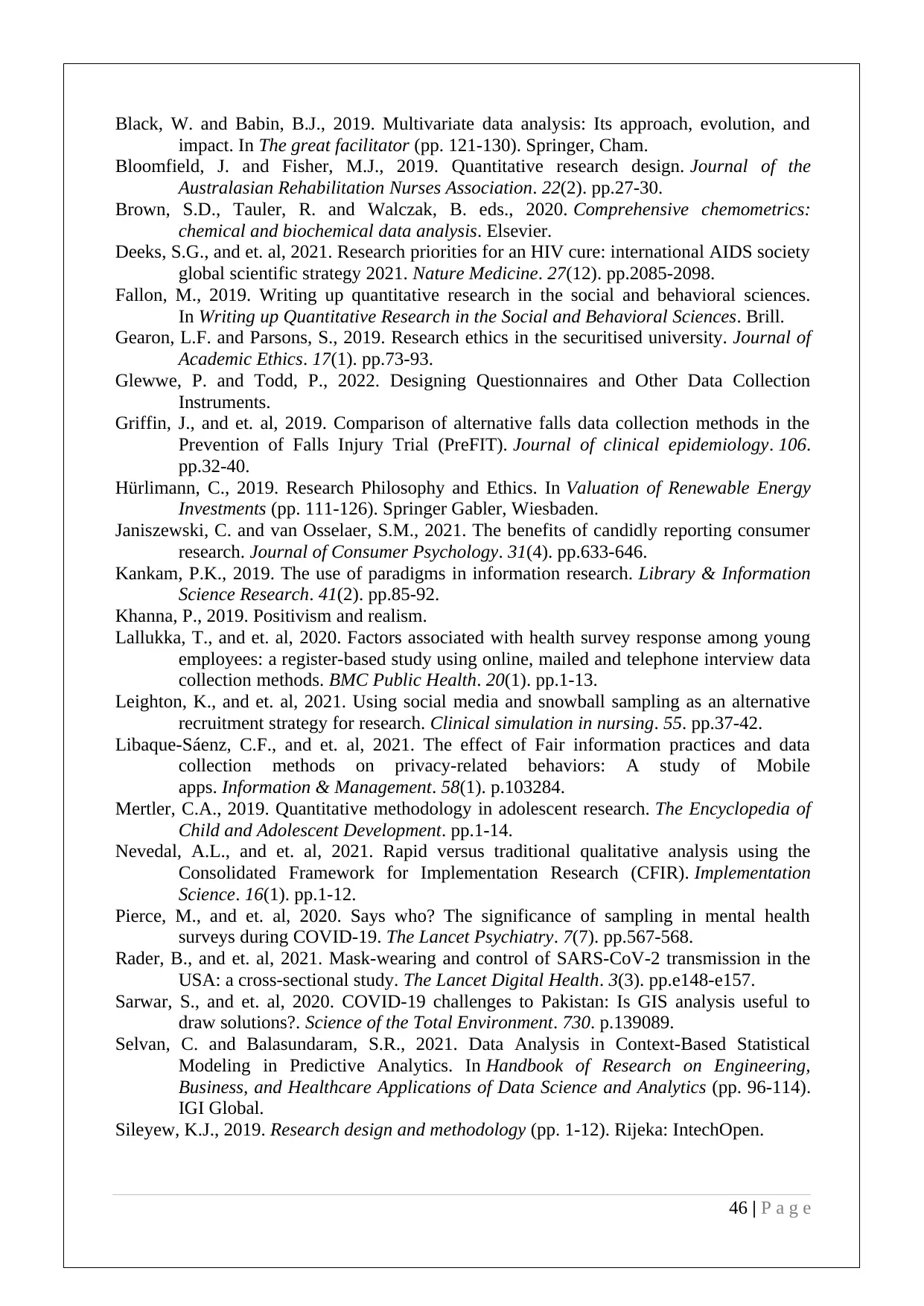
impact. In The great facilitator (pp. 121-130). Springer, Cham.
Bloomfield, J. and Fisher, M.J., 2019. Quantitative research design. Journal of the
Australasian Rehabilitation Nurses Association. 22(2). pp.27-30.
Brown, S.D., Tauler, R. and Walczak, B. eds., 2020. Comprehensive chemometrics:
chemical and biochemical data analysis. Elsevier.
Deeks, S.G., and et. al, 2021. Research priorities for an HIV cure: international AIDS society
global scientific strategy 2021. Nature Medicine. 27(12). pp.2085-2098.
Fallon, M., 2019. Writing up quantitative research in the social and behavioral sciences.
In Writing up Quantitative Research in the Social and Behavioral Sciences. Brill.
Gearon, L.F. and Parsons, S., 2019. Research ethics in the securitised university. Journal of
Academic Ethics. 17(1). pp.73-93.
Glewwe, P. and Todd, P., 2022. Designing Questionnaires and Other Data Collection
Instruments.
Griffin, J., and et. al, 2019. Comparison of alternative falls data collection methods in the
Prevention of Falls Injury Trial (PreFIT). Journal of clinical epidemiology. 106.
pp.32-40.
Hürlimann, C., 2019. Research Philosophy and Ethics. In Valuation of Renewable Energy
Investments (pp. 111-126). Springer Gabler, Wiesbaden.
Janiszewski, C. and van Osselaer, S.M., 2021. The benefits of candidly reporting consumer
research. Journal of Consumer Psychology. 31(4). pp.633-646.
Kankam, P.K., 2019. The use of paradigms in information research. Library & Information
Science Research. 41(2). pp.85-92.
Khanna, P., 2019. Positivism and realism.
Lallukka, T., and et. al, 2020. Factors associated with health survey response among young
employees: a register-based study using online, mailed and telephone interview data
collection methods. BMC Public Health. 20(1). pp.1-13.
Leighton, K., and et. al, 2021. Using social media and snowball sampling as an alternative
recruitment strategy for research. Clinical simulation in nursing. 55. pp.37-42.
Libaque-Sáenz, C.F., and et. al, 2021. The effect of Fair information practices and data
collection methods on privacy-related behaviors: A study of Mobile
apps. Information & Management. 58(1). p.103284.
Mertler, C.A., 2019. Quantitative methodology in adolescent research. The Encyclopedia of
Child and Adolescent Development. pp.1-14.
Nevedal, A.L., and et. al, 2021. Rapid versus traditional qualitative analysis using the
Consolidated Framework for Implementation Research (CFIR). Implementation
Science. 16(1). pp.1-12.
Pierce, M., and et. al, 2020. Says who? The significance of sampling in mental health
surveys during COVID-19. The Lancet Psychiatry. 7(7). pp.567-568.
Rader, B., and et. al, 2021. Mask-wearing and control of SARS-CoV-2 transmission in the
USA: a cross-sectional study. The Lancet Digital Health. 3(3). pp.e148-e157.
Sarwar, S., and et. al, 2020. COVID-19 challenges to Pakistan: Is GIS analysis useful to
draw solutions?. Science of the Total Environment. 730. p.139089.
Selvan, C. and Balasundaram, S.R., 2021. Data Analysis in Context-Based Statistical
Modeling in Predictive Analytics. In Handbook of Research on Engineering,
Business, and Healthcare Applications of Data Science and Analytics (pp. 96-114).
IGI Global.
Sileyew, K.J., 2019. Research design and methodology (pp. 1-12). Rijeka: IntechOpen.
46 | P a g e
Paraphrase This Document
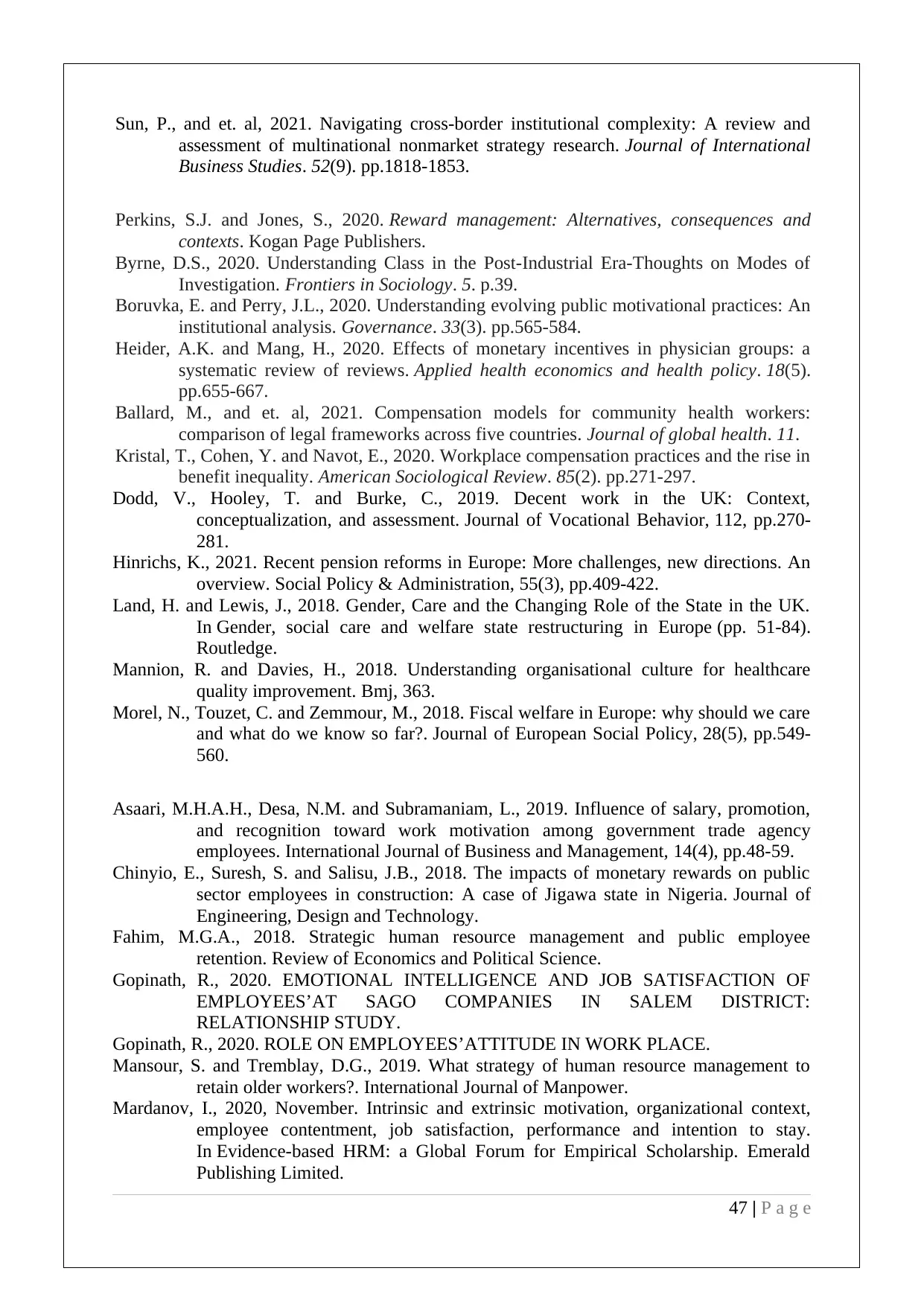
assessment of multinational nonmarket strategy research. Journal of International
Business Studies. 52(9). pp.1818-1853.
Perkins, S.J. and Jones, S., 2020. Reward management: Alternatives, consequences and
contexts. Kogan Page Publishers.
Byrne, D.S., 2020. Understanding Class in the Post-Industrial Era-Thoughts on Modes of
Investigation. Frontiers in Sociology. 5. p.39.
Boruvka, E. and Perry, J.L., 2020. Understanding evolving public motivational practices: An
institutional analysis. Governance. 33(3). pp.565-584.
Heider, A.K. and Mang, H., 2020. Effects of monetary incentives in physician groups: a
systematic review of reviews. Applied health economics and health policy. 18(5).
pp.655-667.
Ballard, M., and et. al, 2021. Compensation models for community health workers:
comparison of legal frameworks across five countries. Journal of global health. 11.
Kristal, T., Cohen, Y. and Navot, E., 2020. Workplace compensation practices and the rise in
benefit inequality. American Sociological Review. 85(2). pp.271-297.
Dodd, V., Hooley, T. and Burke, C., 2019. Decent work in the UK: Context,
conceptualization, and assessment. Journal of Vocational Behavior, 112, pp.270-
281.
Hinrichs, K., 2021. Recent pension reforms in Europe: More challenges, new directions. An
overview. Social Policy & Administration, 55(3), pp.409-422.
Land, H. and Lewis, J., 2018. Gender, Care and the Changing Role of the State in the UK.
In Gender, social care and welfare state restructuring in Europe (pp. 51-84).
Routledge.
Mannion, R. and Davies, H., 2018. Understanding organisational culture for healthcare
quality improvement. Bmj, 363.
Morel, N., Touzet, C. and Zemmour, M., 2018. Fiscal welfare in Europe: why should we care
and what do we know so far?. Journal of European Social Policy, 28(5), pp.549-
560.
Asaari, M.H.A.H., Desa, N.M. and Subramaniam, L., 2019. Influence of salary, promotion,
and recognition toward work motivation among government trade agency
employees. International Journal of Business and Management, 14(4), pp.48-59.
Chinyio, E., Suresh, S. and Salisu, J.B., 2018. The impacts of monetary rewards on public
sector employees in construction: A case of Jigawa state in Nigeria. Journal of
Engineering, Design and Technology.
Fahim, M.G.A., 2018. Strategic human resource management and public employee
retention. Review of Economics and Political Science.
Gopinath, R., 2020. EMOTIONAL INTELLIGENCE AND JOB SATISFACTION OF
EMPLOYEES’AT SAGO COMPANIES IN SALEM DISTRICT:
RELATIONSHIP STUDY.
Gopinath, R., 2020. ROLE ON EMPLOYEES’ATTITUDE IN WORK PLACE.
Mansour, S. and Tremblay, D.G., 2019. What strategy of human resource management to
retain older workers?. International Journal of Manpower.
Mardanov, I., 2020, November. Intrinsic and extrinsic motivation, organizational context,
employee contentment, job satisfaction, performance and intention to stay.
In Evidence-based HRM: a Global Forum for Empirical Scholarship. Emerald
Publishing Limited.
47 | P a g e
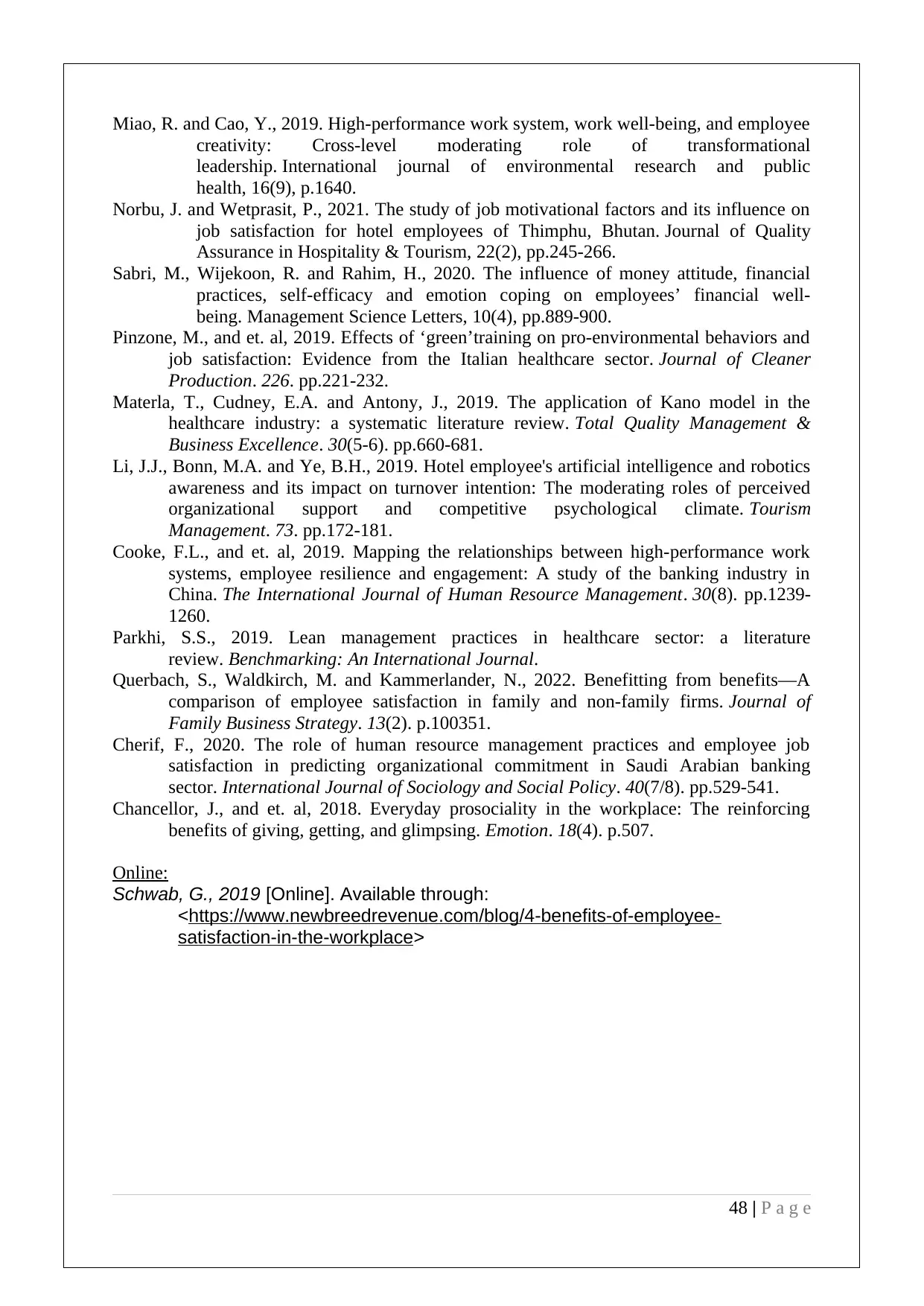
creativity: Cross-level moderating role of transformational
leadership. International journal of environmental research and public
health, 16(9), p.1640.
Norbu, J. and Wetprasit, P., 2021. The study of job motivational factors and its influence on
job satisfaction for hotel employees of Thimphu, Bhutan. Journal of Quality
Assurance in Hospitality & Tourism, 22(2), pp.245-266.
Sabri, M., Wijekoon, R. and Rahim, H., 2020. The influence of money attitude, financial
practices, self-efficacy and emotion coping on employees’ financial well-
being. Management Science Letters, 10(4), pp.889-900.
Pinzone, M., and et. al, 2019. Effects of ‘green’training on pro-environmental behaviors and
job satisfaction: Evidence from the Italian healthcare sector. Journal of Cleaner
Production. 226. pp.221-232.
Materla, T., Cudney, E.A. and Antony, J., 2019. The application of Kano model in the
healthcare industry: a systematic literature review. Total Quality Management &
Business Excellence. 30(5-6). pp.660-681.
Li, J.J., Bonn, M.A. and Ye, B.H., 2019. Hotel employee's artificial intelligence and robotics
awareness and its impact on turnover intention: The moderating roles of perceived
organizational support and competitive psychological climate. Tourism
Management. 73. pp.172-181.
Cooke, F.L., and et. al, 2019. Mapping the relationships between high-performance work
systems, employee resilience and engagement: A study of the banking industry in
China. The International Journal of Human Resource Management. 30(8). pp.1239-
1260.
Parkhi, S.S., 2019. Lean management practices in healthcare sector: a literature
review. Benchmarking: An International Journal.
Querbach, S., Waldkirch, M. and Kammerlander, N., 2022. Benefitting from benefits—A
comparison of employee satisfaction in family and non-family firms. Journal of
Family Business Strategy. 13(2). p.100351.
Cherif, F., 2020. The role of human resource management practices and employee job
satisfaction in predicting organizational commitment in Saudi Arabian banking
sector. International Journal of Sociology and Social Policy. 40(7/8). pp.529-541.
Chancellor, J., and et. al, 2018. Everyday prosociality in the workplace: The reinforcing
benefits of giving, getting, and glimpsing. Emotion. 18(4). p.507.
Online:
Schwab, G., 2019 [Online]. Available through:
<https://www.newbreedrevenue.com/blog/4-benefits-of-employee-
satisfaction-in-the-workplace>
48 | P a g e
⊘ This is a preview!⊘
Do you want full access?
Subscribe today to unlock all pages.

Trusted by 1+ million students worldwide

15000
49 | P a g e
Related Documents
Your All-in-One AI-Powered Toolkit for Academic Success.
+13062052269
info@desklib.com
Available 24*7 on WhatsApp / Email
![[object Object]](/_next/static/media/star-bottom.7253800d.svg)
© 2024 | Zucol Services PVT LTD | All rights reserved.





